Introduction
“When I take photographs, it is not I who photograph, it is something in me that presses the shutter without my really deciding.”
—Pierre Verger (1902–1996)
The goal of this article is to investigate the beginning of the history of photography in Vietnam, from the mid-nineteenth-century birth of photographic technologies and their popularization in Europe (particularly France), through their spread to Indochina by pioneering French photographers who worked or established businesses in Vietnam’s southern, central, and northern regions (then termed Cochinchina, Annam, and Tonkin, respectively), to the early decades of the twentieth century, when Vietnamese photographers began to appear.
Since the first photograph was taken in France, by the inventor Joseph Nicéphore Niépce in 1826, photographic technology has experienced many interesting periods of development. Through the efforts and desires of photographers from the first period to today, we have retained a great deal of material valuable not only for histories of technology but also—and greatly—for those of culture and society.
It was French, Swiss, Belgian, Dutch, Chinese, Vietnamese, and Algerians who comprised the majority of these professionals, earning their livelihoods by their new skills, largely through studios for photography and photographic processing in Saigon. One could mention Émile Gsell and his famous images of Cambodia and the southern and northern regions of Vietnam in the 1860s and 1870s, taken on an official expedition to Angkor, the Mekong, and the southern and northern regions of Vietnam in the first days of the French, and Pun Lun (繽綸, Tân Luân), a Chinese from Hong Kong with a photo studio in Saigon, with his extremely rare images of the area in the 1860s, 1870s, and 1880s. There were Aurelian Pestel’s images of Saigon at the end of the nineteenth century and the work of Khánh Ký (Nguyễn Ðình Khánh) in the 1920s and 1930s, showing Vietnamese revolutionaries such as Phan Châu Trinh, Nguyễn An Ninh, and Nguyễn Ái Quốc,[2] as well as French president Raymond Poincaré (1913), Governor General Pierre Pasquier, and other officials featured in the pictorial Illustration (l’Illustration) (1933).[3]
We also cannot forget to note the famous Swiss photographer Martin Hürlimann, who stopped in Vietnam in 1926 and shot images full of artistry: temples and shrines, statuary and scenery of Champa in the central region and Hanoi in the northern.
Their photographs from the mid-nineteenth to mid-twentieth centuries are endlessly precious materials for many topics in the study of history and society in Vietnam. At present, we have not yet been able to make full use of all the images that existed or still exist in archives or private collections.
As one often says in English, “A picture is worth a thousand words.” Images live in the life of society. Their daily scenes, personal residences, larger architectural works, and other subjects of times past are a basis from which it is possible to supplement much information in studies of social culture.
Also with the history of photography comes the history of cinema. The first film shot in Vietnam was “Namo Village—Panorama Taken from a Rickshaw” (Le Village de Namo—Panorama pris d’une chaise à porteurs), by the brothers Auguste and Louis Lumière, in the village of Namo (Nam Ô) near Danang in 1896, soon after their invention of the movie camera, in 1895. Earlier they had assisted their father in the art of photography, subsequently discovering a way to run film continuously through a camera. Upon their development of the movie camera, Auguste and Louis Lumière were sent to make films all over the world, bringing back interesting views of unfamiliar places in foreign countries (that is to say, the colonies) for lecturers in France.[4] It is not the intention of this article to delve deeply into the history of film, however, but mainly that of photography, thereby touching on cinematic history in Vietnam through the following study.
“When I take photographs, it is not I who photograph, it is something in me that presses the shutter without my really deciding.”
—Pierre Verger (1902–1996)
Since the first photograph was taken in France, by the inventor Joseph Nicéphore Niépce in 1826, photographic technology has experienced many interesting periods of development. Through the efforts and desires of photographers from the first period to today, we have retained a great deal of material valuable not only for histories of technology but also—and greatly—for those of culture and society.
On the History of Photographic Technologies and Photographs in Vietnam
Photographic technologies from the nineteenth to the start of the twentieth century may be summarized as follows:
Daguerreotype
In 1837, Louis Daguerre discovered a method of capturing images on a metal plate previously covered with a “film” of silver iodine or silver chloride. The image “shot” then was immersed in mercury fumes, causing mercury to gather on the parts of the image where light had reacted with the compounds, bringing out the silver on the metal surface. The intensity of the reaction depended on the strength of the light that had struck the surface of the film. The parts that retained the chemicals were fixed in sodium thiosulfate.
In 1839, the French government announced Daguerre’s photographic method as though it was a gift to humanity. The images on the metal plate were protected by glass on the surface, fitted into a frame of wood or gold. Because of the silver, this reflected like a mirror when tilted at various angles. Photographs using the daguerreotype method are very durable. If the protective frame and glazing are not damaged, they last quite a while.
In the subsequent period, not a few cameras recorded familiar images of events in France. Cameras still surprised many in Paris, however, provoking various impressions in—and awakening the curiosity of the masses as images were brought back from faraway lands—countries with customs and cultures strange to them, by photographers who used the camera’s daguerreotype technology through great efforts in their travels.[5]
The engineer Hippolyte Gaucheraud wrote the following in a newspaper, one day before Daguerre announced his discovery in front of the French Academy of Sciences, on January 7, 1839, on the future of daguerreotype photography: “It will not be long before our traveling friends, at a price of only a few hundred francs, will be able to have cameras of Daguerre’s invention, and with these machines will be able to bring images back to France, of monuments, statues, rare scenes of great beauty, or the most beautiful views in the world. All will understand that their pencils and erasers cannot create images like those that the machine of daguerreotype technology is bringing.”[6]
Gaucheraud’s predictions came true. Before a full year had passed, travelers had brought Daguerre’s invention to the wonders of France as well as far, foreign lands. Despite difficulties with cumbersome equipment, problems with the supply of metal plates and the understanding and adjustment of Daguerre’s technology in light-rich places (where land meets ocean or the hot climate of the Egyptian desert) or with the dearth of chemicals in ports like those of the Far East—still the copper plate images that they were able to bring back to France are precious and rare, allowing us glimpses of lives and events around the world in the mid-nineteenth century.
The first, exceedingly rare photographs in Vietnam and Indochina were taken according to Daguerre’s method. The French photographer Alphonse Jules Itier accompanied the mission of Théodore de Lagrené on a route through China to photograph the signing of a treaty between France and China in 1844, stopping at Danang to preserve an image of Vietnamese soldiers.
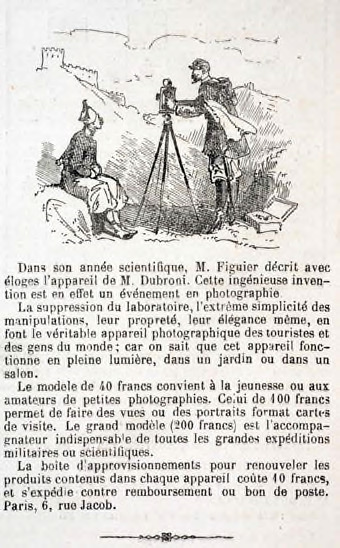 Fig. 1. Advertisement for Dubroni cameras, around 1866 (taken from Le Monde Illustré no. 462 - 17/02/1866).[7]
Fig. 1. Advertisement for Dubroni cameras, around 1866 (taken from Le Monde Illustré no. 462 - 17/02/1866).[7]
In 1837, Louis Daguerre discovered a method of capturing images on a metal plate previously covered with a “film” of silver iodine or silver chloride. The image “shot” then was immersed in mercury fumes, causing mercury to gather on the parts of the image where light had reacted with the compounds, bringing out the silver on the metal surface. The intensity of the reaction depended on the strength of the light that had struck the surface of the film. The parts that retained the chemicals were fixed in sodium thiosulfate.
In 1839, the French government announced Daguerre’s photographic method as though it was a gift to humanity. The images on the metal plate were protected by glass on the surface, fitted into a frame of wood or gold. Because of the silver, this reflected like a mirror when tilted at various angles. Photographs using the daguerreotype method are very durable. If the protective frame and glazing are not damaged, they last quite a while.
In the subsequent period, not a few cameras recorded familiar images of events in France. Cameras still surprised many in Paris, however, provoking various impressions in—and awakening the curiosity of the masses as images were brought back from faraway lands—countries with customs and cultures strange to them, by photographers who used the camera’s daguerreotype technology through great efforts in their travels.[5]
The engineer Hippolyte Gaucheraud wrote the following in a newspaper, one day before Daguerre announced his discovery in front of the French Academy of Sciences, on January 7, 1839, on the future of daguerreotype photography: “It will not be long before our traveling friends, at a price of only a few hundred francs, will be able to have cameras of Daguerre’s invention, and with these machines will be able to bring images back to France, of monuments, statues, rare scenes of great beauty, or the most beautiful views in the world. All will understand that their pencils and erasers cannot create images like those that the machine of daguerreotype technology is bringing.”[6]
Gaucheraud’s predictions came true. Before a full year had passed, travelers had brought Daguerre’s invention to the wonders of France as well as far, foreign lands. Despite difficulties with cumbersome equipment, problems with the supply of metal plates and the understanding and adjustment of Daguerre’s technology in light-rich places (where land meets ocean or the hot climate of the Egyptian desert) or with the dearth of chemicals in ports like those of the Far East—still the copper plate images that they were able to bring back to France are precious and rare, allowing us glimpses of lives and events around the world in the mid-nineteenth century.
The first, exceedingly rare photographs in Vietnam and Indochina were taken according to Daguerre’s method. The French photographer Alphonse Jules Itier accompanied the mission of Théodore de Lagrené on a route through China to photograph the signing of a treaty between France and China in 1844, stopping at Danang to preserve an image of Vietnamese soldiers.
 Fig. 1. Advertisement for Dubroni cameras, around 1866 (taken from Le Monde Illustré no. 462 - 17/02/1866).[7]
Fig. 1. Advertisement for Dubroni cameras, around 1866 (taken from Le Monde Illustré no. 462 - 17/02/1866).[7]Ambrotype
This was a method using the chemical solution “collodion” spread on glass. It was invented in England and gradually replaced the daguerreotype, as it was much more practical. Its rate of reaction and exposure time was also much faster. In France, this method was called the “collodion positive” (Collodion Positif). The ambrotype process expanded fiercely from 1855 to 1865. The daguerreotype was no longer commonly used by around the 1860s.
In many places, such as France, the ambrotype method was still used through the 1880s, near the end of the nineteenth century, before it was replaced completely by the tintype on iron and new technologies on film and paper.
In 1851, Frederick Scott Archer discovered a method of making images through the “wet plate” process, sometimes called the “collodion process” after the name of the solution used on glass plates. The solution was bromide and iodine or chloride (halogen gas) dissolved into collodion (a solution of pyroxylin in alcohol or ether). This solution then was processed onto a glass surface where, partially set but still wet, it was dipped into a solution of silver nitrate. The iodine and bromide on the glass would react with the silver nitrate, resulting in the compound silver iodide or silver bromide, which could capture an image on the glass.
When the reaction was complete, the glass was taken out of the silver nitrate solution and placed in the camera to be exposed while wet. When light shone on the glass containing silver iodide, the silver accumulated and darkened according to the intensity of the light. The degrees of darkness (the silver) would distinguish themselves. As the glass surface would lose its rate of reaction if the silver iodide solution dried, it was necessary to work with ever more speed and skill. After taking an image on the glass, the still-wet plate was rinsed in a solution of iron sulfate, acetic acid, and alcohol. Because of this, photographers had to bring along chemical solutions in order to make preparations for before and after shooting.
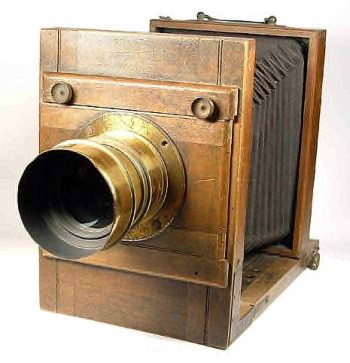 Fig. 2. Chambre de voyage, ambrotype camera by Darlot, around 1885.[8]
Fig. 2. Chambre de voyage, ambrotype camera by Darlot, around 1885.[8]
This was a method using the chemical solution “collodion” spread on glass. It was invented in England and gradually replaced the daguerreotype, as it was much more practical. Its rate of reaction and exposure time was also much faster. In France, this method was called the “collodion positive” (Collodion Positif). The ambrotype process expanded fiercely from 1855 to 1865. The daguerreotype was no longer commonly used by around the 1860s.
In many places, such as France, the ambrotype method was still used through the 1880s, near the end of the nineteenth century, before it was replaced completely by the tintype on iron and new technologies on film and paper.
In 1851, Frederick Scott Archer discovered a method of making images through the “wet plate” process, sometimes called the “collodion process” after the name of the solution used on glass plates. The solution was bromide and iodine or chloride (halogen gas) dissolved into collodion (a solution of pyroxylin in alcohol or ether). This solution then was processed onto a glass surface where, partially set but still wet, it was dipped into a solution of silver nitrate. The iodine and bromide on the glass would react with the silver nitrate, resulting in the compound silver iodide or silver bromide, which could capture an image on the glass.
When the reaction was complete, the glass was taken out of the silver nitrate solution and placed in the camera to be exposed while wet. When light shone on the glass containing silver iodide, the silver accumulated and darkened according to the intensity of the light. The degrees of darkness (the silver) would distinguish themselves. As the glass surface would lose its rate of reaction if the silver iodide solution dried, it was necessary to work with ever more speed and skill. After taking an image on the glass, the still-wet plate was rinsed in a solution of iron sulfate, acetic acid, and alcohol. Because of this, photographers had to bring along chemical solutions in order to make preparations for before and after shooting.
 Fig. 2. Chambre de voyage, ambrotype camera by Darlot, around 1885.[8]
Fig. 2. Chambre de voyage, ambrotype camera by Darlot, around 1885.[8]Calotype (or Talbotype)
At about the same time as the daguerreotype came the technology to shoot and process pictures on paper, called the calotype, invented by William Fox Talbot. The calotype process, although its images were not clear compared to the resolution of daguerreotypes, had a particularly important advantage: from one unique paper negative could be processed tens or hundreds of identical photographs. Because these were on paper, it was easy for artists to combine them with the art of painting. The photographs were easy to paste in albums, frame like paintings or insert in printed books. Thus, at the start of the 1850s, the paper calotype began to replace the daguerreotype. Although the daguerreotype was present in America longer, in France it had all but disappeared by the start of the 1860s. The calotype with its paper negative was very popular and used most by travelers.
The ambrotype used glass to make clearer images than the calotype could on paper. Both used negatives from which many images were developed. It is possible to see the ambrotype as the best combination of the daguerreotype’s clarity and high resolution with the calotype’s ease in producing and enlarging images from negatives.
In the 1850s, there were two schools of thought. One supported the ambrotype and one the calotype. Both were widespread, as the daguerreotype was disappearing gradually around 1860. The glass-using ambrotype was popular for portraits because of its clarity and sufficient speed, whereas the calotype with its paper negatives was much used by artists or travelers for its convenience. In truth, the ambrotype was used more than the calotype in the 1860s.
The popularity of photography was supported and further urged by the founding of the world’s first photography association in Paris, in 1851. This was the Helographic Society (Société Héliographique, later the French Society for Photography, Société Française de Photographie, SFP, which still exists today). This organization produced exhibitions of photographs and photographic technology, newsletters, books, and magazines, such as the periodical Illumination (Lumière). Its members were from all across France as well as other European countries.
At about the same time as the daguerreotype came the technology to shoot and process pictures on paper, called the calotype, invented by William Fox Talbot. The calotype process, although its images were not clear compared to the resolution of daguerreotypes, had a particularly important advantage: from one unique paper negative could be processed tens or hundreds of identical photographs. Because these were on paper, it was easy for artists to combine them with the art of painting. The photographs were easy to paste in albums, frame like paintings or insert in printed books. Thus, at the start of the 1850s, the paper calotype began to replace the daguerreotype. Although the daguerreotype was present in America longer, in France it had all but disappeared by the start of the 1860s. The calotype with its paper negative was very popular and used most by travelers.
The ambrotype used glass to make clearer images than the calotype could on paper. Both used negatives from which many images were developed. It is possible to see the ambrotype as the best combination of the daguerreotype’s clarity and high resolution with the calotype’s ease in producing and enlarging images from negatives.
In the 1850s, there were two schools of thought. One supported the ambrotype and one the calotype. Both were widespread, as the daguerreotype was disappearing gradually around 1860. The glass-using ambrotype was popular for portraits because of its clarity and sufficient speed, whereas the calotype with its paper negatives was much used by artists or travelers for its convenience. In truth, the ambrotype was used more than the calotype in the 1860s.
The popularity of photography was supported and further urged by the founding of the world’s first photography association in Paris, in 1851. This was the Helographic Society (Société Héliographique, later the French Society for Photography, Société Française de Photographie, SFP, which still exists today). This organization produced exhibitions of photographs and photographic technology, newsletters, books, and magazines, such as the periodical Illumination (Lumière). Its members were from all across France as well as other European countries.
Examples of Ambrotypes and Calotypes
After the extremely rare daguerreotypes, photographs in Vietnam used the ambrotype process (on glass) and the calotype (on paper). The first portrait of a Vietnamese was that of Phan Thanh Giản, taken in Paris with the ambrotype process, when he led a delegation to France in 1863, hoping to regain the three Vietnamese provinces previously ceded to that country.
In the report of this trip, Diary of Western Travels, assistant diplomat Phạm Phú Thứ wrote this about the experience of the delegation on its first contact with a camera:
“[F]irst of all in the process of photography is to take medicinal water and rub it into a bit of glass, then fit it into the camera. One stands in front of it, staring at a fellow through its mouth, and one’s image is printed by sunlight on the glass, not a hair or a speck incorrectly. Westerners like to take photographs very much. In general, when they have just met, they all want photographs of each other to express their feelings of eternal remembrance. Noblemen and cowards, all and each are as conscientious as the other. Thus, from that day forward, officials constantly have been bringing laborers[9] to the hotel, requesting their supervisors’ permission to have a few photographs taken to give to their superiors and friends.”[10]
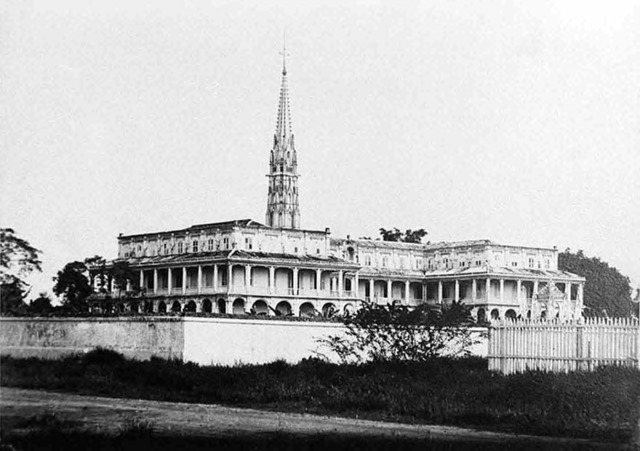 Fig. 3. The Convent of Sainte Enfance of the sisters of Saint Paul de Chartres was the first nunnery in Vietnam. Its first two sisters reached Saigon in 1860, and the building was finished in 1864 according to plans by Nguyễn Trường Tộ. The above image by Émile Gsell from 1866 was made two years later. The building subsequently was renovated at the end of the 19th century into its present form (without the bell tower). (Collection Gsell, 1866, ancient fonds du muse des colonies).
Following this was photography for Governor Charles le Myre de Vilers, the first French governor in the southern region of Vietnam, whose projects during his term of office had to be captured as data.[11] These photographs were preserved at the Diplomatic Archive Center in France, Quai d’Orsay, unnoted for more than one hundred and twenty years. In 2002, the French Consulate General in Saigon brought them out on exhibit. The images are quite detailed, for the camera was one of the larger models.[12] Instances of reddish color could indicate deterioration of chemical compounds or red on the back of the glass plates.
Fig. 3. The Convent of Sainte Enfance of the sisters of Saint Paul de Chartres was the first nunnery in Vietnam. Its first two sisters reached Saigon in 1860, and the building was finished in 1864 according to plans by Nguyễn Trường Tộ. The above image by Émile Gsell from 1866 was made two years later. The building subsequently was renovated at the end of the 19th century into its present form (without the bell tower). (Collection Gsell, 1866, ancient fonds du muse des colonies).
Following this was photography for Governor Charles le Myre de Vilers, the first French governor in the southern region of Vietnam, whose projects during his term of office had to be captured as data.[11] These photographs were preserved at the Diplomatic Archive Center in France, Quai d’Orsay, unnoted for more than one hundred and twenty years. In 2002, the French Consulate General in Saigon brought them out on exhibit. The images are quite detailed, for the camera was one of the larger models.[12] Instances of reddish color could indicate deterioration of chemical compounds or red on the back of the glass plates.
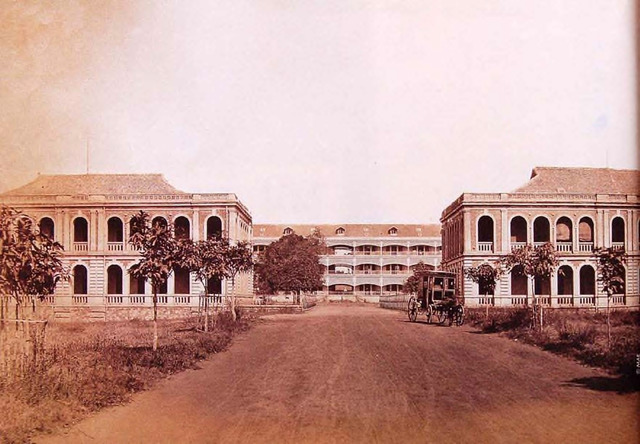 Fig. 4. Colonial Navy Grounds, 1882. The road in front with the building at the center is Ðinh Tiên Hoàng Street. Parts of the buildings on the left (which belonged to the College of Pharmacy) and right still exist. The resolution of the image is very high, as though by “zooming” one would see that, in the middle building, a sailor in white is staring at the photographer, while on the left a gardener brings water under the tree.
Fig. 4. Colonial Navy Grounds, 1882. The road in front with the building at the center is Ðinh Tiên Hoàng Street. Parts of the buildings on the left (which belonged to the College of Pharmacy) and right still exist. The resolution of the image is very high, as though by “zooming” one would see that, in the middle building, a sailor in white is staring at the photographer, while on the left a gardener brings water under the tree.
After the extremely rare daguerreotypes, photographs in Vietnam used the ambrotype process (on glass) and the calotype (on paper). The first portrait of a Vietnamese was that of Phan Thanh Giản, taken in Paris with the ambrotype process, when he led a delegation to France in 1863, hoping to regain the three Vietnamese provinces previously ceded to that country.
In the report of this trip, Diary of Western Travels, assistant diplomat Phạm Phú Thứ wrote this about the experience of the delegation on its first contact with a camera:
“[F]irst of all in the process of photography is to take medicinal water and rub it into a bit of glass, then fit it into the camera. One stands in front of it, staring at a fellow through its mouth, and one’s image is printed by sunlight on the glass, not a hair or a speck incorrectly. Westerners like to take photographs very much. In general, when they have just met, they all want photographs of each other to express their feelings of eternal remembrance. Noblemen and cowards, all and each are as conscientious as the other. Thus, from that day forward, officials constantly have been bringing laborers[9] to the hotel, requesting their supervisors’ permission to have a few photographs taken to give to their superiors and friends.”[10]
 Fig. 3. The Convent of Sainte Enfance of the sisters of Saint Paul de Chartres was the first nunnery in Vietnam. Its first two sisters reached Saigon in 1860, and the building was finished in 1864 according to plans by Nguyễn Trường Tộ. The above image by Émile Gsell from 1866 was made two years later. The building subsequently was renovated at the end of the 19th century into its present form (without the bell tower). (Collection Gsell, 1866, ancient fonds du muse des colonies).
Fig. 3. The Convent of Sainte Enfance of the sisters of Saint Paul de Chartres was the first nunnery in Vietnam. Its first two sisters reached Saigon in 1860, and the building was finished in 1864 according to plans by Nguyễn Trường Tộ. The above image by Émile Gsell from 1866 was made two years later. The building subsequently was renovated at the end of the 19th century into its present form (without the bell tower). (Collection Gsell, 1866, ancient fonds du muse des colonies).
Following this was photography for Governor Charles le Myre de Vilers, the first French governor in the southern region of Vietnam, whose projects during his term of office had to be captured as data.[11] These photographs were preserved at the Diplomatic Archive Center in France, Quai d’Orsay, unnoted for more than one hundred and twenty years. In 2002, the French Consulate General in Saigon brought them out on exhibit. The images are quite detailed, for the camera was one of the larger models.[12] Instances of reddish color could indicate deterioration of chemical compounds or red on the back of the glass plates.
 Fig. 4. Colonial Navy Grounds, 1882. The road in front with the building at the center is Ðinh Tiên Hoàng Street. Parts of the buildings on the left (which belonged to the College of Pharmacy) and right still exist. The resolution of the image is very high, as though by “zooming” one would see that, in the middle building, a sailor in white is staring at the photographer, while on the left a gardener brings water under the tree.
Fig. 4. Colonial Navy Grounds, 1882. The road in front with the building at the center is Ðinh Tiên Hoàng Street. Parts of the buildings on the left (which belonged to the College of Pharmacy) and right still exist. The resolution of the image is very high, as though by “zooming” one would see that, in the middle building, a sailor in white is staring at the photographer, while on the left a gardener brings water under the tree.The Invention of Photographic Development on Albumen Paper
At the Great Exhibition of the Works of Industry of All Nations, organized at the Crystal Palace in Hyde Park, London, in 1851, were two noteworthy events: the birth of Frederick Archer’s ambrotype process and the new invention of Désiré Blanquart-Evrard, the rapid development of photographs by daylight on paper coated with albumen. Through the invention of albumen paper and its replacement of glass plates, the cost of photographs became very affordable. Blanquart-Evrard opened the Photographic Printing House (Imprimerie Photographique), the first photographic production studio in France (at Lille) in 1851, printing many photographic albums.
The speed of developing on albumen paper made photographs popular and prized. From a single negative, many photographs were processed and printed on paper. These paper photographs were as easy to use as other illustrations in printed books, because they were not cumbersome and did not reflect light like images on glass.
Up to the 1850s, photographic specialists used daguerreotype or ambrotype technology with high resolution; others used low-resolution calotypes. The birth of albumen printing paper was received with satisfaction by both worlds and succeeded in transcending complaints. The vagaries and limits for amateur and professional photographers were lessened overall.
The negatives used to develop albumen photographs were usually calotypes (talbotypes) on paper or collodion negatives (ambrotypes) on glass. Collodion wet-plate negatives were used immediately after the photographer had mixed the chemicals on the glass surface, stuck into the camera in preparation for the shot. Because collodion negatives have high resolution, they gradually replaced negatives on paper.
Albumen photographs were developed from collodion negatives set into wooden frames, through which daylight was directed to cause a chemical reaction. If the day was cloudy or a bit too bright, it could take from one to five minutes to finish a photograph. Then the albumen paper with its just-created image was shielded from light with a fresh page of more-transparent paper. Usually photographs were inserted into frames before being brought to customers.
We can see that albumen prints long have been sepia-colored like the majority of postcards processed on albumen paper at the start of the twentieth century.
At the Great Exhibition of the Works of Industry of All Nations, organized at the Crystal Palace in Hyde Park, London, in 1851, were two noteworthy events: the birth of Frederick Archer’s ambrotype process and the new invention of Désiré Blanquart-Evrard, the rapid development of photographs by daylight on paper coated with albumen. Through the invention of albumen paper and its replacement of glass plates, the cost of photographs became very affordable. Blanquart-Evrard opened the Photographic Printing House (Imprimerie Photographique), the first photographic production studio in France (at Lille) in 1851, printing many photographic albums.
The speed of developing on albumen paper made photographs popular and prized. From a single negative, many photographs were processed and printed on paper. These paper photographs were as easy to use as other illustrations in printed books, because they were not cumbersome and did not reflect light like images on glass.
Up to the 1850s, photographic specialists used daguerreotype or ambrotype technology with high resolution; others used low-resolution calotypes. The birth of albumen printing paper was received with satisfaction by both worlds and succeeded in transcending complaints. The vagaries and limits for amateur and professional photographers were lessened overall.
The negatives used to develop albumen photographs were usually calotypes (talbotypes) on paper or collodion negatives (ambrotypes) on glass. Collodion wet-plate negatives were used immediately after the photographer had mixed the chemicals on the glass surface, stuck into the camera in preparation for the shot. Because collodion negatives have high resolution, they gradually replaced negatives on paper.
Albumen photographs were developed from collodion negatives set into wooden frames, through which daylight was directed to cause a chemical reaction. If the day was cloudy or a bit too bright, it could take from one to five minutes to finish a photograph. Then the albumen paper with its just-created image was shielded from light with a fresh page of more-transparent paper. Usually photographs were inserted into frames before being brought to customers.
We can see that albumen prints long have been sepia-colored like the majority of postcards processed on albumen paper at the start of the twentieth century.
Tintype (or Ferrotype)
The tintype was invented in America, in 1856, by chemistry professor Hamilton Smith. Its method was not new; rather, it was an improvement on the ambrotype: instead of capturing an image on a glass surface, it substituted metal such as iron or tin. Tintypes were very popular in America from the start of the Civil War to the end of the nineteenth century.
The surface of an iron plate was coated with black compounds (those often used in lacquer), which originated in Japan and gave rise to the term “japanning.”[13] These compounds made the iron plate smooth and impervious to rust, allowing the image to emerge during developing.
The tintype was invented in America, in 1856, by chemistry professor Hamilton Smith. Its method was not new; rather, it was an improvement on the ambrotype: instead of capturing an image on a glass surface, it substituted metal such as iron or tin. Tintypes were very popular in America from the start of the Civil War to the end of the nineteenth century.
The surface of an iron plate was coated with black compounds (those often used in lacquer), which originated in Japan and gave rise to the term “japanning.”[13] These compounds made the iron plate smooth and impervious to rust, allowing the image to emerge during developing.
Cartes de Visite
At the end of 1850, Andre Disdéri brought out photographs in the form of cartes de visite.[14] These were paper photographs very popular on the market. They were easy to publish in series, less expensive than tintypes, and used paper coated with albumen (from eggs) and then a layer of silver chloride. Although not as durable as ambrotypes or tintypes, their resolution was still high and their price was low enough for people to be able to pay. Also important were their ease of use and lack of cumbersomeness, winning popularity with every social class.
Cartes de visite were simpler and less expensive to publish than tintypes, and their quality was just as good. Thus they came to be more widely consumed by the masses, even though they were not as durable as the tintype for being paper (rather than iron), and bore the sepia tones of albumen.
At the end of 1850, Andre Disdéri brought out photographs in the form of cartes de visite.[14] These were paper photographs very popular on the market. They were easy to publish in series, less expensive than tintypes, and used paper coated with albumen (from eggs) and then a layer of silver chloride. Although not as durable as ambrotypes or tintypes, their resolution was still high and their price was low enough for people to be able to pay. Also important were their ease of use and lack of cumbersomeness, winning popularity with every social class.
Cartes de visite were simpler and less expensive to publish than tintypes, and their quality was just as good. Thus they came to be more widely consumed by the masses, even though they were not as durable as the tintype for being paper (rather than iron), and bore the sepia tones of albumen.
Photography and Celluloid Film
In America, in 1884, George Eastman invented the method of photography on paper from celluloid film, using oily and dry compounds. In 1888, the Kodak camera emerged, using rolls of film, and photographers no longer had to carry around plates and chemicals. They had only to press a button to take a picture, and the work of chemical processing was assumed by the Eastman Dry Plate Company. At the end of the nineteenth century and start of the twentieth, modern photography as we have known it became a reality and spread among us (before digital photography arrived, at the start of the twenty-first century).
In America, in 1884, George Eastman invented the method of photography on paper from celluloid film, using oily and dry compounds. In 1888, the Kodak camera emerged, using rolls of film, and photographers no longer had to carry around plates and chemicals. They had only to press a button to take a picture, and the work of chemical processing was assumed by the Eastman Dry Plate Company. At the end of the nineteenth century and start of the twentieth, modern photography as we have known it became a reality and spread among us (before digital photography arrived, at the start of the twenty-first century).
Chronology of Photographic Studios
This section sketches the biographies and photographic output of a few pioneer photographers during the nineteenth and the start of the twentieth centuries, in Vietnam generally as well as the in cities of Saigon and Cholon. Through this we see clearly the history of Vietnamese photography in its first era.
This section sketches the biographies and photographic output of a few pioneer photographers during the nineteenth and the start of the twentieth centuries, in Vietnam generally as well as the in cities of Saigon and Cholon. Through this we see clearly the history of Vietnamese photography in its first era.
Émile Gsell (1838–1879)
Émile Gsell was the first commercial photographer in Saigon. He had been sent to the southern region of Vietnam on military duty. After his discharge, however, he was selected, with Lieutenant Francis Garnier, by Captain Doudart de Lagrée for the 1866–68 Commission for the Exploration of the Mekong (Commission d’exploration du Mekong). He was the first to photograph the towers of Angkor with the expedition team. After this travel, he opened the studio Gsell Photographie in Saigon, selling prints of Angkor with great success. He also took many images of landscape and life in Saigon and other areas of the south.
In 1873, he returned to Angkor with Lieutenant Louis Delaporte (who had accompanied him previously with Doudart de Lagrée). He also photographed French troops under Garnier attacking the Citadel of Hanoi that year. From November 1876 to January 1877, he followed Lieutenant Kergaradec back to the Red River. During these two trips, he traveled with the photographer Jean Baptiste Pellissier. Gsell was the first photographer to take a portrait of a Vietnamese woman in the northern region of the country.
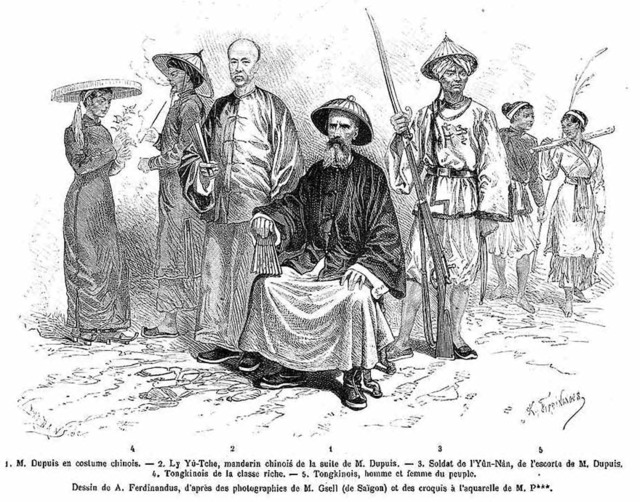 Fig. 5. Drawings after photographic portraits by Gsell, published in “The Conquest of the Tonkin Delta” (“La conquête du delta du Tong-kin”) by Romanet de Caillaud.[15] The image shows Jean Dupuis with the Chinese official and Yunnanese guard who accompanied him, as well as northern Vietnamese of aristocratic and common classes.
He exhibited and took a medal at the Vienna International Exposition. Through his investigations, he concentrated on photographs of the lives and customs of local people. His studio in Saigon was near the homes of wealthy Vietnamese who often had him take their portraits.[16]
Gsell died when still young, at forty-one years old, in Saigon, on October 16, 1879. Near the end of his life, he photographed architectural and public works projects in Saigon for Governor General Le Myre de Vilers.
After Gsell’s death, his photographic material was taken over by O. Wegener and then inherited by Vidal. Vidal used it for commercial purposes until he died, in 1883. Gsell’s photographs also were printed in an article by Francis Garnier on Angkor in Around the World (Le Tour du Monde, 1870-71); Romanet de Caillaud’s “La conquête du delta du Tong-kin” (Le Tour du Monde, 1878/2), and Brossard de Corbigny’s “Eight Days in the Embassy at Hue” (“Huit jours d’ambassade à Hué”), printed in Le Tour du Monde, 1878/1, in which it is recorded that Gsell received permission to photograph from the Vietnamese emperor in Hue.
In December 2007, an album comprising about three hundred and fifty photographs by Gsell was brought to auction by Galerie Bassenge in Berlin. It included prints from negatives marked by Gsell as well as photographs with notes below them in pencil. All images of Angkor had printed captions mounted below.[17]
The first page of the album is a composite image of about one hundred and twenty postcards surrounding the name of his studio, Gsell Photographie. This could be used to identify Indochinese images for which photographers hitherto have been unknown. The album contains pictures of Saigon Harbor, sailboats at the docks, the estate of the governor general of Saigon, and other stately homes and palaces in Indochina when the French arrived and started to establish the city. Many other images show high officials, bishops, actors, singers, and soldiers, as well as shrines, temples, statuary, foreign settlements, and native villages.
Fig. 5. Drawings after photographic portraits by Gsell, published in “The Conquest of the Tonkin Delta” (“La conquête du delta du Tong-kin”) by Romanet de Caillaud.[15] The image shows Jean Dupuis with the Chinese official and Yunnanese guard who accompanied him, as well as northern Vietnamese of aristocratic and common classes.
He exhibited and took a medal at the Vienna International Exposition. Through his investigations, he concentrated on photographs of the lives and customs of local people. His studio in Saigon was near the homes of wealthy Vietnamese who often had him take their portraits.[16]
Gsell died when still young, at forty-one years old, in Saigon, on October 16, 1879. Near the end of his life, he photographed architectural and public works projects in Saigon for Governor General Le Myre de Vilers.
After Gsell’s death, his photographic material was taken over by O. Wegener and then inherited by Vidal. Vidal used it for commercial purposes until he died, in 1883. Gsell’s photographs also were printed in an article by Francis Garnier on Angkor in Around the World (Le Tour du Monde, 1870-71); Romanet de Caillaud’s “La conquête du delta du Tong-kin” (Le Tour du Monde, 1878/2), and Brossard de Corbigny’s “Eight Days in the Embassy at Hue” (“Huit jours d’ambassade à Hué”), printed in Le Tour du Monde, 1878/1, in which it is recorded that Gsell received permission to photograph from the Vietnamese emperor in Hue.
In December 2007, an album comprising about three hundred and fifty photographs by Gsell was brought to auction by Galerie Bassenge in Berlin. It included prints from negatives marked by Gsell as well as photographs with notes below them in pencil. All images of Angkor had printed captions mounted below.[17]
The first page of the album is a composite image of about one hundred and twenty postcards surrounding the name of his studio, Gsell Photographie. This could be used to identify Indochinese images for which photographers hitherto have been unknown. The album contains pictures of Saigon Harbor, sailboats at the docks, the estate of the governor general of Saigon, and other stately homes and palaces in Indochina when the French arrived and started to establish the city. Many other images show high officials, bishops, actors, singers, and soldiers, as well as shrines, temples, statuary, foreign settlements, and native villages.
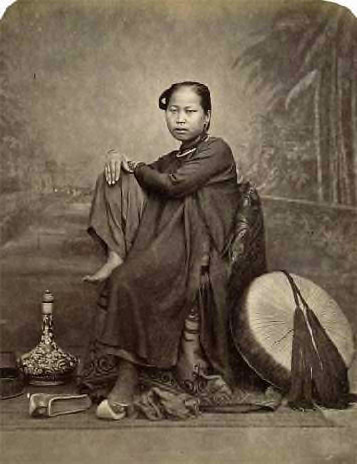 Fig. 6. Émile Gsell, Portrait of a North Vietnamese Woman. Note the wide-tasseled hat, common across Vietnam at the time.
Fig. 6. Émile Gsell, Portrait of a North Vietnamese Woman. Note the wide-tasseled hat, common across Vietnam at the time.
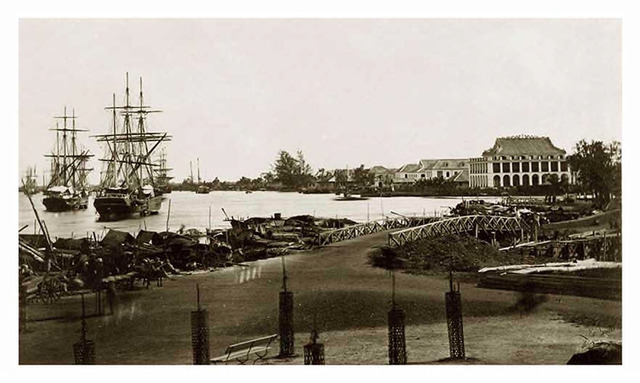 Fig. 7. Saigon Harbor. This image was later printed as an engraving in the book France Illustrated, (La France illustrée) (1884) by V.A. Malte-Brun[18] and in an article by Dr. Albert Morice in Tour du Monde, 1875.
Fig. 7. Saigon Harbor. This image was later printed as an engraving in the book France Illustrated, (La France illustrée) (1884) by V.A. Malte-Brun[18] and in an article by Dr. Albert Morice in Tour du Monde, 1875.
 Fig. 8. Émile Gsell, 1870. “Indochinese Natives” (Natives indochinois). Albumen print. One of the oldest images of indigenous peoples. This probably shows the Stieng or the Mạ, who lived in the areas of Saigon or Lâm Đồng (Tây Nguyên).
Fig. 8. Émile Gsell, 1870. “Indochinese Natives” (Natives indochinois). Albumen print. One of the oldest images of indigenous peoples. This probably shows the Stieng or the Mạ, who lived in the areas of Saigon or Lâm Đồng (Tây Nguyên).
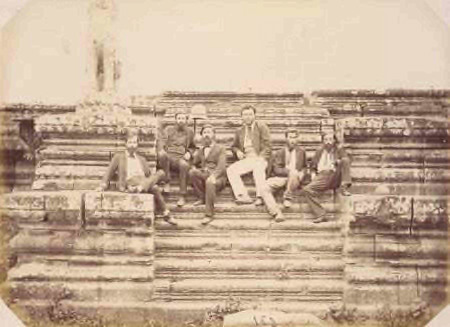 Fig. 9. Émile Gsell. Albumen print. From left to right: Lieutenant Francis Garnier (1839-1873) (second-in-command of the Expedition); Lieutenant Louis Delaporte (1842-1925) (artist); Drs. Clovis Thorel (1833-1911) and Lucien Joubert (1832-1893) (both doctors in the navy, observing geography, ethnology and botany with the Expedition); Captain Doudart de Lagrée (1823-1868) (in white trousers); Louis de Carné (1844-1870) (attaché with the French embassy).[19]
Fig. 9. Émile Gsell. Albumen print. From left to right: Lieutenant Francis Garnier (1839-1873) (second-in-command of the Expedition); Lieutenant Louis Delaporte (1842-1925) (artist); Drs. Clovis Thorel (1833-1911) and Lucien Joubert (1832-1893) (both doctors in the navy, observing geography, ethnology and botany with the Expedition); Captain Doudart de Lagrée (1823-1868) (in white trousers); Louis de Carné (1844-1870) (attaché with the French embassy).[19]
Émile Gsell was the first commercial photographer in Saigon. He had been sent to the southern region of Vietnam on military duty. After his discharge, however, he was selected, with Lieutenant Francis Garnier, by Captain Doudart de Lagrée for the 1866–68 Commission for the Exploration of the Mekong (Commission d’exploration du Mekong). He was the first to photograph the towers of Angkor with the expedition team. After this travel, he opened the studio Gsell Photographie in Saigon, selling prints of Angkor with great success. He also took many images of landscape and life in Saigon and other areas of the south.
In 1873, he returned to Angkor with Lieutenant Louis Delaporte (who had accompanied him previously with Doudart de Lagrée). He also photographed French troops under Garnier attacking the Citadel of Hanoi that year. From November 1876 to January 1877, he followed Lieutenant Kergaradec back to the Red River. During these two trips, he traveled with the photographer Jean Baptiste Pellissier. Gsell was the first photographer to take a portrait of a Vietnamese woman in the northern region of the country.
 Fig. 5. Drawings after photographic portraits by Gsell, published in “The Conquest of the Tonkin Delta” (“La conquête du delta du Tong-kin”) by Romanet de Caillaud.[15] The image shows Jean Dupuis with the Chinese official and Yunnanese guard who accompanied him, as well as northern Vietnamese of aristocratic and common classes.
Fig. 5. Drawings after photographic portraits by Gsell, published in “The Conquest of the Tonkin Delta” (“La conquête du delta du Tong-kin”) by Romanet de Caillaud.[15] The image shows Jean Dupuis with the Chinese official and Yunnanese guard who accompanied him, as well as northern Vietnamese of aristocratic and common classes.
He exhibited and took a medal at the Vienna International Exposition. Through his investigations, he concentrated on photographs of the lives and customs of local people. His studio in Saigon was near the homes of wealthy Vietnamese who often had him take their portraits.[16]
Gsell died when still young, at forty-one years old, in Saigon, on October 16, 1879. Near the end of his life, he photographed architectural and public works projects in Saigon for Governor General Le Myre de Vilers.
After Gsell’s death, his photographic material was taken over by O. Wegener and then inherited by Vidal. Vidal used it for commercial purposes until he died, in 1883. Gsell’s photographs also were printed in an article by Francis Garnier on Angkor in Around the World (Le Tour du Monde, 1870-71); Romanet de Caillaud’s “La conquête du delta du Tong-kin” (Le Tour du Monde, 1878/2), and Brossard de Corbigny’s “Eight Days in the Embassy at Hue” (“Huit jours d’ambassade à Hué”), printed in Le Tour du Monde, 1878/1, in which it is recorded that Gsell received permission to photograph from the Vietnamese emperor in Hue.
In December 2007, an album comprising about three hundred and fifty photographs by Gsell was brought to auction by Galerie Bassenge in Berlin. It included prints from negatives marked by Gsell as well as photographs with notes below them in pencil. All images of Angkor had printed captions mounted below.[17]
The first page of the album is a composite image of about one hundred and twenty postcards surrounding the name of his studio, Gsell Photographie. This could be used to identify Indochinese images for which photographers hitherto have been unknown. The album contains pictures of Saigon Harbor, sailboats at the docks, the estate of the governor general of Saigon, and other stately homes and palaces in Indochina when the French arrived and started to establish the city. Many other images show high officials, bishops, actors, singers, and soldiers, as well as shrines, temples, statuary, foreign settlements, and native villages.
 Fig. 6. Émile Gsell, Portrait of a North Vietnamese Woman. Note the wide-tasseled hat, common across Vietnam at the time.
Fig. 6. Émile Gsell, Portrait of a North Vietnamese Woman. Note the wide-tasseled hat, common across Vietnam at the time. Fig. 7. Saigon Harbor. This image was later printed as an engraving in the book France Illustrated, (La France illustrée) (1884) by V.A. Malte-Brun[18] and in an article by Dr. Albert Morice in Tour du Monde, 1875.
Fig. 7. Saigon Harbor. This image was later printed as an engraving in the book France Illustrated, (La France illustrée) (1884) by V.A. Malte-Brun[18] and in an article by Dr. Albert Morice in Tour du Monde, 1875. Fig. 8. Émile Gsell, 1870. “Indochinese Natives” (Natives indochinois). Albumen print. One of the oldest images of indigenous peoples. This probably shows the Stieng or the Mạ, who lived in the areas of Saigon or Lâm Đồng (Tây Nguyên).
Fig. 8. Émile Gsell, 1870. “Indochinese Natives” (Natives indochinois). Albumen print. One of the oldest images of indigenous peoples. This probably shows the Stieng or the Mạ, who lived in the areas of Saigon or Lâm Đồng (Tây Nguyên). Fig. 9. Émile Gsell. Albumen print. From left to right: Lieutenant Francis Garnier (1839-1873) (second-in-command of the Expedition); Lieutenant Louis Delaporte (1842-1925) (artist); Drs. Clovis Thorel (1833-1911) and Lucien Joubert (1832-1893) (both doctors in the navy, observing geography, ethnology and botany with the Expedition); Captain Doudart de Lagrée (1823-1868) (in white trousers); Louis de Carné (1844-1870) (attaché with the French embassy).[19]
Fig. 9. Émile Gsell. Albumen print. From left to right: Lieutenant Francis Garnier (1839-1873) (second-in-command of the Expedition); Lieutenant Louis Delaporte (1842-1925) (artist); Drs. Clovis Thorel (1833-1911) and Lucien Joubert (1832-1893) (both doctors in the navy, observing geography, ethnology and botany with the Expedition); Captain Doudart de Lagrée (1823-1868) (in white trousers); Louis de Carné (1844-1870) (attaché with the French embassy).[19]Pun Lun (繽綸)
Pun Lun (Tân Luân) was a photographer from Hong Kong who had been famous there in the 1860s. His studio and main place of business was in the center of Hong Kong, at 56 Queens Street, facing the Oriental Bank. In addition to photography, he offered skills in sketching and carving images on elephant tusks.
He had branches in Saigon, Fuzhou, and Singapore. He was active from the 1860s to the 1880s, contemporarily with the photographer A Fong (華芳, Hoa Phương) in Hong Kong (1859–1941). He is considered a pioneer in the history of Chinese photography today.
Several images from his studio are some of the earliest taken in Saigon, before those of Gsell.
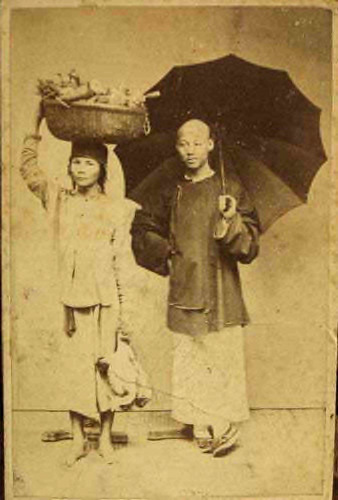 Fig. 11. Pun Lun, Studio Photograph of people from Saigon, 1880, (a market woman carrying goods on her head and probably a Chinese merchant with an umbrella).
Pun Lun took many images in Saigon, among which is the beautiful photograph of a southern official (below), “An Indochinese Notable” (Un notable indochinois), in about 1880, an albumen print (16 x 20 cm).
Several other images of Saigon bear the name Pun Ky (Tân Kỳ) on the back. He may have been a representative of Pun Lun in Saigon and is likely related to his Hong Kong lineage.
Fig. 11. Pun Lun, Studio Photograph of people from Saigon, 1880, (a market woman carrying goods on her head and probably a Chinese merchant with an umbrella).
Pun Lun took many images in Saigon, among which is the beautiful photograph of a southern official (below), “An Indochinese Notable” (Un notable indochinois), in about 1880, an albumen print (16 x 20 cm).
Several other images of Saigon bear the name Pun Ky (Tân Kỳ) on the back. He may have been a representative of Pun Lun in Saigon and is likely related to his Hong Kong lineage.
Pun Lun (Tân Luân) was a photographer from Hong Kong who had been famous there in the 1860s. His studio and main place of business was in the center of Hong Kong, at 56 Queens Street, facing the Oriental Bank. In addition to photography, he offered skills in sketching and carving images on elephant tusks.
He had branches in Saigon, Fuzhou, and Singapore. He was active from the 1860s to the 1880s, contemporarily with the photographer A Fong (華芳, Hoa Phương) in Hong Kong (1859–1941). He is considered a pioneer in the history of Chinese photography today.
Several images from his studio are some of the earliest taken in Saigon, before those of Gsell.
 Fig. 11. Pun Lun, Studio Photograph of people from Saigon, 1880, (a market woman carrying goods on her head and probably a Chinese merchant with an umbrella).
Fig. 11. Pun Lun, Studio Photograph of people from Saigon, 1880, (a market woman carrying goods on her head and probably a Chinese merchant with an umbrella).
Pun Lun took many images in Saigon, among which is the beautiful photograph of a southern official (below), “An Indochinese Notable” (Un notable indochinois), in about 1880, an albumen print (16 x 20 cm).
Several other images of Saigon bear the name Pun Ky (Tân Kỳ) on the back. He may have been a representative of Pun Lun in Saigon and is likely related to his Hong Kong lineage.
Aurélien Pestel (1855–1897)
Pestel could be called the best among the three pioneering geniuses of photography in late-nineteenth-century Saigon. Initially, his business was not related directly to photography, but he later became a photographer in Cambodia and then in Saigon, where he died in 1897 at 10 Charner Avenue.
The quality of Pestel’s images transformed him into a sort of ambassador for Indochina at the 1894 World Exposition in Lyon.[20] He displayed an album full of rare prints of the southern region of Vietnam and Cambodia. This album was truly a work of art. From the standpoint of composition, the photographs used traditional Vietnamese lacquer techniques. A number of Pestel’s works can be seen in the diplomatic archives of France.[21]
Images by Pestel were used by Pierre Barrelon as illustrations for his article “Saigon” (Le Tour du Monde, 1893) and by E. Aymonier in a piece on Cambodia around 1900. Several of his images of the opium industry from an album of 1894 were published in the famous pictorial l’Illustration in 1896.
Pestel’s images were printed in announcements related to Indochina’s participation in the 1900 World’s Fair, along with those by Dr. Victor Le Lan and Fernand Blanchet. The collected series of cartes de visite from “Les editions La Pagode” in Saigon included a number of images by Pestel, mainly from the series “Vietnamese Men of Letters.”[22]He took these photographs in the home of Governor General Phương in Cholon (then on Châu Văn Liêm Street, no longer extant). Pestel’s successor, Planté, also published some of Pestel’s most beautiful images as postcards.
Pestel’s studio, 10 Charner Avenue, was put to use after his death by Négadelle, then Paullussen, and finally Planté. All subsequently became well-known photographers in Saigon.
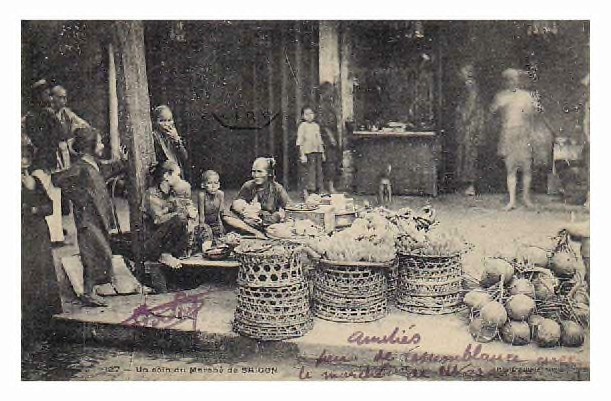 Fig. 14. Women Selling Fruit Near the Old Saigon Market, postcard of an image by Aurélien Pestel[23].
Fig. 14. Women Selling Fruit Near the Old Saigon Market, postcard of an image by Aurélien Pestel[23].
Pestel could be called the best among the three pioneering geniuses of photography in late-nineteenth-century Saigon. Initially, his business was not related directly to photography, but he later became a photographer in Cambodia and then in Saigon, where he died in 1897 at 10 Charner Avenue.
The quality of Pestel’s images transformed him into a sort of ambassador for Indochina at the 1894 World Exposition in Lyon.[20] He displayed an album full of rare prints of the southern region of Vietnam and Cambodia. This album was truly a work of art. From the standpoint of composition, the photographs used traditional Vietnamese lacquer techniques. A number of Pestel’s works can be seen in the diplomatic archives of France.[21]
Images by Pestel were used by Pierre Barrelon as illustrations for his article “Saigon” (Le Tour du Monde, 1893) and by E. Aymonier in a piece on Cambodia around 1900. Several of his images of the opium industry from an album of 1894 were published in the famous pictorial l’Illustration in 1896.
Pestel’s images were printed in announcements related to Indochina’s participation in the 1900 World’s Fair, along with those by Dr. Victor Le Lan and Fernand Blanchet. The collected series of cartes de visite from “Les editions La Pagode” in Saigon included a number of images by Pestel, mainly from the series “Vietnamese Men of Letters.”[22]He took these photographs in the home of Governor General Phương in Cholon (then on Châu Văn Liêm Street, no longer extant). Pestel’s successor, Planté, also published some of Pestel’s most beautiful images as postcards.
Pestel’s studio, 10 Charner Avenue, was put to use after his death by Négadelle, then Paullussen, and finally Planté. All subsequently became well-known photographers in Saigon.
 Fig. 14. Women Selling Fruit Near the Old Saigon Market, postcard of an image by Aurélien Pestel[23].
Fig. 14. Women Selling Fruit Near the Old Saigon Market, postcard of an image by Aurélien Pestel[23].George Victor Planté (1847–1921)
Planté was born in France on March 2, 1847, and died in Saigon in 1921. When he first arrived in the southern region of Vietnam, he worked at the Indochina Department of Taxation and Registration (Service des Douanes et Regies de l’Indochine). This concern had opium factories on Paul Blanchy Street, now on Hai Ba Trưng past the Municipal Theater. He later became a photographer and postcard publisher, in 1893.[24]
After 1905, he moved to 10 Charner Avenue, the same address as Aurélien Pestel, Négadelle, and Paullussen before him. The 1907 Indochina Yearbook (Annuaire de l’Indochine de 1907) shows a portrait of Planté and describes the following activities:
“Portraits of every type. Enlarged on gelatino-bromure. Scenes of South Vietnam and the ruins of Angkor (on gelatino-bromure paper). Large collection of illustrated postcards. (Portraits en tous genre. Agrandissements au gélatino-bromure. Vues de Cochinchine et des ruines d’Angkor (sur papier gélatino-bromure). Grande collection de cartes postales illustrées).” (188)
Planté worked in a separate style for each customer and sold postcards from 1905 onward. Among these are a portrait of King Thành Thái as well as images by Pestel. The man who later replaced Planté was Crespin. The 1922Indochina Yearbook lists an individual named Jules Louis Planté, born in 1891, working in the Indochina Department of Taxation and Registration (Douanes et Regies de l’Indochine), possibly his son.
Planté was born in France on March 2, 1847, and died in Saigon in 1921. When he first arrived in the southern region of Vietnam, he worked at the Indochina Department of Taxation and Registration (Service des Douanes et Regies de l’Indochine). This concern had opium factories on Paul Blanchy Street, now on Hai Ba Trưng past the Municipal Theater. He later became a photographer and postcard publisher, in 1893.[24]
After 1905, he moved to 10 Charner Avenue, the same address as Aurélien Pestel, Négadelle, and Paullussen before him. The 1907 Indochina Yearbook (Annuaire de l’Indochine de 1907) shows a portrait of Planté and describes the following activities:
“Portraits of every type. Enlarged on gelatino-bromure. Scenes of South Vietnam and the ruins of Angkor (on gelatino-bromure paper). Large collection of illustrated postcards. (Portraits en tous genre. Agrandissements au gélatino-bromure. Vues de Cochinchine et des ruines d’Angkor (sur papier gélatino-bromure). Grande collection de cartes postales illustrées).” (188)
Planté worked in a separate style for each customer and sold postcards from 1905 onward. Among these are a portrait of King Thành Thái as well as images by Pestel. The man who later replaced Planté was Crespin. The 1922Indochina Yearbook lists an individual named Jules Louis Planté, born in 1891, working in the Indochina Department of Taxation and Registration (Douanes et Regies de l’Indochine), possibly his son.
Nguyễn Đình Khánh (styled Khánh Ký) (1884–1946)
Nguyễn Đình Khánh, originally Nguyễn Văn Xuân, who used the studio name Khánh Ký, was born in the village of Lai Xá, Hà Đông (currently part of Hanoi) in 1884. After the photographic firm Cảm Hiếu Đông appeared under Đặng Huy Trứ on Hanoi’s Thanh Hà Street in 1869, Khánh Ký’s studio became the second photo studio ever owned by a Vietnamese, opening on Hàng Da Street, Hanoi, in 1893. Unlike his predecessor, however, Khánh Ký not only specialized in taking portraits himself but also hired and trained many others, most of whom left Lai Xá and opened their own studios in Nam Định (1905), Saigon (1907), Toulouse (1910, when he had just arrived in France), and Paris. When he returned to Vietnam, in 1924, he opened photographic studios in Hanoi, Guangzhou, Haiphong, Nam Định, and Saigon. The village of Lai Xá today has a photographic tradition based on his work.
Khánh Ký engaged in photographic activity in Saigon mainly from 1924 to 1933. His Saigon office was at 54 Bonnard Avenue (now Lệ Lợi). In 1934, this establishment employed twenty-seven staff, comprising photographers, developers, retouchers, and salespeople. Starting in 1917, Khánh Ký was the one who shot portraits of all the French governors general in Indochina, just as he did for the Vietnamese emperor and the kings of Cambodia and Laos.
Photographs by Khánh Ký’s studios bear the inscriptions “Khanh Ky photo, Hanoi” and “Photo Khanh Ky, Saigon.”[25] He also took photographs for the Society for Indochinese Studies (Société des Etudes Indochinoises). Several of his images were also printed in the periodical Colonial World Illustrated (Monde colonial illustré) (1931) and the special issue for the 1931 Colonial Exposition (Exposition colonial 1931), as well as the 1932 issue, after Minister of Colonies Paul Reynaud made a state visit to Indochina.
Khánh Ký also took a portrait of the governor general of Indochina Pierre Pasquier, who supported Emperor Bảo Đại, and of the revolutionary Nguyễn An Ninh. In the article “The Voyage of the Vietnamese Emperor to Tonkin” (“Le Voyage de l’empereur d’annam du Tonkin”) in edition 4740 of l’Illustration (1933), he had news photographs of Emperor Bảo Đại’s visit to the northern region of Vietnam.
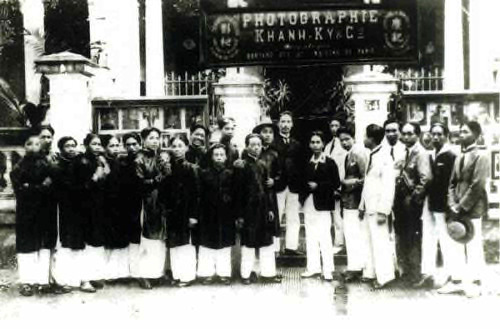 Fig. 17. Khánh Ký (in front of the gate, in a black European-style jacket), with photographic workers from Lai Xá Village[26].
Fig. 17. Khánh Ký (in front of the gate, in a black European-style jacket), with photographic workers from Lai Xá Village[26].
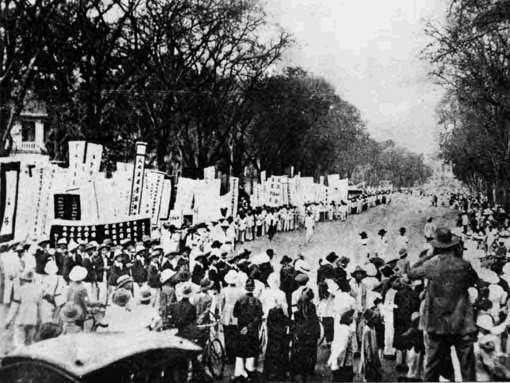 Fig. 18. Khánh Ký, Funeral of Phan Châu Trinh, Saigon, 1926[27].
Khánh Ký was part of the organization committee for the funeral proceedings of Phan Châu Trinh[28] in Saigon in 1926. The photographic series of the funeral rites and the related spectacle in Saigon was created by Khánh Ký. In 1932, he went to Japan and made contact with early members of the Eastern Travel Movement.[29] On his return, he praised the movement and was arrested by the French for offenses connected to Prince Cường Để’s influence and allegiances in Japan.[30]
Fig. 18. Khánh Ký, Funeral of Phan Châu Trinh, Saigon, 1926[27].
Khánh Ký was part of the organization committee for the funeral proceedings of Phan Châu Trinh[28] in Saigon in 1926. The photographic series of the funeral rites and the related spectacle in Saigon was created by Khánh Ký. In 1932, he went to Japan and made contact with early members of the Eastern Travel Movement.[29] On his return, he praised the movement and was arrested by the French for offenses connected to Prince Cường Để’s influence and allegiances in Japan.[30]
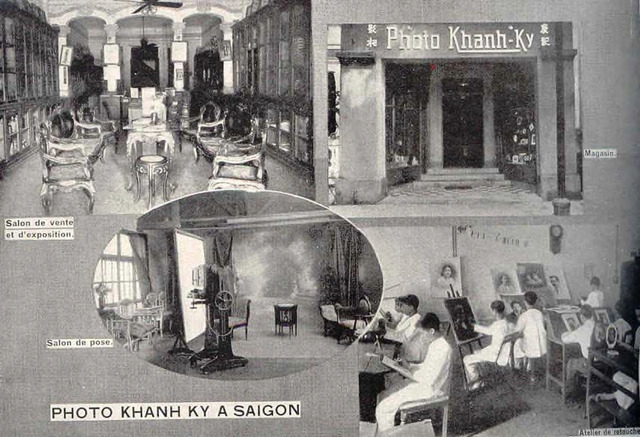 Fig. 19. Advertisement for Khánh Ký’s Saigon Establishment, 1930s[31].
Fig. 19. Advertisement for Khánh Ký’s Saigon Establishment, 1930s[31].
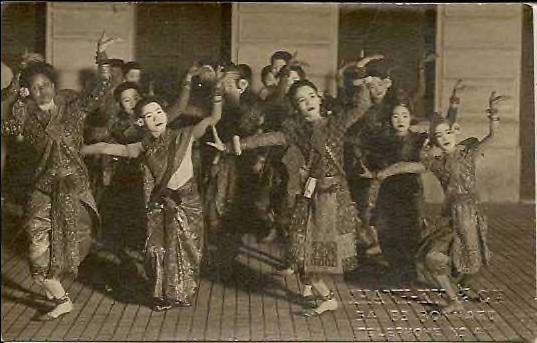 Fig. 20. Dancers, in the corner is the embossed caption “Khanh Ky et Cie, 54 Bd Bonnard Telephone No. 410.”[32].
Khánh Ký’s establishments then went bankrupt. He returned to France in 1934, continued to do business in photography, and died there in 1946. When Hồ Chí Minh visited France to attend the Fontainebleau conference in 1946, he paid respects at the tomb of Khánh Ký, who had helped him through his hard days of seeking work when he had first arrived in France.
Fig. 20. Dancers, in the corner is the embossed caption “Khanh Ky et Cie, 54 Bd Bonnard Telephone No. 410.”[32].
Khánh Ký’s establishments then went bankrupt. He returned to France in 1934, continued to do business in photography, and died there in 1946. When Hồ Chí Minh visited France to attend the Fontainebleau conference in 1946, he paid respects at the tomb of Khánh Ký, who had helped him through his hard days of seeking work when he had first arrived in France.
Nguyễn Đình Khánh, originally Nguyễn Văn Xuân, who used the studio name Khánh Ký, was born in the village of Lai Xá, Hà Đông (currently part of Hanoi) in 1884. After the photographic firm Cảm Hiếu Đông appeared under Đặng Huy Trứ on Hanoi’s Thanh Hà Street in 1869, Khánh Ký’s studio became the second photo studio ever owned by a Vietnamese, opening on Hàng Da Street, Hanoi, in 1893. Unlike his predecessor, however, Khánh Ký not only specialized in taking portraits himself but also hired and trained many others, most of whom left Lai Xá and opened their own studios in Nam Định (1905), Saigon (1907), Toulouse (1910, when he had just arrived in France), and Paris. When he returned to Vietnam, in 1924, he opened photographic studios in Hanoi, Guangzhou, Haiphong, Nam Định, and Saigon. The village of Lai Xá today has a photographic tradition based on his work.
Khánh Ký engaged in photographic activity in Saigon mainly from 1924 to 1933. His Saigon office was at 54 Bonnard Avenue (now Lệ Lợi). In 1934, this establishment employed twenty-seven staff, comprising photographers, developers, retouchers, and salespeople. Starting in 1917, Khánh Ký was the one who shot portraits of all the French governors general in Indochina, just as he did for the Vietnamese emperor and the kings of Cambodia and Laos.
Photographs by Khánh Ký’s studios bear the inscriptions “Khanh Ky photo, Hanoi” and “Photo Khanh Ky, Saigon.”[25] He also took photographs for the Society for Indochinese Studies (Société des Etudes Indochinoises). Several of his images were also printed in the periodical Colonial World Illustrated (Monde colonial illustré) (1931) and the special issue for the 1931 Colonial Exposition (Exposition colonial 1931), as well as the 1932 issue, after Minister of Colonies Paul Reynaud made a state visit to Indochina.
Khánh Ký also took a portrait of the governor general of Indochina Pierre Pasquier, who supported Emperor Bảo Đại, and of the revolutionary Nguyễn An Ninh. In the article “The Voyage of the Vietnamese Emperor to Tonkin” (“Le Voyage de l’empereur d’annam du Tonkin”) in edition 4740 of l’Illustration (1933), he had news photographs of Emperor Bảo Đại’s visit to the northern region of Vietnam.
 Fig. 17. Khánh Ký (in front of the gate, in a black European-style jacket), with photographic workers from Lai Xá Village[26].
Fig. 17. Khánh Ký (in front of the gate, in a black European-style jacket), with photographic workers from Lai Xá Village[26]. Fig. 18. Khánh Ký, Funeral of Phan Châu Trinh, Saigon, 1926[27].
Fig. 18. Khánh Ký, Funeral of Phan Châu Trinh, Saigon, 1926[27].
Khánh Ký was part of the organization committee for the funeral proceedings of Phan Châu Trinh[28] in Saigon in 1926. The photographic series of the funeral rites and the related spectacle in Saigon was created by Khánh Ký. In 1932, he went to Japan and made contact with early members of the Eastern Travel Movement.[29] On his return, he praised the movement and was arrested by the French for offenses connected to Prince Cường Để’s influence and allegiances in Japan.[30]
 Fig. 19. Advertisement for Khánh Ký’s Saigon Establishment, 1930s[31].
Fig. 19. Advertisement for Khánh Ký’s Saigon Establishment, 1930s[31]. Fig. 20. Dancers, in the corner is the embossed caption “Khanh Ky et Cie, 54 Bd Bonnard Telephone No. 410.”[32].
Fig. 20. Dancers, in the corner is the embossed caption “Khanh Ky et Cie, 54 Bd Bonnard Telephone No. 410.”[32].
Khánh Ký’s establishments then went bankrupt. He returned to France in 1934, continued to do business in photography, and died there in 1946. When Hồ Chí Minh visited France to attend the Fontainebleau conference in 1946, he paid respects at the tomb of Khánh Ký, who had helped him through his hard days of seeking work when he had first arrived in France.
Gabriel Auguste Paullussen
The images below (among which is a photograph of General Joffre in Cholon, before the telegraph office connecting Indochina with Marseille) were taken by the photographer Auguste Gabriel Paullussen in 1921. They bear the name of his studio, Saigon Photo, at 10 Charner Avenue (now Nguyễn Huệ Street). Paullussen employed one Chinese and five Vietnamese as workers in his studio.[33]
Paullussen succeeded the photographer George Victor Planté, who had an office with him at the address above. Planté had already made many famous postcards of Saigon. After Planté died, in 1921, Paullussen took over.
Paullussen’s birth and death dates, like his life and career, cannot be known clearly compared to those of other photographers. The photographic collections and papers of the photographer and inventor Gabriel Cromer, a member of the administrative council for the French Photography Society (Société Française de la Photographie), preserve a letter from Paullussen to Cromer, praising one of his works. This material currently belongs to the Kodak Collection, George Eastman House.
The images below (among which is a photograph of General Joffre in Cholon, before the telegraph office connecting Indochina with Marseille) were taken by the photographer Auguste Gabriel Paullussen in 1921. They bear the name of his studio, Saigon Photo, at 10 Charner Avenue (now Nguyễn Huệ Street). Paullussen employed one Chinese and five Vietnamese as workers in his studio.[33]
Paullussen succeeded the photographer George Victor Planté, who had an office with him at the address above. Planté had already made many famous postcards of Saigon. After Planté died, in 1921, Paullussen took over.
Paullussen’s birth and death dates, like his life and career, cannot be known clearly compared to those of other photographers. The photographic collections and papers of the photographer and inventor Gabriel Cromer, a member of the administrative council for the French Photography Society (Société Française de la Photographie), preserve a letter from Paullussen to Cromer, praising one of his works. This material currently belongs to the Kodak Collection, George Eastman House.
Martin Hürlimann (1897–1984)
Hürlimann was a famous Swiss photographer. He visited many places around the world, in the 1920s, 1930s, and 1940s, taking photographs of temples and monuments, palaces, natural wonders, urban cultural productions, and ruins—in Europe, Ceylon, Burma, Siam (Thailand), Cambodia, the central and northern regions of Vietnam, and yet more—using a Sinclair with Kodak film. After this, his images were usually released as copperplate prints by the French method of photogravure, easily used in printing photographic books with clarity, beauty, and artistry.
Along the lines of his albums of Europe, his album of Asia and Indochina is titled Ceylon and Indochina: Architecture, Landscape, Popular Scenes (Ceylon et l’Indochine: Architecture, paysages, scenes populaires; Paris, 1930). Most of the images are towers, statues, scenes of Angkor, Chieng Mai, Lamphun, Bangkok, Phnom Penh, Champa (in the central region of Vietnam), and the northern region of Vietnam. The most numerous of the Vietnamese images show the towers, statues, and landscapes of the ancient kingdom of Champa.[34]
Hürlimann was a famous Swiss photographer. He visited many places around the world, in the 1920s, 1930s, and 1940s, taking photographs of temples and monuments, palaces, natural wonders, urban cultural productions, and ruins—in Europe, Ceylon, Burma, Siam (Thailand), Cambodia, the central and northern regions of Vietnam, and yet more—using a Sinclair with Kodak film. After this, his images were usually released as copperplate prints by the French method of photogravure, easily used in printing photographic books with clarity, beauty, and artistry.
Along the lines of his albums of Europe, his album of Asia and Indochina is titled Ceylon and Indochina: Architecture, Landscape, Popular Scenes (Ceylon et l’Indochine: Architecture, paysages, scenes populaires; Paris, 1930). Most of the images are towers, statues, scenes of Angkor, Chieng Mai, Lamphun, Bangkok, Phnom Penh, Champa (in the central region of Vietnam), and the northern region of Vietnam. The most numerous of the Vietnamese images show the towers, statues, and landscapes of the ancient kingdom of Champa.[34]
Alexandre Francis Decoly
Decoly published images in Saigon from 1905 to 1924. He released postcard series and was situated at 10 Charner Avenue, the same location as the photographer Planté. Decoly and Planté were contemporaries, but Decoly was not a photographer—merely a businessman. Postcards bearing the symbol of a pagoda (pagode) in the corner are from Decoly’s firm. Later this symbol was replaced by the name of the business, Edition La Pagode Saigon. According to the 1910 Indochina Yearbook,[35] Decoly was at 36 Legrand de la Liraye Street (now Điện Biện Phủ Street): “Decoly, employed in commerce (Decoly, employé de commerce).”
He collected and printed images in black and white as well as color. He printed images of Laos, particularly those by Raquez, just as of Cambodia and other places in Indochina. It is possible that early postcards marked “A.F.D.” were his. Among later cards with corresponding images, the backs are marked “B. Frey et Cie., Saigon et Phnom-Penh” (1920–24).
Decoly’s images were still being sold into the late 1930s, but the address of 10 Charner Avenue was no longer a photography studio after 1922; rather, it was the headquarters of the business Commercial and Industrial Company of Indochina (Compagnie commerciale et industrielle de l’Indochine). Thus we could call these postcards the last by Decoly.[36]
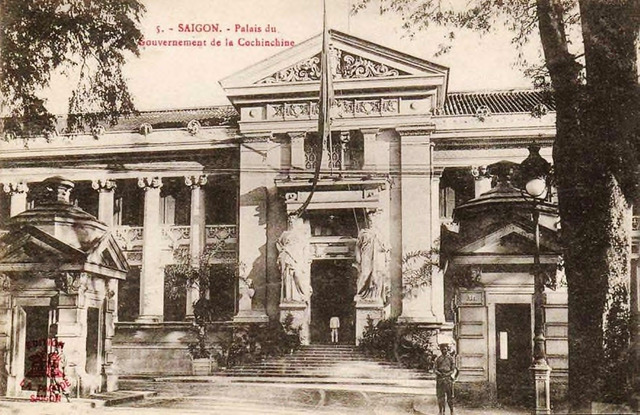 Fig. 26. Palace of the Governor General of South Vietnam (previously the Palace of the Lieutenant Governor). Today this is the Municipal Institute for the Arts. The upper level of the gate at the door and the two flanking statues are no longer extant. (by Alexandre Francis Decoly’s Edition La Pagode Saigon).
Fig. 26. Palace of the Governor General of South Vietnam (previously the Palace of the Lieutenant Governor). Today this is the Municipal Institute for the Arts. The upper level of the gate at the door and the two flanking statues are no longer extant. (by Alexandre Francis Decoly’s Edition La Pagode Saigon).
Decoly published images in Saigon from 1905 to 1924. He released postcard series and was situated at 10 Charner Avenue, the same location as the photographer Planté. Decoly and Planté were contemporaries, but Decoly was not a photographer—merely a businessman. Postcards bearing the symbol of a pagoda (pagode) in the corner are from Decoly’s firm. Later this symbol was replaced by the name of the business, Edition La Pagode Saigon. According to the 1910 Indochina Yearbook,[35] Decoly was at 36 Legrand de la Liraye Street (now Điện Biện Phủ Street): “Decoly, employed in commerce (Decoly, employé de commerce).”
He collected and printed images in black and white as well as color. He printed images of Laos, particularly those by Raquez, just as of Cambodia and other places in Indochina. It is possible that early postcards marked “A.F.D.” were his. Among later cards with corresponding images, the backs are marked “B. Frey et Cie., Saigon et Phnom-Penh” (1920–24).
Decoly’s images were still being sold into the late 1930s, but the address of 10 Charner Avenue was no longer a photography studio after 1922; rather, it was the headquarters of the business Commercial and Industrial Company of Indochina (Compagnie commerciale et industrielle de l’Indochine). Thus we could call these postcards the last by Decoly.[36]
 Fig. 26. Palace of the Governor General of South Vietnam (previously the Palace of the Lieutenant Governor). Today this is the Municipal Institute for the Arts. The upper level of the gate at the door and the two flanking statues are no longer extant. (by Alexandre Francis Decoly’s Edition La Pagode Saigon).
Fig. 26. Palace of the Governor General of South Vietnam (previously the Palace of the Lieutenant Governor). Today this is the Municipal Institute for the Arts. The upper level of the gate at the door and the two flanking statues are no longer extant. (by Alexandre Francis Decoly’s Edition La Pagode Saigon).Poujade de Ladevèze
Poujade de Ladevèze is known through images of Saigon from 1908 to 1922 in his series “Collection Poujade de Ladevèze.” He is listed in the yearbook of business in Saigon for 1922 as succeeding C. David. He published postcards very early, particularly in color.
Poujade de Ladevèze also definitely was not a photographer. He gathered and printed many images without recording the names of their photographers.[37] The 1909 Indochina Yearbook[38] lists the following: Poujade de Ladevèze, 7 Vannier Street (now Ngô Đức Kế) businessman (commerçant). The yearbook for 1910 records the address as 173B Catinat Street, market (marchand, also a commercial area).
Poujade de Ladevèze is known through images of Saigon from 1908 to 1922 in his series “Collection Poujade de Ladevèze.” He is listed in the yearbook of business in Saigon for 1922 as succeeding C. David. He published postcards very early, particularly in color.
Poujade de Ladevèze also definitely was not a photographer. He gathered and printed many images without recording the names of their photographers.[37] The 1909 Indochina Yearbook[38] lists the following: Poujade de Ladevèze, 7 Vannier Street (now Ngô Đức Kế) businessman (commerçant). The yearbook for 1910 records the address as 173B Catinat Street, market (marchand, also a commercial area).
Ludovic Crespin (1873–?)
Ludovic Crespin was a photographer with an establishment, called Photo Studio, at 136-38 Catinat Street (now Đồng Khởi Street) in 1910. Before this, 136 Catinat Street had been the address of “Madame Verray, artistic photographer,” as recorded in the 1908–1909 Indochina Yearbook: “Mme Verray, photographe artistique.” Therefore it is probable that Madame Verray passed on her photography firm to Crespin.
After the First World War, Crespin owned one more film studio, at 10 Charner Avenue. This means that he may have bought the photography business that had belonged to Pestel and then Planté. It is thus possible that he owned the legacies of many photographers, namely the images owned by Pestel. This explains the rich and wide-ranging productions that Crespin published from this period on. He created many postcards from his own images but also borrowed from those of others, such as Joseph Brignon, a postcard publisher active from 1925 to 1930.
Crespin also published books of images that he owned, such as an album of photographs of Cholon in 1909. In 1921, Crespin photographed the launching ceremony of the steamboat Albert Sarrault, over which Governor General Maurice Long presided. He published a photographic series called “Souvenir of Conchinchina and Cambodia” (Souvenir de Cochinchine et Cambodge), edited by the Saigon Business Office, showing images of Captain Joffre when he paid an official visit to Indochina in 1923. Following are a few images from Souvenir de Cochinchine et Cambodge.
 Fig. 30. Ludovic Crespin – Saigon at the start of the 1920s: Place de l’hôtel de ville, boulevard Bonnard, boulevard Charner. Municipal Hotel Plaza, corner of Bonnard (now Lệ Lợi) and Charner (now Nguyễn Huệ) Avenues. Right in the middle of Lệ Lợi is a public park with a statue of Francis Garnier facing the Municipal Theater. On the right is the shop “Auto-Hall,” which sold all kinds of automobiles. On the left is the establishment Pancrazi, which was open until the wee hours of the night. The cart-pullers on the right are staring in the direction of the photographer (Crespin)..
Fig. 30. Ludovic Crespin – Saigon at the start of the 1920s: Place de l’hôtel de ville, boulevard Bonnard, boulevard Charner. Municipal Hotel Plaza, corner of Bonnard (now Lệ Lợi) and Charner (now Nguyễn Huệ) Avenues. Right in the middle of Lệ Lợi is a public park with a statue of Francis Garnier facing the Municipal Theater. On the right is the shop “Auto-Hall,” which sold all kinds of automobiles. On the left is the establishment Pancrazi, which was open until the wee hours of the night. The cart-pullers on the right are staring in the direction of the photographer (Crespin)..
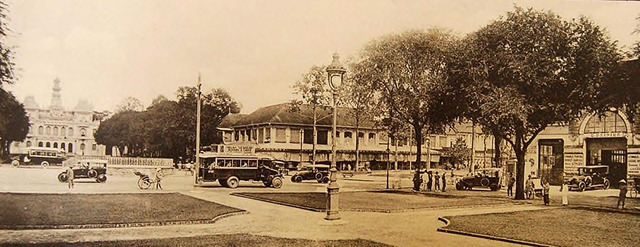 Fig. 31. Ludovic Crespin – Saigon at the start of the 1920s: Rond point entre le boulevard Charner et le boulevard Bonnard. Rotary at Nguyễn Huệ (Charner) and Lệ Lợi (Bonnard) Avenues. In the middle of the rotary is a round platform where musicians played classical or military pieces evenings at 7 o’clock, for the entertainment of the French. The Vietnamese called this intersection “Bugler’s Intersection.” Note the tour bus in the center with the advertisement on top: coiffre-art – Le Gaulois. On the right is the “Auto-Hall,” and Pancrazi on the next street.[39].
Crespin and his wife also ran a rubber plantation in Tam May (Biên Hòa). As Crespin was supervisor of a photography business and had experienced much activity for many years, Ernest Outrey, representative for Vietnam’s southern region in the French parliament, suggested in 1921 that he take responsibility for the exhibition and dissemination of photographs for the south in the 1922 Colonial Exposition at Marseille.
Despite the support of the Commercial Association of Saigon, the Council of Provincial Overseers, and the Saigon Municipal Council, Crespin would have had to cover the cost of enlarging photographic images as well as distribute one million free postcards at the exposition. He was hesitant and resisted the government and Ministry of Colonies in France, retaining his dignity by instead officially representing the Indochina Photo-cinematic Department (Service photo-cinématographique d l’Indochine).[40]
Although Crespin was not able to organize the photographic exhibition, he still made a respectable personal appearance at the 1922 Marseille Exposition. He had a series of sixteen images of local scenes from the southern region of Vietnam in the section for that area. According to the mayor of Saigon, Crespin was the only photographer with a collection so rich in all the architecture, statuary, and early scenes of the city.
Fig. 31. Ludovic Crespin – Saigon at the start of the 1920s: Rond point entre le boulevard Charner et le boulevard Bonnard. Rotary at Nguyễn Huệ (Charner) and Lệ Lợi (Bonnard) Avenues. In the middle of the rotary is a round platform where musicians played classical or military pieces evenings at 7 o’clock, for the entertainment of the French. The Vietnamese called this intersection “Bugler’s Intersection.” Note the tour bus in the center with the advertisement on top: coiffre-art – Le Gaulois. On the right is the “Auto-Hall,” and Pancrazi on the next street.[39].
Crespin and his wife also ran a rubber plantation in Tam May (Biên Hòa). As Crespin was supervisor of a photography business and had experienced much activity for many years, Ernest Outrey, representative for Vietnam’s southern region in the French parliament, suggested in 1921 that he take responsibility for the exhibition and dissemination of photographs for the south in the 1922 Colonial Exposition at Marseille.
Despite the support of the Commercial Association of Saigon, the Council of Provincial Overseers, and the Saigon Municipal Council, Crespin would have had to cover the cost of enlarging photographic images as well as distribute one million free postcards at the exposition. He was hesitant and resisted the government and Ministry of Colonies in France, retaining his dignity by instead officially representing the Indochina Photo-cinematic Department (Service photo-cinématographique d l’Indochine).[40]
Although Crespin was not able to organize the photographic exhibition, he still made a respectable personal appearance at the 1922 Marseille Exposition. He had a series of sixteen images of local scenes from the southern region of Vietnam in the section for that area. According to the mayor of Saigon, Crespin was the only photographer with a collection so rich in all the architecture, statuary, and early scenes of the city.
Ludovic Crespin was a photographer with an establishment, called Photo Studio, at 136-38 Catinat Street (now Đồng Khởi Street) in 1910. Before this, 136 Catinat Street had been the address of “Madame Verray, artistic photographer,” as recorded in the 1908–1909 Indochina Yearbook: “Mme Verray, photographe artistique.” Therefore it is probable that Madame Verray passed on her photography firm to Crespin.
After the First World War, Crespin owned one more film studio, at 10 Charner Avenue. This means that he may have bought the photography business that had belonged to Pestel and then Planté. It is thus possible that he owned the legacies of many photographers, namely the images owned by Pestel. This explains the rich and wide-ranging productions that Crespin published from this period on. He created many postcards from his own images but also borrowed from those of others, such as Joseph Brignon, a postcard publisher active from 1925 to 1930.
Crespin also published books of images that he owned, such as an album of photographs of Cholon in 1909. In 1921, Crespin photographed the launching ceremony of the steamboat Albert Sarrault, over which Governor General Maurice Long presided. He published a photographic series called “Souvenir of Conchinchina and Cambodia” (Souvenir de Cochinchine et Cambodge), edited by the Saigon Business Office, showing images of Captain Joffre when he paid an official visit to Indochina in 1923. Following are a few images from Souvenir de Cochinchine et Cambodge.
 Fig. 30. Ludovic Crespin – Saigon at the start of the 1920s: Place de l’hôtel de ville, boulevard Bonnard, boulevard Charner. Municipal Hotel Plaza, corner of Bonnard (now Lệ Lợi) and Charner (now Nguyễn Huệ) Avenues. Right in the middle of Lệ Lợi is a public park with a statue of Francis Garnier facing the Municipal Theater. On the right is the shop “Auto-Hall,” which sold all kinds of automobiles. On the left is the establishment Pancrazi, which was open until the wee hours of the night. The cart-pullers on the right are staring in the direction of the photographer (Crespin)..
Fig. 30. Ludovic Crespin – Saigon at the start of the 1920s: Place de l’hôtel de ville, boulevard Bonnard, boulevard Charner. Municipal Hotel Plaza, corner of Bonnard (now Lệ Lợi) and Charner (now Nguyễn Huệ) Avenues. Right in the middle of Lệ Lợi is a public park with a statue of Francis Garnier facing the Municipal Theater. On the right is the shop “Auto-Hall,” which sold all kinds of automobiles. On the left is the establishment Pancrazi, which was open until the wee hours of the night. The cart-pullers on the right are staring in the direction of the photographer (Crespin).. Fig. 31. Ludovic Crespin – Saigon at the start of the 1920s: Rond point entre le boulevard Charner et le boulevard Bonnard. Rotary at Nguyễn Huệ (Charner) and Lệ Lợi (Bonnard) Avenues. In the middle of the rotary is a round platform where musicians played classical or military pieces evenings at 7 o’clock, for the entertainment of the French. The Vietnamese called this intersection “Bugler’s Intersection.” Note the tour bus in the center with the advertisement on top: coiffre-art – Le Gaulois. On the right is the “Auto-Hall,” and Pancrazi on the next street.[39].
Fig. 31. Ludovic Crespin – Saigon at the start of the 1920s: Rond point entre le boulevard Charner et le boulevard Bonnard. Rotary at Nguyễn Huệ (Charner) and Lệ Lợi (Bonnard) Avenues. In the middle of the rotary is a round platform where musicians played classical or military pieces evenings at 7 o’clock, for the entertainment of the French. The Vietnamese called this intersection “Bugler’s Intersection.” Note the tour bus in the center with the advertisement on top: coiffre-art – Le Gaulois. On the right is the “Auto-Hall,” and Pancrazi on the next street.[39].
Crespin and his wife also ran a rubber plantation in Tam May (Biên Hòa). As Crespin was supervisor of a photography business and had experienced much activity for many years, Ernest Outrey, representative for Vietnam’s southern region in the French parliament, suggested in 1921 that he take responsibility for the exhibition and dissemination of photographs for the south in the 1922 Colonial Exposition at Marseille.
Despite the support of the Commercial Association of Saigon, the Council of Provincial Overseers, and the Saigon Municipal Council, Crespin would have had to cover the cost of enlarging photographic images as well as distribute one million free postcards at the exposition. He was hesitant and resisted the government and Ministry of Colonies in France, retaining his dignity by instead officially representing the Indochina Photo-cinematic Department (Service photo-cinématographique d l’Indochine).[40]
Although Crespin was not able to organize the photographic exhibition, he still made a respectable personal appearance at the 1922 Marseille Exposition. He had a series of sixteen images of local scenes from the southern region of Vietnam in the section for that area. According to the mayor of Saigon, Crespin was the only photographer with a collection so rich in all the architecture, statuary, and early scenes of the city.
Fernand Nadal
Nadal was an Arab, born in Algeria (possibly Hussein-Dey in 1898 or El Affroun in 1902). He came to Indochina at the start of the 1920s. In 1921, he was situated at 150 Catinat Street, Saigon.[41] It is possible that he was the first Algerian to come to Saigon and open a business.
Several of his images were printed in the periodical Le Monde colonial illustré between 1929 and 1931, and the administration of the governor general of Indochina also used his photographs. He created many official news photos for the French government in the southern region of Vietnam, such as images of the 11th Colonial Regiment, government offices, and monuments in Saigon.
Among Saigon businesses in 1922, Nadal’s establishment was one that took photographs and sold photographic equipment and accessories. Nadal employed one European and six Vietnamese. Sometimes he did photographic work for the government. He also took photographs for the masters of various estates and for hotels at tourist sites such as Angkor, also shooting several series of advertising images for businesses in Saigon. Furthermore, he printed photographic albums and postcards and supervised a similar photographic studio in Phnom Penh.
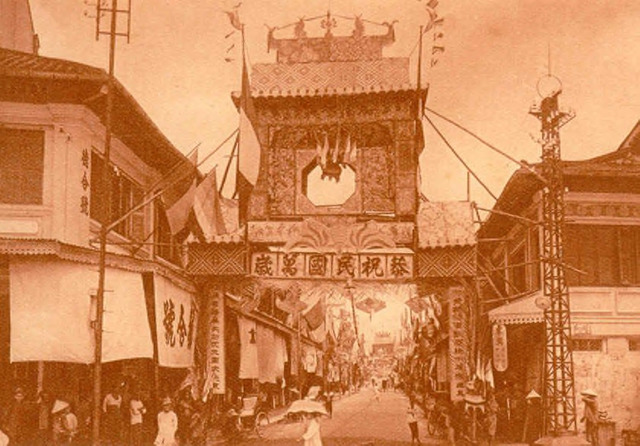 Fig. 32. Fernand Nadal, from Album Nadal, 1926: Canton Street (now Triệu Quang Phục). This image also appeared as a postcard. Probably it is the national holiday commemorating the establishment of the Republic of China on October 10, 1911. At the head and end of the street are congratulatory gates with the Chinese inscription, “Ten thousand years to the Republic.” [42] On the left side of the gate hang the tricolor flags of France.
Nadal photographed large industrial concerns and neighboring areas in Saigon. Between 1923 and 1924, he photographed Industrial Biên Hòa (La Bien-Hoa Industrielle) for the lumber concern the Society of Forestry (La Société forestiere), which at that time monopolized the export of wood in Indochina. In 1930, he made a photographic news report of the official visit to Hanoi of Dwight Davis, governor of the Philippines (then an American colony).
In 1935, postcards by Nadal bore the address 10 Catinat Street. At the start of the 1950s, he was still producing them.
Fig. 32. Fernand Nadal, from Album Nadal, 1926: Canton Street (now Triệu Quang Phục). This image also appeared as a postcard. Probably it is the national holiday commemorating the establishment of the Republic of China on October 10, 1911. At the head and end of the street are congratulatory gates with the Chinese inscription, “Ten thousand years to the Republic.” [42] On the left side of the gate hang the tricolor flags of France.
Nadal photographed large industrial concerns and neighboring areas in Saigon. Between 1923 and 1924, he photographed Industrial Biên Hòa (La Bien-Hoa Industrielle) for the lumber concern the Society of Forestry (La Société forestiere), which at that time monopolized the export of wood in Indochina. In 1930, he made a photographic news report of the official visit to Hanoi of Dwight Davis, governor of the Philippines (then an American colony).
In 1935, postcards by Nadal bore the address 10 Catinat Street. At the start of the 1950s, he was still producing them.
Nadal was an Arab, born in Algeria (possibly Hussein-Dey in 1898 or El Affroun in 1902). He came to Indochina at the start of the 1920s. In 1921, he was situated at 150 Catinat Street, Saigon.[41] It is possible that he was the first Algerian to come to Saigon and open a business.
Several of his images were printed in the periodical Le Monde colonial illustré between 1929 and 1931, and the administration of the governor general of Indochina also used his photographs. He created many official news photos for the French government in the southern region of Vietnam, such as images of the 11th Colonial Regiment, government offices, and monuments in Saigon.
Among Saigon businesses in 1922, Nadal’s establishment was one that took photographs and sold photographic equipment and accessories. Nadal employed one European and six Vietnamese. Sometimes he did photographic work for the government. He also took photographs for the masters of various estates and for hotels at tourist sites such as Angkor, also shooting several series of advertising images for businesses in Saigon. Furthermore, he printed photographic albums and postcards and supervised a similar photographic studio in Phnom Penh.
 Fig. 32. Fernand Nadal, from Album Nadal, 1926: Canton Street (now Triệu Quang Phục). This image also appeared as a postcard. Probably it is the national holiday commemorating the establishment of the Republic of China on October 10, 1911. At the head and end of the street are congratulatory gates with the Chinese inscription, “Ten thousand years to the Republic.” [42] On the left side of the gate hang the tricolor flags of France.
Fig. 32. Fernand Nadal, from Album Nadal, 1926: Canton Street (now Triệu Quang Phục). This image also appeared as a postcard. Probably it is the national holiday commemorating the establishment of the Republic of China on October 10, 1911. At the head and end of the street are congratulatory gates with the Chinese inscription, “Ten thousand years to the Republic.” [42] On the left side of the gate hang the tricolor flags of France.
Nadal photographed large industrial concerns and neighboring areas in Saigon. Between 1923 and 1924, he photographed Industrial Biên Hòa (La Bien-Hoa Industrielle) for the lumber concern the Society of Forestry (La Société forestiere), which at that time monopolized the export of wood in Indochina. In 1930, he made a photographic news report of the official visit to Hanoi of Dwight Davis, governor of the Philippines (then an American colony).
In 1935, postcards by Nadal bore the address 10 Catinat Street. At the start of the 1950s, he was still producing them.
Võ An Ninh (1907–2009)[43]
Võ An Ninh, originally Vũ An Tuyết, was born June 16, 1907, on Hàng Gai Street in Hanoi. Immediately from childhood, he had a passion for photography. In the colonial period, he worked as a photographic correspondent for the Department of Forestry. In 1935, his photograph “Morning on the Red River” took special prize in a contest organized by the Vietnamese Society for the Encouragement of Art and Industry (Société Annamite d’encouregement à l’Art et l’Industrie). In 1938, his image “Loaded Ships Departing” received a special award at a photographic exhibition in Paris.
Võ An Ninh went everywhere in the northern, central, and southern regions of Vietnam to take photographs with his 1928 German Zeiss Ikon. Every day until near the end of his life (2000), he still used only this handheld camera with monochrome film.
In Hanoi, he took many famous images of the Lake of the Sword, such as “Lake of the Sword in Morning Frost” (1935) and the lake as featured in the four images “Hanoi in Four Seasons.” In addition to this, he took nostalgic images of Hanoi in its elegant past: “In the Banyan Tree Garden at Voi Phục Temple” (1942), “South Wind” (Dike on the Red River, 1948), “Remembering the Past” (1944), “Rearing Silkworms at Nghi Tàm” (1956), “Young Women of Hanoi” (1960), “Stone Steps at Voi Phục Temple” (1956), “Láng Temple” (1941), “Elderly Scholars Writing New Year Couplets” (1940), “New Year Paintings in Hồ Village” (1941), “Street of Sail Shops” (1940), “Old Roof on the Street of Silver Brokers” (1956), “Quang Chương City Gate” (1940), “Hill of Banyan Trees” (1942), “The Constellation of Literature Pavilion and Graduates’ Steles in the Temple of Literature” (1945), “Dawn on the Fields of Phúc Xá” (1944), “Rickshaw in the Suburbs” (1935), “Gathering the Rice Harvest” (1935), “Winter Returns” (Từ Liêm, 1935), “Pier at the Earthen Bridge” (1935), “Pottery Market” (Bươi, 1935), “Đồng Xuân Market” (1956) and “Lotus at West Lake” (1941).
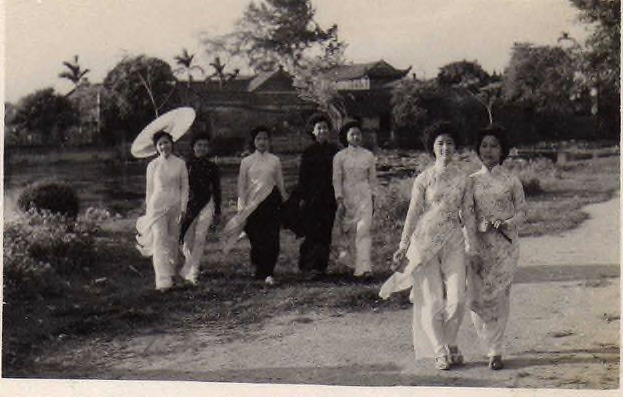 Fig. 33. Võ An Ninh, Summer Afternoon at West Lake, Hanoi, 1954. At this time, West Lake was still desolate. The young women in traditional tunics (áo dài) breeze through the summer afternoon. A stroke of elegance from Hanoi in the early 1950s. Collection of the author.
A number of his skillful images of Saigon have value as both art and social documentation, such as “Bến Thành Market with Station for Horse-drawn Carriages” (1949), “Elderly Scholars Writing New Year Couplets” (Saigon, 1950), “Royal Tomb on a Festival Day” (1952), “Mosque” (1950), “Incense Smoke at Bà Temple, Cholon” (1953), “Young Women of Saigon” (1951), “Crossing the Bridge” (Thủ Đức, 1953), “Alone” (1941), “Germination” (1942), “Thorn Tree Garden in the Suburbs” (1950), “Day of Honoring Buddhist Relics” (1951), “Easter Night” (1950), and “Dawn on the River” (1952).
Another valuable group of images in Võ An Ninh’s body of work are scenes from the famine of 1945, which witness conditions created by Japanese and French occupation in the northern region of our country. There are scenes of people dying of starvation in the streets of Hanoi, and in the streets from every province (although Thái Bình was most severely hit) to the capital city, human corpses filling carts already full. This rich series is the only one in Vietnam on the famine of 1945.
Fig. 33. Võ An Ninh, Summer Afternoon at West Lake, Hanoi, 1954. At this time, West Lake was still desolate. The young women in traditional tunics (áo dài) breeze through the summer afternoon. A stroke of elegance from Hanoi in the early 1950s. Collection of the author.
A number of his skillful images of Saigon have value as both art and social documentation, such as “Bến Thành Market with Station for Horse-drawn Carriages” (1949), “Elderly Scholars Writing New Year Couplets” (Saigon, 1950), “Royal Tomb on a Festival Day” (1952), “Mosque” (1950), “Incense Smoke at Bà Temple, Cholon” (1953), “Young Women of Saigon” (1951), “Crossing the Bridge” (Thủ Đức, 1953), “Alone” (1941), “Germination” (1942), “Thorn Tree Garden in the Suburbs” (1950), “Day of Honoring Buddhist Relics” (1951), “Easter Night” (1950), and “Dawn on the River” (1952).
Another valuable group of images in Võ An Ninh’s body of work are scenes from the famine of 1945, which witness conditions created by Japanese and French occupation in the northern region of our country. There are scenes of people dying of starvation in the streets of Hanoi, and in the streets from every province (although Thái Bình was most severely hit) to the capital city, human corpses filling carts already full. This rich series is the only one in Vietnam on the famine of 1945.
Võ An Ninh, originally Vũ An Tuyết, was born June 16, 1907, on Hàng Gai Street in Hanoi. Immediately from childhood, he had a passion for photography. In the colonial period, he worked as a photographic correspondent for the Department of Forestry. In 1935, his photograph “Morning on the Red River” took special prize in a contest organized by the Vietnamese Society for the Encouragement of Art and Industry (Société Annamite d’encouregement à l’Art et l’Industrie). In 1938, his image “Loaded Ships Departing” received a special award at a photographic exhibition in Paris.
Võ An Ninh went everywhere in the northern, central, and southern regions of Vietnam to take photographs with his 1928 German Zeiss Ikon. Every day until near the end of his life (2000), he still used only this handheld camera with monochrome film.
In Hanoi, he took many famous images of the Lake of the Sword, such as “Lake of the Sword in Morning Frost” (1935) and the lake as featured in the four images “Hanoi in Four Seasons.” In addition to this, he took nostalgic images of Hanoi in its elegant past: “In the Banyan Tree Garden at Voi Phục Temple” (1942), “South Wind” (Dike on the Red River, 1948), “Remembering the Past” (1944), “Rearing Silkworms at Nghi Tàm” (1956), “Young Women of Hanoi” (1960), “Stone Steps at Voi Phục Temple” (1956), “Láng Temple” (1941), “Elderly Scholars Writing New Year Couplets” (1940), “New Year Paintings in Hồ Village” (1941), “Street of Sail Shops” (1940), “Old Roof on the Street of Silver Brokers” (1956), “Quang Chương City Gate” (1940), “Hill of Banyan Trees” (1942), “The Constellation of Literature Pavilion and Graduates’ Steles in the Temple of Literature” (1945), “Dawn on the Fields of Phúc Xá” (1944), “Rickshaw in the Suburbs” (1935), “Gathering the Rice Harvest” (1935), “Winter Returns” (Từ Liêm, 1935), “Pier at the Earthen Bridge” (1935), “Pottery Market” (Bươi, 1935), “Đồng Xuân Market” (1956) and “Lotus at West Lake” (1941).
 Fig. 33. Võ An Ninh, Summer Afternoon at West Lake, Hanoi, 1954. At this time, West Lake was still desolate. The young women in traditional tunics (áo dài) breeze through the summer afternoon. A stroke of elegance from Hanoi in the early 1950s. Collection of the author.
Fig. 33. Võ An Ninh, Summer Afternoon at West Lake, Hanoi, 1954. At this time, West Lake was still desolate. The young women in traditional tunics (áo dài) breeze through the summer afternoon. A stroke of elegance from Hanoi in the early 1950s. Collection of the author.
A number of his skillful images of Saigon have value as both art and social documentation, such as “Bến Thành Market with Station for Horse-drawn Carriages” (1949), “Elderly Scholars Writing New Year Couplets” (Saigon, 1950), “Royal Tomb on a Festival Day” (1952), “Mosque” (1950), “Incense Smoke at Bà Temple, Cholon” (1953), “Young Women of Saigon” (1951), “Crossing the Bridge” (Thủ Đức, 1953), “Alone” (1941), “Germination” (1942), “Thorn Tree Garden in the Suburbs” (1950), “Day of Honoring Buddhist Relics” (1951), “Easter Night” (1950), and “Dawn on the River” (1952).
Another valuable group of images in Võ An Ninh’s body of work are scenes from the famine of 1945, which witness conditions created by Japanese and French occupation in the northern region of our country. There are scenes of people dying of starvation in the streets of Hanoi, and in the streets from every province (although Thái Bình was most severely hit) to the capital city, human corpses filling carts already full. This rich series is the only one in Vietnam on the famine of 1945.
Conclusion
This article is only a brief outline of the history of photography in Vietnam and a contribution to material on photographers in the region from the end of the nineteenth century to the start of the twentieth. They came from France, China, Vietnam, and other countries, probably with the initial intention only to be passionate about photography and live by its craft. At the same time, they brought into being materials that not only have value as art, as most of them hoped, but also have a value for history, culture, and society that we have not yet fully put to use.
The author believes that many photographic materials are scattered throughout private collections all over the world, just as in archives, such as France’s National Overseas Archives (Archives nationales d’outre mer ANOM) or in Vietnam, where presently they have not received sufficient attention. If a museum of photography could be founded in Vietnam, it would be a place for materials to converge, where private collectors could contribute to research—inside and outside of the country—on problems and topics in history, culture, and society in nineteenth- and twentieth-century Vietnam.
Nguyễn Ðức Hiệp is a biomedical engineer who has published scientific papers in journals such as Atmospheric Environment, Journal of Climatology, Australian and New Zealand Journal of Statistics, and Journal of Air & Waste Management. In addition to his scientific work, he also an independent researcher in the field of Vietnamese history from the nineteenth to the early twentieth century, especially the history of Cochinchina under the French period.
Ellen Takata holds her AB in Visual and Environmental Studies (oil painting and Japanese theater) and her MA in Regional Studies - East Asia (the writings of Trinh Hoai Duc in the context of Minh Huong histories in Vietnam) from Harvard University, as well as a Postgraduate Diploma in Fine Art from Goldsmiths College, University of London. She is employed currently as Research Fellow for Asian Art at the Museum of Fine Arts, Boston.
Bibliography
- Annuaire général Administratif, Commercial et Industriel de l’Indo-Chine. Hanoi: Imprimerie F.-H. Schneider, 1908, 1909, 1910, 1911.
- “Chronique, Cochinchine.” Bulletin de l’Ecole française d'Extrême-Orient Année 1933, vol. 33, no. 33: 1110–11.
- Claeys, J. Y., and Martin Hurlimann. “Ceylan et l’Indochine, architecture, paysages, scènes populaires.” Bulletin de l’École française d’Extrême-Orient, 1930, vol. 30, no. 30: 180–81.
- Creed, Barbara, and Jeanette Hoorn. “Memory and History: Early Film, Colonialism, and the French Civilising Mission in Indochina.” French History and Civilization, Papers from the George Rudé Seminar, vol. 4. eds. Briony Neilson and Robert Aldrich, 2011. [Formerly http://www.h-france.net/rude/rudevoliv/CreedHoornVol4.pdf]
- Daniel, Malcolm. “Daguerre (1787–1851) and the Invention of Photography.” The Metropolitan Museum of Art.http://www.metmuseum.org/toah/hd/dagu/hd_dagu.htm
- ———. “The Daguerreian Age in France: 1839–1855.” Heilbrunn Timeline of Art History. New York: The Metropolitan Museum of Art, 2000–. http://www.metmuseum.org/toah/hd/fdag/hd_fdag.htm (October 2004)
- ———. “The Rise of Paper Photography in 1850s France.” Heilbrunn Timeline of Art History. New York: The Metropolitan Museum of Art, 2000–. http://www.metmuseum.org/toah/hd/frph/hd_frph.htm (September 2008)
- Degroise, Marie-Hélène. Photographes en Outre-Mer (1840–1944). http://photographesenoutremer.blogspot.com
- Diplomatic Archives of France. [Formerly http://www.archivesnationales.culture.gouv.fr/anom/fr/11_anc.documents/0905_Pestel/Pestel.html]
- du Caillaud, Romanet. “La Conquête du delta du Tong-King.” Le Tour du Monde, vol. XXXIV(1877), second half of the year. http://collin.francois.free.fr/Le_tour_du_monde/Frame7_textes/TdM_frame7.htm
- Goloubew, Victor. “V.-T. Holbé.” Bulletin de l’Ecole française d'Extrême-Orient Année 1927, vol. 27, no. 27: 525.
- Guillaume, Xavier. La terre du Dragon, Tome 1. Paris: Publibook, 2004.
- Keay, John. “The Mekong Exploration Commission 1866–68: Anglo-French Rivalry in Southeast Asia.” Asian Affairs, vol. XXXVI, no. III, November 2005. http://end-of-empires-south-east-asia.wikispaces.com/file/view/THE+MEKONG+EXPLORATION+COMMISSION.pdf
- Nguyễn Đình Đầu. “Tìm lại cầu tàu nơi Bác Hồ rời cảng Sài Gòn.” Báo Lao Động 4, June 2011. [Formerly http://laodong.com.vn/Tin-Tuc/Tim-lai-cau-tau-noi-Bac-Ho-roi-cang-Sai-Gon/45151]
- Nguyễn Đức Hiệp. “Võ An Ninh: Nhiếp ảnh và cuộc đời.” 2009. http://www.vannghesongcuulong.org/index.php?comp=tacpham&action=detail&id=10502
- Phạm Phú Thứ. Tây hành nhật ký. Tô Văn Nguyễn Đình Diệm và Văn Vĩnh. Tp HCM: Nxb Văn Nghệ, 2001.
- Voyage d'exploration en indochine: par les lieutenants Francis Garnier et Delaporte.” Le Tour du Monde, vol. XXII (1870), second half of the year: 305–21.http://collin.francois.free.fr/Le_tour_du_monde/Frame7_textes/TdM_frame7.htm
- Vương Hồng Sển. Saigon năm xưa. Nxb Tp Hồ Chí Minh, 1991.
Notes
-
Translator’s note: I am very grateful to Nguyễn Ðức Hiệp and Trans-Asia Photography Review for the opportunity to make this translation of “Nhiếp ảnh ở Việt Nam từ cuối thế kỷ 19 đến thế kỷ 20,” which appeared originally in five parts in Diễn Đàn (http://www.diendan.org/phe-binh-nghien-cuu/nhiep-anh-o-vn) in 2012 and also in Tap chi Nghien cuu va phat Trien (http://www.vjol.info/index.php/ncpt-hue/issue/view/858/showToc) in the same year.
According to the bibliographic information in the original, images are taken from the following sources unless otherwise noted: http://www.flickr.com/photos/13476480@N07/collections/ andhttp://belleindochine.free.fr/Saigon1882.htm.
For our present purposes, I have reformatted the text into three parts: an introduction, a chronology of photographic studios, and a conclusion. Similarly, I have incorporated the original’s two reference systems (endnotes and bibliographic citations) into a single set of notes with a bibliography. I also have translated French passages and publication titles into English on first mention in the body of the article and used the French for subsequent mentions, and omitted Vietnamese diacriticals for place-names commonly used in English (e.g., Saigon and Danang). In addition, you will find a few explanatory notes that bear my initials: ET.

-
Phan Châu Trinh (1872–1926) is revered as an early proponent of Vietnamese nationalism whose proposals tended towards moderation, Nguyễn An Ninh (1900–1943) was an anticolonial journalist who died during related imprisonment, and “Nguyễn Ái Quốc” is one of the better-known pseudonyms of Hồ Chí Minh (1890–1969). – ET.

-
Marie-Hélène Degroise, Photographes en Outre-Mer (1840–1944), http://photographesenoutremer.blogspot.com.

-
This film by the Lumière brothers was shot by Gabriel Veyre in a village near Danang and shown in 1900 in many places in France and the rest of Europe in the early years of film history. It can be seen at [formerly http://www.youtube.com/watch?v=9dk15FlvRj4]. Their second film in Vietnam was Indochine: Enfants annamites ramassant des sépèques devant la Pagode des dames (1903); you may view it athttp://www.youtube.com/watch?v=WH5NZo8Mm0M. The third was Déchargement du Four à Briques. Commentary and detailed study of this film can be found in Barbara Creed and Jeanette Hoorn, “Memory and History: Early Film, Colonialism and the French Civilising Mission in Indochina,” in French History and Civilization, Papers from the George Rudé Seminar, vol. 4, eds. Briony Neilson and Robert Aldrich, 2011, [formerly http://www.h-france.net/rude/rudevoliv/CreedHoornVol4.pdf].

-
Malcolm Daniel, “The Daguerreian Age in France: 1839–1855,” in the Heilbrunn Timeline of Art History, New York: The Metropolitan Museum of Art, 2000–, http://www.metmuseum.org/toah/hd/fdag/hd_fdag.htm(October 2004).

-
Malcolm Daniel, “Daguerre (1787–1851) and the Invention of Photography,” The Metropolitan Museum of Art, http://www.metmuseum.org/toah/hd/dagu/hd_dagu.htm.

-
For images of cameras past and present, see http://www.collection-appareils.fr/general/html/listeD_imagettes.php?RadioGroup1=chrono&submit=Trier.

-
For images of cameras past and present, see http://www.collection-appareils.fr/general/html/listeD_imagettes.php?RadioGroup1=chrono&submit=Trier.

-
-
-
Images are taken from http://www.flickr.com/photos/13476480@N07/collections andhttp://belleindochine.free.fr/Saigon1882.htm.

-
Images are taken from the following http://www.flickr.com/photos/13476480@N07/collections andhttp://belleindochine.free.fr/Saigon1882.htm.

-
-
Malcolm Daniel, “The Rise of Paper Photography in 1850s France,” in the Heilbrunn Timeline of Art History, New York: The Metropolitan Museum of Art, 2000–, http://www.metmuseum.org/toah/hd/frph/hd_frph.htm(September 2008).

-
Romanet du Caillaud, “La Conquête du delta du Tong-Kin,” in Le Tour du Monde, vol. XXXIV – 1877 – 2nd semestre, http://collin.francois.free.fr/Le_tour_du_monde/Frame7_textes/TdM_frame7.htm.

-
Marie-Hélène Degroise, Photographes en Outre-Mer (1840–1944), http://photographesenoutremer.blogspot.com.

-
See this album at http://www.liveauctioneers.com/item/4482940.

-
-
After more than two thousand kilometers of exploration along the Mekong, Doudart de Lagrée died of exhaustion and liver disease in Yunnan. Carné also succumbed to exhaustion after the expedition. On the path to Côn Minh, the expedition team almost accidentally discovered the source of the Red River flowing into the Gulf of Tonkin. Rather than follow the Mekong down from Saigon Harbor (then under French rule) to Yunnan, they took the most convenient shortcut, from Haiphong to Yunnan along the Red River. In reality, this was an opportunity for France to attack the northern region of Vietnam. History would have it differently, as though this opportunity never existed. From Côn Minh, the team took a northern route to the province of Tứ Xuyên, over the source of the Dương Tử River. From here, they went downstream to the coast near Shanghai, then returned to Saigon along the coastal route. After this famous expedition, Garnier received an award from the Royal Geographic Society of England and his explorations were compared to the arduous experiences of Dr. Livingston in the Congo. See John Keay, “The Mekong Exploration Commission 1866–68: Anglo-French rivalry in South East Asia,” in Asian Affairs, vol. XXXVI, no. III, November 2005, http://end-of-empires-south-east-asia.wikispaces.com/file/view/THE+MEKONG+EXPLORATION+COMMISSION.pdf.

-
-
Diplomatic Archives of France, http://www.archivesnationales.culture.gouv.fr/anom/en/Action-culturelle/Dossiers-du-mois/0905-Pestel/Dossier-Pestel.html

-
The series title cited in the original article is “Main de lettré annamite,” literally, “Hand of a Vietnamese man of letters,” a subject commonly photographed as a curiosity for its long nails symbolizing the intellectual’s traditional exemption from manual labor. It seems likely that this title was designated one image in a series otherwise devoted to portraits of the men of letters themselves, and I have changed the wording to reflect this. – ET

-
Figs. 13 and 14: Marie-Hélène Degroise, Photographes en Outre-Mer (1840-1944),http://photographesenoutremer.blogspot.com/

-
Marie-Hélène Degroise, Photographes en Outre-Mer (1840-1944),http://photographesenoutremer.blogspot.com/.

-
Marie-Hélène Degroise, Photographes en Outre-Mer (1840–1944), http://photographesenoutremer.blogspot.com.

-
-
-
Just after release from prison at Santé in 1915, Phan Châu Trinh also had a period of working as a photographic developer for Khánh Ký in France. Indeed, Phan Châu Trinh also brought Nguyễn Ái Quốc (one of the better-known pseudonyms of Hồ Chí Minh – ET) to Khánh Ký’s shop in order to learn a trade to support himself during his struggles in Paris.

-
-
Prince Cường Để was a descendant of Prince Cảnh, son of the founder of Vietnam’s Nguyễn Dynasty, which lasted from 1802 to 1954. He was brought to Japan as a young man by Phan Bội Châu, who suggested that he might become emperor as part of a plan to restore Vietnam as an independent monarchy (a destiny that he awaited in Japan until his death). – ET

-
-
See source image on Delcampe, at: http://www.delcampe.net/page/item/id,145081839,var,KHANH-KY-CIE-54-BD-BONNARD-TELEPHONE-410-DANSEUSES,language,E.html#.Uy8P_hGPLz4.

-
Marie-Hélène Degroise, Photographes en Outre-Mer (1840–1944), http://photographesenoutremer.blogspot.com.

-
-
-
Marie-Hélène Degroise, Photographes en Outre-Mer (1840–1944), http://photographesenoutremer.blogspot.com.

-
Marie-Hélène Degroise, Photographes en Outre-Mer (1840–1944), http://photographesenoutremer.blogspot.com.

-
-
According to Vương Hồng Sển, Pancrazi was one of four establishments near the intersection of Nguyễn Huệ and Lệ Lợi Streets, which he has described as follows: “At the four corners of Bugler’s Intersection were a place with European wines, open from 6 pm to 2 am, after which only Pancrazi was the most tolerable. The Café de la musique at the corner of Tự Do and Lệ Lợi was across from the European Music Hall (Nhà Hát Tây), which in 1905 passed to the owner of Pancrazi, then to the European pharmacy Solirène, and finally to the ice-cream seller Givral. See Vương Hồng Sển, Saigon năm xưa, Nxb Tp Hồ Chí Minh, 1991.

-
Marie-Hélène Degroise, Photographes en Outre-Mer (1840–1944), http://photographesenoutremer.blogspot.com.

-
Marie-Hélène Degroise, Photographes en Outre-Mer (1840–1944), http://photographesenoutremer.blogspot.com.

-
(original endnote 6) In Cholon at the time, Chinese (aside from the descendants of Minh Hương [Ming Loyalists who had come to Vietnam in the seventeenth century – ET]) were seen as foreigners and openly hosted active branches of the Guomindang. Triệu Quang Phục Street was one of several business centers in Cholon, where the Chinese were mostly from Guangdong. On the corner of Triệu Quang Phục and Nguyễn Trãi (then Cay-mai) Streets is the Temple of the Empress of Heaven, one of the oldest temples in Cholon and also a meeting place for Cantonese (the Tuệ Thành Hội quán).

-
Nguyễn Đức Hiệp, “Võ An Ninh: Nhiếpảnh và cuộc đời, 2009,”http://www.vannghesongcuulong.org/index.php?comp=tacpham&action=detail&id=10502.

Translator’s note: I am very grateful to Nguyễn Ðức Hiệp and Trans-Asia Photography Review for the opportunity to make this translation of “Nhiếp ảnh ở Việt Nam từ cuối thế kỷ 19 đến thế kỷ 20,” which appeared originally in five parts in Diễn Đàn (http://www.diendan.org/phe-binh-nghien-cuu/nhiep-anh-o-vn) in 2012 and also in Tap chi Nghien cuu va phat Trien (http://www.vjol.info/index.php/ncpt-hue/issue/view/858/showToc) in the same year.
According to the bibliographic information in the original, images are taken from the following sources unless otherwise noted: http://www.flickr.com/photos/13476480@N07/collections/ andhttp://belleindochine.free.fr/Saigon1882.htm.
For our present purposes, I have reformatted the text into three parts: an introduction, a chronology of photographic studios, and a conclusion. Similarly, I have incorporated the original’s two reference systems (endnotes and bibliographic citations) into a single set of notes with a bibliography. I also have translated French passages and publication titles into English on first mention in the body of the article and used the French for subsequent mentions, and omitted Vietnamese diacriticals for place-names commonly used in English (e.g., Saigon and Danang). In addition, you will find a few explanatory notes that bear my initials: ET.

Phan Châu Trinh (1872–1926) is revered as an early proponent of Vietnamese nationalism whose proposals tended towards moderation, Nguyễn An Ninh (1900–1943) was an anticolonial journalist who died during related imprisonment, and “Nguyễn Ái Quốc” is one of the better-known pseudonyms of Hồ Chí Minh (1890–1969). – ET. 

Marie-Hélène Degroise, Photographes en Outre-Mer (1840–1944), http://photographesenoutremer.blogspot.com.

This film by the Lumière brothers was shot by Gabriel Veyre in a village near Danang and shown in 1900 in many places in France and the rest of Europe in the early years of film history. It can be seen at [formerly http://www.youtube.com/watch?v=9dk15FlvRj4]. Their second film in Vietnam was Indochine: Enfants annamites ramassant des sépèques devant la Pagode des dames (1903); you may view it athttp://www.youtube.com/watch?v=WH5NZo8Mm0M. The third was Déchargement du Four à Briques. Commentary and detailed study of this film can be found in Barbara Creed and Jeanette Hoorn, “Memory and History: Early Film, Colonialism and the French Civilising Mission in Indochina,” in French History and Civilization, Papers from the George Rudé Seminar, vol. 4, eds. Briony Neilson and Robert Aldrich, 2011, [formerly http://www.h-france.net/rude/rudevoliv/CreedHoornVol4.pdf].

Malcolm Daniel, “The Daguerreian Age in France: 1839–1855,” in the Heilbrunn Timeline of Art History, New York: The Metropolitan Museum of Art, 2000–, http://www.metmuseum.org/toah/hd/fdag/hd_fdag.htm(October 2004). 

Malcolm Daniel, “Daguerre (1787–1851) and the Invention of Photography,” The Metropolitan Museum of Art, http://www.metmuseum.org/toah/hd/dagu/hd_dagu.htm.

For images of cameras past and present, see http://www.collection-appareils.fr/general/html/listeD_imagettes.php?RadioGroup1=chrono&submit=Trier. 

For images of cameras past and present, see http://www.collection-appareils.fr/general/html/listeD_imagettes.php?RadioGroup1=chrono&submit=Trier.

Images are taken from http://www.flickr.com/photos/13476480@N07/collections andhttp://belleindochine.free.fr/Saigon1882.htm.

Images are taken from the following http://www.flickr.com/photos/13476480@N07/collections andhttp://belleindochine.free.fr/Saigon1882.htm.

Malcolm Daniel, “The Rise of Paper Photography in 1850s France,” in the Heilbrunn Timeline of Art History, New York: The Metropolitan Museum of Art, 2000–, http://www.metmuseum.org/toah/hd/frph/hd_frph.htm(September 2008).

Romanet du Caillaud, “La Conquête du delta du Tong-Kin,” in Le Tour du Monde, vol. XXXIV – 1877 – 2nd semestre, http://collin.francois.free.fr/Le_tour_du_monde/Frame7_textes/TdM_frame7.htm.

Marie-Hélène Degroise, Photographes en Outre-Mer (1840–1944), http://photographesenoutremer.blogspot.com.

See this album at http://www.liveauctioneers.com/item/4482940. 

After more than two thousand kilometers of exploration along the Mekong, Doudart de Lagrée died of exhaustion and liver disease in Yunnan. Carné also succumbed to exhaustion after the expedition. On the path to Côn Minh, the expedition team almost accidentally discovered the source of the Red River flowing into the Gulf of Tonkin. Rather than follow the Mekong down from Saigon Harbor (then under French rule) to Yunnan, they took the most convenient shortcut, from Haiphong to Yunnan along the Red River. In reality, this was an opportunity for France to attack the northern region of Vietnam. History would have it differently, as though this opportunity never existed. From Côn Minh, the team took a northern route to the province of Tứ Xuyên, over the source of the Dương Tử River. From here, they went downstream to the coast near Shanghai, then returned to Saigon along the coastal route. After this famous expedition, Garnier received an award from the Royal Geographic Society of England and his explorations were compared to the arduous experiences of Dr. Livingston in the Congo. See John Keay, “The Mekong Exploration Commission 1866–68: Anglo-French rivalry in South East Asia,” in Asian Affairs, vol. XXXVI, no. III, November 2005, http://end-of-empires-south-east-asia.wikispaces.com/file/view/THE+MEKONG+EXPLORATION+COMMISSION.pdf.

Diplomatic Archives of France, http://www.archivesnationales.culture.gouv.fr/anom/en/Action-culturelle/Dossiers-du-mois/0905-Pestel/Dossier-Pestel.html

The series title cited in the original article is “Main de lettré annamite,” literally, “Hand of a Vietnamese man of letters,” a subject commonly photographed as a curiosity for its long nails symbolizing the intellectual’s traditional exemption from manual labor. It seems likely that this title was designated one image in a series otherwise devoted to portraits of the men of letters themselves, and I have changed the wording to reflect this. – ET 

Figs. 13 and 14: Marie-Hélène Degroise, Photographes en Outre-Mer (1840-1944),http://photographesenoutremer.blogspot.com/

Marie-Hélène Degroise, Photographes en Outre-Mer (1840-1944),http://photographesenoutremer.blogspot.com/.

Marie-Hélène Degroise, Photographes en Outre-Mer (1840–1944), http://photographesenoutremer.blogspot.com.

Just after release from prison at Santé in 1915, Phan Châu Trinh also had a period of working as a photographic developer for Khánh Ký in France. Indeed, Phan Châu Trinh also brought Nguyễn Ái Quốc (one of the better-known pseudonyms of Hồ Chí Minh – ET) to Khánh Ký’s shop in order to learn a trade to support himself during his struggles in Paris. 

Prince Cường Để was a descendant of Prince Cảnh, son of the founder of Vietnam’s Nguyễn Dynasty, which lasted from 1802 to 1954. He was brought to Japan as a young man by Phan Bội Châu, who suggested that he might become emperor as part of a plan to restore Vietnam as an independent monarchy (a destiny that he awaited in Japan until his death). – ET

See source image on Delcampe, at: http://www.delcampe.net/page/item/id,145081839,var,KHANH-KY-CIE-54-BD-BONNARD-TELEPHONE-410-DANSEUSES,language,E.html#.Uy8P_hGPLz4.

Marie-Hélène Degroise, Photographes en Outre-Mer (1840–1944), http://photographesenoutremer.blogspot.com.

Marie-Hélène Degroise, Photographes en Outre-Mer (1840–1944), http://photographesenoutremer.blogspot.com.

Marie-Hélène Degroise, Photographes en Outre-Mer (1840–1944), http://photographesenoutremer.blogspot.com.

According to Vương Hồng Sển, Pancrazi was one of four establishments near the intersection of Nguyễn Huệ and Lệ Lợi Streets, which he has described as follows: “At the four corners of Bugler’s Intersection were a place with European wines, open from 6 pm to 2 am, after which only Pancrazi was the most tolerable. The Café de la musique at the corner of Tự Do and Lệ Lợi was across from the European Music Hall (Nhà Hát Tây), which in 1905 passed to the owner of Pancrazi, then to the European pharmacy Solirène, and finally to the ice-cream seller Givral. See Vương Hồng Sển, Saigon năm xưa, Nxb Tp Hồ Chí Minh, 1991.

Marie-Hélène Degroise, Photographes en Outre-Mer (1840–1944), http://photographesenoutremer.blogspot.com.

Marie-Hélène Degroise, Photographes en Outre-Mer (1840–1944), http://photographesenoutremer.blogspot.com.

(original endnote 6) In Cholon at the time, Chinese (aside from the descendants of Minh Hương [Ming Loyalists who had come to Vietnam in the seventeenth century – ET]) were seen as foreigners and openly hosted active branches of the Guomindang. Triệu Quang Phục Street was one of several business centers in Cholon, where the Chinese were mostly from Guangdong. On the corner of Triệu Quang Phục and Nguyễn Trãi (then Cay-mai) Streets is the Temple of the Empress of Heaven, one of the oldest temples in Cholon and also a meeting place for Cantonese (the Tuệ Thành Hội quán).

Nguyễn Đức Hiệp, “Võ An Ninh: Nhiếpảnh và cuộc đời, 2009,”http://www.vannghesongcuulong.org/index.php?comp=tacpham&action=detail&id=10502. 

“Quand je prends des photos, ce n’est pas moi
qui photographie, c’est quelque chose en moi qui appuie
sur le déclencheur sans que je décide vraiment...”
qui photographie, c’est quelque chose en moi qui appuie
sur le déclencheur sans que je décide vraiment...”
Pierre Verger (1902-1996)
Từ khi bức ảnh đầu tiên được chụp ở Pháp vào năm 1826 bởi nhà phát minh Joseph Nicéphore Niépce, thì cho đến nay kỹ thuật nhiếp ảnh đã trải qua nhiều giai đoạn phát triển lý thú. Và qua những cố gắng và sự đam mê của nhiều nhà nhiếp ảnh từ giai đoạn đầu cho đến ngày nay, chúng ta đã được để lại nhiều di sản không những có giá trị về lịch sử kỹ thuật mà còn có giá trị to lớn về văn hóa và xã hội.
Mục đích của bài biên khảo này là tìm hiểu về lịch sử nhiếp ảnh tại Việt Nam bắt đầu từ khi kỹ thuật nhiếp ảnh ra đời và phổ thông vào giữa thế kỷ 19 ở Âu châu (đặc biệt là Pháp), sau đó lan đến Đông Dương do những nhà nhiếp ảnh tiên phong người Pháp đến Nam Kỳ (Cochinchine), Trung Kỳ (Annam) và Bắc Kỳ (Tonkin) làm việc hay lập nghiệp, cho đến các thập niên đầu thế kỷ 20 khi các nhiếp ảnh gia người Việt bắt đầu xuất hiện.
Họ là những nhà nhiếp ảnh Pháp, Thụy Sĩ, Bỉ - Hòa Lan, Hoa, Việt, Algérie mà đa số là chuyên nghiệp, hoàn toàn sống vào nghề mới mẻ này và đa số cũng có văn phòng chụp ảnh và rửa ảnh ở Saigon. Có thể kể đến ông Émile Gsell với các bức ảnh nổi tiếng ở Cam Bốt, Nam Kỳ, Bắc Kỳ vào các năm trong thập niên 1860, 1870 trong chuyến thám hiểm Angkor, sông MeKong, và những ngày đầu của Pháp khi họ đến ở Nam Kỳ, Bắc Kỳ. Ông Pun Lun (繽 綸, Tân Luân) người Hoa từ Hồng Kông có văn phòng nhiếp ảnh ở Saigon với các bức ảnh Saigon cực kỳ hiếm có trong thập niên 1860, 1870 và 1880; ông Aurélien Pestel với các hình ở Saigon vào cuối thế kỷ 19, và ông Khánh Ký (Nguyễn Đình Khánh) với các ảnh chụp trong các thập niên 1920, 1930 của các nhà cách mạng Việt Nam như Phan Châu Trinh, Nguyễn An Ninh, Nguyễn Ái Quốc, hoặc cho tổng thống Pháp Raymond Poincaré (1913), toàn quyền Pierre Pasquier và các phóng sự ảnh đăng trên báo L'Illustration (1933) (1).
Ta cũng không quên nhắc đến nhà nhiếp ảnh Thụy Sĩ nổi tiếng Martin Hürlimann đã có ghé Việt Nam năm 1926 và đã chụp tại đây các bức ảnh đầy nghệ thuật về đền tháp, tượng, cảnh trí Champa ở miền Trung, và Hà Nội ở miền Bắc Việt Nam.
Những hình ảnh họ chụp từ giữa thế kỷ 19 đến giữa thế kỷ 20 là những tư liệu vô cùng quý giá cho nhiều đề tài nghiên cứu lịch sử và xã hội học ở Việt Nam. Hiện nay chúng ta chưa khai thác hết được các hình ảnh đã có hay vẫn còn nằm ở các kho chứa dữ liệu hay trong những bộ sưu tập tư nhân.
Như một ngạn ngữ người Anh thường nói: một tấm hình có giá trị bằng cả ngàn chữ (A picture is worth a thousand words), các hình ảnh sinh hoạt đời sống xã hội thường ngày và những cảnh quan, nhà cửa, kiến trúc... trong thời quá khứ do đó là cơ sở mà tự nó có thể chứa rất nhiều thông tin cho các công trình nghiên cứu khoa học xã hội.
Đi đôi với lịch sử nhiếp ảnh là lịch sử phim ảnh. Cuốn phim được quay đầu tiên ở Việt Nam có tên là “Le Village de Namo – Panorama pris d’une chaise à porteurs”do hai anh em Lumière (Auguste và Louis) thực hiện vào năm 1896 ở một làng gọi là Namo (Nam Ô) gần Đà Nẳng, ngay sau khi hai anh em người Pháp này sáng chế ra máy quay phim vào năm 1895. Hai anh em trước đó đã phụ giúp cha mình trong nghề nhiếp ảnh, và từ đó tìm ra được cách dùng cuộn phim chạy liên tục trong camera. Sau sự kiện lịch sử sáng chế máy quay phim (1895) của mình, Ausguste và Louis Lumière đã cho người đi đến nhiều nơi trên thế giới để quay các phim ảnh, mang lại những kỳ thú quan xa lạ ở những xứ sở ngoại quốc (kể cả các xứ thuộc địa) đến các diễn giả ở Pháp (1). Bài biên khảo này không có mục đích đi sâu vào lịch sử phim ảnh mà mục tiêu chủ yếu là nhiếp ảnh và vì thế sẽ đề cập đến lịch sử phim ảnh ở Việt Nam trong một bài nghiên cứu sau.
Vài nét về lịch sử kỹ thuật nhiếp ảnh và nhiếp ảnh ở Việt Nam
Kỹ thuật nhiếp ảnh từ thế kỷ 19 đến cuối thế kỷ 20 có thể được tóm tắt như sau:
Kỹ thuật Daguerreotype:
Năm 1837, Louis Daguerre tìm ra phương pháp nhận hình ảnh trên bảng đồng đã được phủ trước đó trên mặt một lớp “phim” với hóa chất silver iodine (AgI2, bạc iodine) hay silver chloride (AgCl2, bạc choride). Ảnh “chụp” sau đó được tráng bằng hơi thủy ngân (Hg) trên mặt phim, qua đó hơi thủy ngân tụ lại trên hình, ở nơi có phô ra ánh sáng và phản ứng với hợp chất đẩy bạc ra bám vào nền đồng. Cường độ phản ứng tùy thuộc vào độ ánh sáng đã đến trên mặt phim. Phần còn lại hóa chất được rửa đi bằng hóa chất sodium thiosulphate.
Năm 1839, chính phủ Pháp công bố phương pháp chụp ảnh Daguerre như một món quà cho nhân loại. Các hình trên bảng đồng được bảo vệ bằng một tấm kiếng phủ trên mặt hình đặt trong khung gỗ hay kim loại chung quanh. Vì có chất bạc trên mặt hình nên mặt ảnh giống như gương phản chiếu khi nhìn xoay nghiêng theo nhiều góc độ. Các ảnh dùng phương pháp daguerreotype rất bền, nếu khung kính bảo vệ trên mặt bảng đồng không bị hư hại qua thời gian.
Trong giai đoạn sau đó, máy ảnh không những đã ghi lại những hình ảnh quen thuộc, các sự kiện xảy ra ở Pháp, mà máy ảnh còn làm ngạc nhiên nhiều người ở Paris, gây nhiều ấn tượng và khơi dậy sự tò mò của quần chúng, khi các hình ảnh được mang về từ những miền đất xa xôi, những đất nước với phong tục văn hóa kỳ lạ đối với họ, do những nhiếp ảnh gia dùng máy ảnh kỹ thuật daguerreotype đã dày công sức mang theo trên đường du hành (2).

Hình 1: Trang quảng cáo máy Dubroni, khoảng năm 1866 (trích từ Le Monde Illustré N° 462 - 17/02/1866) (8), cho thấy lúc này nhiều người du hành đã đi đến nhiều nơi trên thế giới như Trung Đông để chụp ảnh.
Ký giả Hippolyte Gaucheraud đã viết một đoạn như sau trên một tờ báo, một ngày trước khi ông Daguerre trình bày khám phá của mình trước Hàn Lâm Viện Khoa Học của Pháp ngày 7 tháng 1 1839 về tương lai của nhiếp ảnhdaguerreotype (11): "Những người du hành, không lâu nữa các bạn sẽ có được, với một giá tiền chỉ vài trăm francs, một máy ảnh do ông Daguerre sáng chế, và với máy này các hình ảnh sẽ được mang trở lại Pháp, về các công trình, các tượng, các kỳ quan tuyệt đẹp, hay những cảnh đẹp nhất thế giới. Các bạn sẽ nhận thấy các viết chì và các cọ của các bạn không thể tạo ra hình nào bằng được các hình ảnh do máy dùng kỹ thuật daguerreotype mang lại.”
Tiên đoán của ông Gaucheraud quả thật đúng. Chưa đầy một năm sau thì những người du hành đã đi đến các tinh thành trong nước Pháp và đến những xứ sở nước ngoài xa xôi, mang theo các máy do Daguerre sáng chế. Mặc dầu có khó khăn về sự cồng kềnh và trong vấn đề tiếp liệu các mảnh đồng để chụp ảnh, cũng như sự hiểu biết và sự thích hợp của kỹ thuật Daguerre ở những nơi đầy ánh sáng như vùng Địa Trung Hải, khí hậu rất nóng trong sa mạc ở Ai Cập hay thiếu thốn hoá chất ở những cảng xa như tại Viễn Đông; nhưng những hình ảnh trên mảnh đồng mà họ mang được về Pháp là những hình ảnh quí hiếm cho phép ta thấy được một khoảnh khắc đời sống, hay sự kiện xảy ra ở nhiều vùng trên thế giới vào giữa thế kỷ 19.
Hình ảnh đầu tiên rất hiếm chụp ở Việt Nam và Đông Dương là thuộc phương pháp Daguerre (gọi là daguerreotype). Nhiếp ảnh gia Pháp Alphonse Jules Itier đi theo phái đoàn Théodore de Lagrenée trên đường qua Trung Quốc để chụp hình ghi lại sự kiện ký hiệp ước giữa Pháp và Trung quốc vào năm 1844, đã có ghé Đà Nẵng, để lại một bức ảnh chụp đồn lính Việt Nam.
Kỹ thuật Ambrotype
Đây là phương pháp dùng hóa chất “collodion” phủ trên trên nền kính thủy tinh. Phương pháp này được sáng chế ở Anh, nó lần lần thay thế phương pháp daguerreotype vì giản tiện hơn, độ nhạy và thời gian ghi ảnh (exposure) cũng nhanh hơn. Ở Pháp phương pháp này gọi là “Collodion Positif”. Phương pháp ambrotype phát triển mạnh trong thời gian 1855 đến 1865. Phương pháp Daguerreotype không còn thông dụng vào khoảng thập niên 1860s.

Hình 2: Máy ảnh Ambrotype
hiệu Darlot, khoảng 1885, modèle:Chambre de voyage(8)
hiệu Darlot, khoảng 1885, modèle:Chambre de voyage(8)
Ở nhiều nơi như Pháp, phương pháp “ambrotype” vẫn còn được dùng cho đến thập niên 1880, gần cuối thế kỷ 19 trước khi được hoàn toàn thay thế bởi kỹ thuật “tintype” trên sắt và kỹ thuật mới trên phim và giấy.
Năm 1851, Frederick Scott Archer tìm ra phương pháp làm ảnh qua quá trình “bảng ướt” (wet plate process), đôi khi gọi là quá trình “collodion”(collodion process) dựa theo tên hóa chất được dùng trên nền (bảng) kính. Hóa chất là bromide, iodine hay chloride (halogen gas) được hòa tan vào collodion (dung dịch pyroxylin trong cồn hay ester). Dung dịch này sau đó được chế lên mặt kính, sau khi dung dịch đông lại nhưng vẫn còn ướt thì người ta nhúng kính vào một dung dịch khác gọi là silver nitrate. Iodine và vì thế bromide trên mặt kính sẽ phản ứng với silver nitrate. Kết quả là hợp chất chất silver iodide (iốt bạc) hay silver bromide (bromit bạc) sẽ được hình thành trên kính.
Khi phản ứng hoàn tất, kính được lấy ra khỏi dung dịch silver nitrate và được đặt vào camera để chụp trong khi vẫn còn ướt. Khi tia ánh sáng chiếu lên mặt kính chứa silver iodide thì kim loại bạc (silver) sẽ trầm tích làm tối lại và tùy theo cường độ ánh sáng, độ tối (lượng bạc) sẽ khác nhau. Vì mặt kính sẽ mất đi độ nhạy nếu chất đông chứa silver iodide khô đi nên cần phải dùng ngay càng sớm càng tốt. Sau khi chụp ảnh xong trên mặt kính, mặt kính còn ướt chứa ảnh được rửa bằng dung dịch có chứa sắt sulphate (FeSO4), acetic acid và cồn. Vì thế người chụp ảnh phải mang theo hóa chất dung dịch để sửa soạn trước khi và sau khi chụp.
Kỹ thuật Calotype (hay Talbotype)
Khoảng cùng thời gian với kỹ thuật daguerreotype và ambrotype là kỹ thuật chụp và rửa ảnh trên giấy gọi là “calotype” do ông William Fox Talbot sáng chế. Quá trình calotype, mặc dầu hình ảnh không rõ qua độ phân giải thấp so với daguerreotype nhưng nó có một lợi điểm đặc biệt quan trọng: từ một ảnh âm giấy duy nhất, hàng chục hay trăm ảnh giống nhau được rửa ra. Vì trên giấy nên dễ đuợc các nghệ sĩ liên kết chung vào với nghệ thuật họa hình, dễ gắn vào các album, đóng khung như tranh hay mang vào trong sách in. Vì thế vào đầu thập niên 1850, kỹ thuật chụp ảnh calotype trên giấy bắt đầu thay thế kỹ thuậtdaguerreotype. Mặc dầu ở Mỹ daguerreotype còn hiện diện lâu hơn nhưng ở Pháp nó hầu như biến mất vào đầu năm 1860. Kỹ thuật calotype dùng ảnh âm giấy (paper-negative) rất phổ biến và được dùng nhiều nhất là cho những người đi du hành hay du lịch.
Phương pháp ambrotype dùng kính cho hình ảnh rõ hơn phương pháp calotype trên giấy. Cả hai đều dùng ảnh âm (negative) rồi từ ảnh âm mới rửa ra hay nhân ra thành nhiều ảnh. Có thể xem ambrotype là kết hợp đặc tính tốt nhất của daguerreotype là rõ, có độ phân giải cao và của calotype là dễ nhân bản ra nhiều ảnh từ ảnh âm, và phóng đại được hình.
Trong thập niên 1850, có hai trường phái, một ủng hộ ambrotype và một ủng hộ calotype và cả hai đều phổ thông trong thời gian này trong khi daguerreotypebiến mất dần vào khoảng thập niên 1860. Ambrotype dùng kính rất phổ thông trong các hình chụp chân dung vì ảnh rất rõ, đủ nhanh trong khi calotype dùng giấy âm được dùng nhiều bởi các nghệ sĩ hay những người đi du hành hay du lịch vì sự tiện lợi của nó. Nói chung ambrotype được dùng trội hơn so với calotypetrong thập niên 1860.
Sự phổ thông của nhiếp ảnh đã được hỗ trợ và thúc đẩy thêm bởi sự thành lập của hội nhiếp ảnh đầu tiên trên thế giới vào năm 1851 ở Paris. Đó là hội “Société Héliographique” (sau này gọi là “Société Francaise de Photographie”, SFP, và vẫn còn tồn tại cho đến ngày nay). Hội này tổ chức các buổi triển lãm ảnh, kỹ thuật nhiếp ảnh, hội thảo, các sách và tạp chí về nhiếp ảnh được xuất bản (như tạp chí Lumière). Hội viên không những từ khắp nước Pháp mà còn có từ các nước châu Âu khác.
Một vài thí du các ảnh chụp theo kỹ thuật ambrotype và calotype
Sau các ảnh chụp ban đầu rất hiếm, dùng kỹ thuật daguerreotype, những bức ảnh chụp ở Việt Nam dùng phương pháp ambrotype (trên kính) và calotype (trên giấy). Bức ảnh chân dung đầu tiên của người Việt Nam là ảnh của ông Phan Thanh Giản chụp ở Paris, dùng phương pháp ambrotype (collodion) trên kính, khi ông dẫn đầu sứ bộ sang Pháp năm 1863 để hy vọng chuộc lại ba tỉnh miền Đông Nam bộ.
Trong bản tường trình của chuyến đi này, “Tây Hành Nhật Ký”, Phó sứ Phạm Phú Thứ đã viết như sau về kinh nghiệm của phái đoàn tiếp xúc lần đầu với máy ánh:
“...Còn phương pháp chụp ảnh thì trước hết lấy nước thuốc xoa vào miếng kính rồi đặt vào ống; người đứng phía trước nhìn thằng vào miệng ống; hình người sẽ do ánh sáng mặt trời in vào miếng kính, tơ tóc không sai mảy may. Người Tây rất thích chụp hình. Phàm mới quen biết nhau, họ đều muốn được bức ảnh của nhau để tỏ ý nhớ nhau mãi mãi. Người sang kẻ hèn cũng đều một một ý thức như nhau. Vì thế, rồi từ hôm ấy trở đi, các quan chức luôn luôn đem thợ đến quán, yêu cầu Thần đẳng để cho họ chụp mấy tấm để tặng thần đẳng và bạn hữu… “ (7)

Hình 3: Ảnh Phan Thanh Giản chụp ở Paris dùng kỹ thuật ambrotype
Ta cũng có thể thấy các hình ảnh của nhà nhiếp ảnh Gsell chụp năm 1866 ở Saigon, miền Nam và Cam Bốt là thuộc kỹ thuật ambrotype hoặc calotype.

Hình 4: Tu viện Sainte Enfance của các soeurs dòng thánh Phao Lô (St Paul de Chartres) là tu viện nữ tu đầu tiên ở Việt Nam Hai nữ tu đầu tiên đến Saigon năm 1860, và tòa nhà được xây dựng xong vào năm 1864 theo thiết kế của Nguyễn Trường Tộ. Hình trên của Émile Gsell chụp năm 1866 tức hai năm sau khi xây xong. Tòa nhà này sau đó vào cuối thế kỷ 19 được thay thế xây lại như còn lại hiện nay (tháp chuông không còn) – (Collection Gsell, 1866, ancien fonds du musée des colonies).
Sau đây là một vài hình ảnh do thống đốc Charles le Myre de Viliers, vị thống đốc dân sự đầu tiên ở Nam Kỳ đã chỉ thị là các công trình xây dựng trong nhiệm kỳ của ông phải được chụp ảnh để làm tài liệu (4). Các ảnh này được tồn trữ ở kho tư liệu Bộ Ngoại giao Pháp, Quai d’Orsay, hơn 120 năm không ai để ý cho đến năm 2002 thì Tòa lãnh sự Pháp ở Saigon mới mang ra triển lãm. Hình ảnh rất chi tiết, máy ảnh thuộc loại lớn (4), ảnh có màu đỏ có thể là do chất hóa học phai màu hay cũng có thể là do nền bằng kính (ambrotype) có nền đỏ sau lưng.

Hình 5: Kênh Charner chụp năm 1882, sau này (1887) được lấp thành đường Kinh lấp mà ngày nay gọi là đường Nguyễn Huệ. Bức hình này rất có thể do nhiếp ảnh gia Émile Gsell chụp.

Hình 6: Bức hình này thực sự là do Émile Gsell chụp (thông tin theo một hình albumen rửa từ bảng âm như hình này được bán đấu giá năm 2007). Như vậy là ảnh phải được chụp trước năm 1879 (năm ông mất) chứ không phải là năm 1882 như được ghi trong triển lãm của Tổng Lãnh Sự Pháp ở Saigon.

Hình 7: Nhà thờ Đức Bà, Notre Dame, năm 1882 (chưa có tháp chuông, tháp chuông chỉ được xây hai bên vào năm 1895). Hình này gần giống như bức hinh của nhà nhiếp ảnh Aurélien Pestel chụp.

Hình 8: Trại lính bộ binh thuộc hải quân thuộc địa, năm 1882. Con đường phia trước hinh và tòa nhà ở giữa nay là đường Đinh Tiên Hoàng. Một phần của tòa nhà bên trái (nay là thuộc trường Đại học Dược khoa) và bên phải vẫn còn. Độ phân giải của ảnh rất cao, nếu “zoom” lớn sẽ thấy một người lính quân phục trắng ở giữa tầng trệt đang nhin về phia người chụp ảnh và dưới gốc cây bên trái là một người làm vườn đang tưới cây.
Sáng chế rửa ảnh trên giấy tráng albumen
Ở cuộc triển lãm kỹ nghệ các quốc gia (Great Exhibition of the Works of Industry of All Nations) được tổ chức ở London, Hyde Park năm 1851 trong lâu đài kính("Crystal Palace"), có hai sự kiện đáng chú ý là sự ra đời của phương pháp ambrotype của Frederick Archer và sáng chế mới của Désiré Blanquart-Evrard rửa in ảnh nhanh chóng qua ánh sáng mặt trời trên giấy tráng albumen. Qua sáng chế giấy albumen thay kính với giá thành các ảnh rất rẻ, Blanquart-Evrard đã mở hãng in ảnh “Imprimerie Photographique” đầu tiên ở Pháp (Lille) năm 1851 và in nhiều album ảnh.
Ảnh rửa trên giấy albumen nhanh chóng trở thành phổ thông được ưa chuộng. Từ một ảnh âm, nhiều ảnh được rửa và in ra trên giấy. Các ảnh trên giấy này cũng được dùng dễ dàng như minh họa trong các sách in vì chúng không cồng kềnh và không phản chiếu ánh sáng làm chóa như ảnh trên kính.
Cho đến thập niên 1850, những nhà chụp ảnh chuyên nghiệp dùng kỹ thuật daguerreotype hay ambrotype với độ phân giải cao trong khi những người nghiệp dư dùng calotype với độ phân giải thấp. Sự ra đời của giấy in ảnh albumen đều được đón nhận hồ hởi bởi cả hai giới và đã thành công vượt bực. Khoảng cách kỹ thuật và giới hạn giữa các nhà chụp ảnh nghiệp dư và chuyên nghiệp đã được thâu ngắn lại.
Ảnh âm dùng để rửa ra ảnh trên giấy albumen thường là thuộc loại calotypes (talbotype) trên giấy hay thuộc loại "colladion âm" (colladion-negative tứcambrotype) trên kính. "Bảng âm ướt colladion" (colladion wet-plate negative) dùng ngay sau khi người chụp ảnh vừa tráng xong chất hóa học lên mặt kính và gắn kính vào trong camera để sửa soạn chụp. Vì bảng "colladion âm" có độ phân giải cao nên chúng thay thế dần ảnh âm trên giấy.
Ảnh trên giấy albumen được rửa từ bảng "colladion âm" đặt trên khung gỗ, bằng phản ứng hóa học khi đưa thẳng ra ánh sáng mặt trời. Nếu trong ngày có mây và ít ánh nắng, thì phải mất khoảng 1 đến 5 phút để bức ảnh được hoàn thành. Sau đó giấy albumen có ảnh vừa tạo, được tân trang thêm trong phòng sáng; thường thì các ảnh được viền khung chung quanh trước khi đưa cho khách hàng.
Ta có thể nhận thấy các ảnh in dùng albumen lâu ngày thường bị ngả màu vàng nâu như đa số các “carte postales” chụp và rửa trên giấy albumen vào đầu thế kỷ 20.
Kỹ thuật Tintype (hay ferrotype)
Kỹ thuật “tintype” được sáng chế vào năm 1856 ở Mỹ bởi giáo sư hóa học Hamilton Smith. Phương pháp này không mới, chỉ là cải tiến trên phương phápambrotype: thay vì hình trên mặt kính thì đổi qua trên mặt kim loại sắt hay thiếc. Phương pháp này rất phổ thông ở Mỹ bắt đầu từ thời nội chiến Nam - Bắc cho đến cuối thế kỷ 19.
Mặt trên tấm kim loại làm bằng sắt (Fe) được phủ bởi một chất hóa học màu đen (chúng thường được dùng trong sơn mài), chất hóa học này có xuất xứ từ Nhật nên được gọi là japan. Chất này làm mặt tấm sắt không bị rỉ sét và làm mặt kim loại trở thành nhẵn, dựa trên đó hình ảnh sẽ được in rửa ra
Carte de Visite (CDV)
Cuối thập niên 1850, Andre Disdéri đưa ra các ảnh dạng Carte de Visite (CDV) (3). Đây là một loại ảnh trên giấy có tính chất thương mại phổ thông. CDV dễ sản xuất hàng loạt và rẻ so với tintype và dùng albumen (chất trong lòng trắng của trứng gà) tráng trên giấy sau đó là lớp silver chroride. Mặc dầu không bền nhưambrotype hay tintype nhưng độ phân giải cũng cao và giá lại rẻ cho người tiêu dùng và quan trọng là không cồng kềnh, dễ dùng vì vậy nên phổ thông trong mọi tầng lớp.
CDV sản xuất dễ và rẻ so với tintype và phẩm chất cũng tốt nên vì thế đến với quần chúng tiêu thụ rộng rãi hơn, mặc dầu không bền như tintype vì hình trên giấy (thay vì trên sắt) và khi để lâu albumen ngả màu vàng nâu.
Kỹ thuật nhiếp ảnh trên phim nhựa
Năm 1884, ông George Eastman ở Mỹ sáng chế ra phương pháp chụp ảnh trên giấy và phim nhựa dùng chất hóa học nhờn khô. Năm 1888, máy chụp ảnh Kodak ra đời dùng cuộn phim, người chụp ảnh không cần phải mang theo các bảng (plate) và chất hóa học. Chỉ cần bấm để chụp ảnh, còn việc tráng, rửa là do công ty "Eastman Dry Plate Company" đảm nhiệm. Đến cuối thế kỷ 19 và đầu thế kỷ 20 thì nhiếp ảnh tân thời như ta biết hiện nay thực sự ra đời và đi đến quần chúng rộng rãi (trước khi có nhiếp ảnh số, digital photography, vào đầu thế kỷ 21).

Hình 9: Máy ảnh hiệu Demaria-Lapierre, model: caleb. Ra đời khoảng năm 1914 (8)
Nguyễn Đức Hiệp
Chú thích:
(1) Phim này của anh em Lumière là do Gabriel Veyre quay ở một làng gần Đà Nẵng và sau đó được chiếu vào năm 1900 ở nhiều nơi trên nước Pháp và Âu châu trong những năm đầu tiên của lịch sử điện ảnh. Phim này có thể xem ở http://www.youtube.com/watch?v=9dk15FlvRj4. Phim thứ nhì của anh em Lumière ở Việt Nam là “Indochine: Enfants annamites ramassant des sépèques devant la Pagode des dames (1903)” (có thể xem ở http://www.youtube.com/watch?v=WH5NZo8Mm0M). Và thứ ba là “Déchargement du Four à Briques”. Bình luận và nghiên cứu chi tiết về các phim này, có thể xem bài viết của hai giáo sư Barbara Creed và Jeanette Hoorn (University of Melbourne) trong phần tham khảo (18)
Phần này phác họa về tiểu sử và tác phẩm nhiếp ảnh của một vài nhà nhiếp ảnh tiên phong ở Việt Nam và thành phố Saigon-Chợ Lớn vào thế kỷ 19 và đầu thế kỷ 20 và qua đó ta sẽ thấy rõ lịch sử nhiếp ảnh Việt Nam trong giai đoạn đầu.
Émile Gsell (1838-1879)
Émile Gsell là nhà nhiếp ảnh chuyên nghiệp và thương mại đầu tiên ở Saigon. Ông được gởi đến Nam kỳ vì nghĩa vụ quân sự, nhưng sau đó ông được giải ngũ khi được thuyền trưởng (capitaine de frégate) Ernest Doudart de Lagrée tuyển dụng vào đoàn thám hiểm sông Mekong (Commission d’exploration du Mékong) cùng với trung úy (lieutenant de vaisseau) Francis Garnier, năm 1866-1868. Ông là người đầu tiên chụp ảnh đền Angkor với các đoàn thám hiểm. Sau chuyến đi này, ông mở văn phòng nhiếp ảnh ở Saigon, Gsell Photographie, bán các hình ảnh đền Angkor rất thành công. Ông còn chụp rất nhiều hình ảnh về cảnh quan, đời sống ở Saigon và các nơi khác ở Nam Kỳ...
Năm 1873 ông trở lại Angkor cùng với trung úy Louis Delaporte (người cùng đi với ông trong chuyến thám hiểm trước của Doudart de Lagrée). Ông cũng chụp hình cảnh quân Pháp (Francis Garnier) đánh thành Hà Nội vào năm 1873. Trong thời gian 11/1876-1/1877, ông theo chân trung úy hải quân Kergadarec trở lại sông Hồng. Trong hai dịp này cùng đi với ông là nhà nhiếp ảnh chuyên nghiệp Jean Baptiste Pellissier. Ông là người đầu tiên chụp chân dung của một phụ nữ Việt Nam ở Bắc kỳ (Tonkin).

Hình 10: Hình vẽ lại các chân dung theo các ảnh chụp của Gsell, đăng trong
“La conquête du delta du Tong-kin” của Romanet de Caillaud (10).
Trong hình là Jean Dupuis, quan nhà Thanh và lính Vân Nam đi theo Jean Dupuis,
người Việt thượng lưu và người dân thường ở Bắc kỳ (Tonkin).
Ông có triển lãm hình ở hội chợ thế giới Vienne (Áo) và được huy chương triển lãm. Ông tìm hiểu, tập trung để ý đến chụp hình về đời sống, tập tục của người dân bản xứ. Phòng studio chụp hình của ông ở Saigon gần nhà những người Việt giàu có và họ thường đến để được ông chụp chân dung cho họ (1).

Hình 11: Émile Gsell, Ảnh chân dung một phụ nữ Bắc Kỳ (Tonkin). Để ý nón quai thao rộng thời bấy giờ ở các miền từ Bắc đến Nam như nhau, bình và đôi hài trước phông hình.
Gsell mất khi vẫn còn trẻ, lúc 41 tuổi, ở Saigon vào ngày 16 tháng 10 năm 1879. Lúc gần cuối đời ông có chụp ảnh các công trình kiến trúc và công chánh ở Saigon. cho thống đốc dân sự Le Myre De Viliers.
Sau khi ông mất, các tư liệu ảnh ông để lại được ông O.Wegener dùng, và sau đó là ông Vidal kế thừa. Ông Vidal dùng tư liệu này trong mục đích thương mại cho đến khi ông mất vào năm 1883. Những hình ảnh của Gsell cũng được đăng trong một bài viết của Francis Garnier về Angkor (Le Tour du Monde, 1870-1871), của ông Romanet de Caillaud trong “ La conquête du delta du Tong-kin” (Le Tour du Monde, 1877/2), và trong bài của Brossard de Corbigny về “Tám ngày trong đoàn ngoại giao ở Huế” (“Huit jours d’ambassade à Hué”) đăng trong Le Tour du Monde,1878/1, trong bài có ghi chú là Gsell được hoàng đế An Nam cho phép chụp ảnh.
Cách đây không lâu trong tháng 12 năm 2007, bộ album ảnh gồm khoảng 350 tấm của Gsell được đưa ra bán đấu giá bởi Galerie Bassenge ở Berlin trong đó có vài ảnh có chữ ký của Gsell ghi trong bảng âm, vài ảnh có ghi chú bằng bút chì ở dưới ảnh và tất cả các ảnh chụp ở Angkor đều có tựa hàng chử in bên dưới trên khung ảnh (14).
Trang đầu của bộ album ảnh là hình do Gsell chụp toàn bộ, khoảng 120 tấm ảnh carte-de-visite (CDV), ở giữa ảnh có tên studio phòng ảnh của ông ở Saigon, Gsell Photographie. Đây là nguồn thông tin để có thể nhận ra được tác giả một số ảnh ở Đông Dương mà trước đây không ai biết người chụp. Trong bộ ảnh này có các hình chụp ở cảng Saigon, tàu buồm đậu ở bến, dinh thống đốc ở Saigon, các ảnh tòa nhà, dinh thự ở Đông Dương khi Pháp mới đến và bắt đầu xây dưng thành phố Saigon. Nhiều ảnh các quan chức cao cấp, giám mục, diễn viên kịch, hát bội, lính cũng như các chùa đền, tượng, các khu định cư và các làng mạc của người bản xứ.

Hình 12: Cảng Saigon và nhà của ông Vương Thái, cột cờ Thủ Ngữ,
và rạch Bến Nghé ở bên trái (hình do Gsell chụp năm 1866)

Hình 13: Mộ người An Nam ở Saigon (1866)

Hình 14: Cảng Saigon, bức hình này sau đó được khắc vẽ lại
trong sách “La France illustrée” (1884) của V. A. Malte-Brun(2) và
bài của bác sĩ Albert Morice trong Tour du Monde, 1875.

Hình 15: Emile Gsell 1866, chụp ở Angkor trong chuyến đi thám hiểm sông Mekong
của Pháp do thuyền trưởng Doudart de Lagrée làm trưởng đoàn.

Hình 16: Emile Gsell, 1870. “Natives indochinois”. Hình trên giấy albumen.
Một trong những bức hình cổ xưa nhất về người dân tộc. Đây có lẽ là hình người Stieng hay Mạ
sống chung quanh Saigon hay ở Lâm Đồng (Tây Nguyên).
 Hình 17: Hình trên giấy albumen, ảnh chup bởi Émile Gsell. Từ trái sang phải: Trung úy Francis Garnier (1839 - 1873) (phó đoàn thám hiểm); trung úy Louis Delaporte (1842 - 1925) (họa sĩ)); Bác sĩ. Clovis Thorel (1833 - 1911) và bác sĩ Lucien Joubert (1832 - 1893) (cả hai là bác sĩ hải quân, coi về địa chất, nhân chủng học và thực vật học, ngồi hai bên của trưởng đoàn thám hiểm; đại úy thuyền trưởng Doudart de Lagrée (1823 - 1868) (trong bộ quần trắng); Louis de Carné (1844 - 1870) (tùy viên, thuộc Bộ ngoại giao Pháp) (3). Hình 17: Hình trên giấy albumen, ảnh chup bởi Émile Gsell. Từ trái sang phải: Trung úy Francis Garnier (1839 - 1873) (phó đoàn thám hiểm); trung úy Louis Delaporte (1842 - 1925) (họa sĩ)); Bác sĩ. Clovis Thorel (1833 - 1911) và bác sĩ Lucien Joubert (1832 - 1893) (cả hai là bác sĩ hải quân, coi về địa chất, nhân chủng học và thực vật học, ngồi hai bên của trưởng đoàn thám hiểm; đại úy thuyền trưởng Doudart de Lagrée (1823 - 1868) (trong bộ quần trắng); Louis de Carné (1844 - 1870) (tùy viên, thuộc Bộ ngoại giao Pháp) (3). |
Chú thích
(2) V. A Malte-Brun là người đầu tiên gọi Việt Nam- Lào–Cam Bốt là Indochine (Đông Dương).
(3) Sau hơn 2000km thám hiểm sông MeKong, Doudart de Lagrée đã chết vì kiệt sức và bệnh gan ở Vân Nam, ông Carné sau chuyến thám hiểm cũng chết vì kiệt sức. Trên đường bộ đi đến Côn Minh, đoàn thám hiểm gần như tình cờ khám phá ra nguồn của sông Hồng chảy ra vịnh Bắc Việt. Thay vì theo ngã sông Mekong từ cảng Saigon (lúc đó thuộc Pháp) đến Vân Nam, thì đường từ cảng Hải Phòng lên Vân Nam theo sông Hồng ngắn và dễ dàng hơn hết. Đây chính là cơ sở để Pháp đánh chiếm Bắc Kỳ. Lịch sử sẽ khác đi nếu không có sự tình cờ này. Từ Côn Minh, đoàn đi lên phía bắc ở tỉnh Tứ Xuyên, thượng nguồn của sông Dương Tử. Và từ đây đoàn xuôi dòng ra bờ biển gần Thượng Hải, rồi từ đó trở về Saigon theo đường biển. Sau chuyến đi thám hiểm nổi tiếng này, Garnier được Hội địa lý Hoàng gia Anh tặng thưởng và so sánh cuộc thám hiểm của ông như cuộc thám hiểm đầy gian truân của Bác sĩ Livingstone trên sông Congo ở Phi Châu (19).
Pun Lun (繽 綸)
Pun Lun (Tân Luân) là nhiếp ảnh gia người Hồng Kông nổi tiếng thuở ban đầu ở Hồng Kông trong thập niên 1860. Văn phòng và cơ sở thương mại của ông ở trung tâm thành phố Hồng Kông, số 56 Queens Street, đối diện với Oriental Bank. Ngoài nhiếp ảnh ông có nghề thương mại vẽ và trạm hình trên ngà voi.
Ông có chi nhánh văn phòng nhiếp ảnh ở Saigon, Phúc Châu, Singapore. Ông hoạt động từ thập niên 1860 đến 1880, cùng thời với cơ sở của nhà nhiếp ảnh A Fong (華 芳, Hoa Phương) ở Hong Kong (1859 đến 1941). Ông được coi là nhà nhiếp ảnh tiên phong trong lịch sử nhiếp ảnh Trung Quốc hiện nay.
Một số ảnh văn phòng nhiếp ảnh của ông chụp ở Saigon là những ảnh xưa nhất ở Saigon, xưa hơn cả các ảnh của Gsell.
 |  |
Hình 18: Pun-Lun (Tân Luân) –
Một người Hoa ở Saigon, chụp khoảng năm 1870 – Ảnh CDV | Hình 19: Pun Lun (Tân Luân) - 1880 Chân dung người Saigon (một phụ nữ buôn bán người Việt đội hàng trên đầu và có lẽ một thương nhân người Hoa đang cầm dù) – Ảnh loại CDV |
Tân Luân có nhiều ảnh chụp ở Saigon, trong đó có ảnh đẹp, chụp rất nghệ thuật một viên chức ở Nam Kỳ “Un notable Indochinois” (chụp khoảng năm 1880. Hình trên giấy albuminé, kích thước 16 x 20 cm) như hình dưới đây.

Hình 20: Pun Lun (Tân Luân) –
Một viên chức ở Nam Kỳ (khoảng năm 1880).
Bức ảnh chân dung tuyệt diệu “Một viên chức ở Nam Kỳ” chụp cách đây hơn 130 năm là tuyệt tác của Tân Luân, có thể so sánh bức ảnh này với bức ảnh nghệ thuật không kém, chụp chân dung người phụ nữ Bắc Kỳ do Émile Gsell chụp khoảng năm 1876.
Một số ảnh khác ở Saigon, có đề tên Pun Ky (Tân Kỳ) đằng sau ảnh có thể là người đại diện cho ông Tân Luân (Pun Lun) ở Saigon và chắc cũng có liên hệ gia đình với ông Tân Luân ở Hồng Kông.
 |  |
Hình 21: Pun Ky (Tân Kỳ) - Thượng tọa
với hai đệ tử |
Hình 23: Pun Ky (Tân Kỳ) – Một vị lãnh đạo người Cam Bốt – khoảng năm 1880 – hình CDV trên giấyalbuminé
|

Hình 22: Pun Ky (Tân Kỳ) – Tu viện St Enfance khoảng năm 1860. Để ý so sánh bức hình này
với hình của Émile Gsell chụp vào năm 1866 thì có thể thấy bức ảnh này xưa hơn
vì tu viện vẫn chưa có tường bao quanh tu viện như lúc Gsell chụp.
Aurélien Pestel (1855-1897)
Có thể nói ông Pestel là nhà nhiếp ảnh tiên phong tài ba nhất vào cuối thế kỷ 19 ở Saigon. Lúc ban đầu công việc của ông Pestel không có liên hệ trực tiếp đến nhiếp ảnh, nhưng sau đó ông trở thành nhiếp ảnh chuyên nghiệp lúc ông ở Cam Bốt, sau đó là Saigon, nơi ông mất năm 1897 ở số 10 Đại lộ Charner.
Chất lượng những hình ảnh ông chụp đã làm ông trở thành như một sứ giả đại diện cho Đông Dương trong Triển lãm Thế giới năm 1894 ở Lyon (1). Ông đã trưng bày một bộ album đầy ấn tượng hiếm quí về Nam Kỳ và Cam Bốt. Bộ album này chính nó cũng là một tác phẩm nghệ thuật, về phương diện dán những hình ảnh lại dùng kỹ thuật sơn mài truyền thống Việt Nam. Một số tác phẩm của Pestel có thể được xem tại kho chứa dữ liệu bộ ngoại giao Pháp (13).
Các hình của Pestel đã được Pierre Barrelon dùng minh họa trong bài viết "Saigon" của Barrelon đăng trong "Le Tour du Monde", năm 1893 và bởi E. Aymonier trong bài về Cam Bốt trong số năm 1900. Những hình của ông về kỹ nghệ thuốc phiện trong bộ ảnh năm 1894 đã được tạp chí nổi tiếng "L' Illustration" công bố vào năm 1896.
Những ảnh của ông Pestel được đăng trong các thông báo liên quan đến Đông Dương nhân dịp Hội chợ thế giới năm 1900, cùng với các hình ảnh của bác sĩ Victor Le Lan, và của ông Fernand Blanchet. Bộ sưu tập series ảnh CDV "Les éditions La Pagode", ở Saigon có dùng một số ảnh của Pestel, nhất là bộ ảnh "Main de lettré annamite". Ông có chụp các ảnh bên trong nhà của ông tổng đốc Phương ở Chợ Lớn (nhà này ở đường Châu Văn Liêm và hiện nay không còn nữa). Người kế nhiệm Pestel, ông Planté cũng in lại trên các "carte postales" (édition La Sarcelle) những ảnh đẹp nhất của Pestel.
Văn phòng studio, số 10 Đại lộ Charner, của ông sau khi ông mất được Négadelle xử dụng, sau đó là Paullussen, và cuối cùng là ông Planté. Tất cả đều là nhiếp ảnh gia có tiếng ở Saigon sau này.

Hình 24: Các đứa bé dùng giỏ để mang hàng ở chợ
– carte postale in lại từ ảnh của Aurélien Pestel.

Hình 25: Những bà bán trái cây ở gần chợ Cũ Saigon
– carte postale in lại từ ảnh của Aurélien Pestel.
George Victor Planté (1847-1921)
Planté sinh ngày 2 tháng 3 1847 ở Pháp và mất ở Saigon năm 1921. Lúc đầu khi đến Nam Kỳ, năm 1867, ông làm ở Sở quan thuế và kiểm hoạt (Service des Douanes et Régies de l’Indochine, sở này có xưởng làm thuốc phiện ở đường Paul Blanchy, Hai Bà Trưng ngày nay, sau Nhà hát thành phố). Sau đó vào năm 1893, ông trở thành nhà nhiếp ảnh và biên tập in các ảnh cartes postales (1).
Sau năm 1905, ông dời đến số 10 đại lộ Charner, cùng địa chỉ với các ông Aurélien Pestel, Négadelle và Paullussen trước đó: trong niên giám Đông Dương "Annuaire de l’Indochine de 1907" (trang 188) có hình chân dung ông và ghi các hoạt động của ông là "Portraits en tous genre. Agrandissements au gélatino-bromure. Vues de Cochinchine et des ruines d’Angkor (sur papier gélatino-bromure). Grande collection de cartes postales illustrées" ("Chụp chân dụng đủ loại. Phóng lớn trên giấy gélatino-bromure. Cảnh Nam Kỳ và di tích Angkor (trên giấy gélatino-bromure). Bộ sưu tập lớn các ảnh cartes postales")
Ông làm việc theo cách riêng biệt tùy theo mỗi khách hàng, và bán các cartes postales từ năm 1905. Trong số các cartes postales này có hình chân dung của vua Thành Thái, và các hình chụp của ông Pestel. Người thay thế Planté sau này là ông Crespin. Trong niên giám Đông Dương năm 1922 có ghi một người tên Jules Louis Planté, sinh năm 1891, làm việc ở sở Quan thuế và kiểm hoạt Đông Dương (Douanes et régies de l'Indochine), có thể đó là con ông.

Hình 26: George Planté – Cảnh bên trong Bưu điện Saigon.
Ngày nay bản đia đồ trên tường vẫn còn nhưng tượng nữ thần đã biến mất.

Hình 27: George Planté – Công nhân trong nhà máy xay lúa, Chợ Lớn
Alexandre Francis Decoly
Ông Decoly có xuất bản các hình ảnh ở Saigon từ năm 1905 đến 1924. Ông biên tập các ảnh cartes postales, và trú ngụ ở số 10 đại lộ Charner cùng chỗ với nhà nhiếp ảnh Planté. Decoly và Planté là hai người cùng thời nhưng ông Decoly không phải là nhà nhiếp ảnh mà chỉ là một nhà thương mại. Một vài ảnh cartes postales có ký hiệu tháp ngôi chùa (pagode) ở góc ảnh là của công ty ông Decoly, sau đó ngôi chùa trở thành thương hiệu "Edition La Pagode Saigon". Theo niên giám Đông Dương 1910 (25) thì Decoly cư trú tại số 36 đường Legrand de la Liraye, “Decoly, employé de commerce” (nay là đường Điện Biên Phủ)
Ông biên tập và in ảnh đen trắng và màu. Ông có in ảnh về nước Lào, đặc biệt là các ảnh của ông Raquez, cũng như ảnh về Cam Bốt và tất cả các nơi khác ở Đông Dương. Trong những năm đầu, có thể là các ảnh cartes postales có ký hiệu A.F.D. là những ảnh của Decoly. Ở những ảnh xuất bản tương đối mới hơn, đằng sau có ghi: B.Frey et Cie., Saigon et Phnom-Penh (1920-1924).
Ảnh của Decoly vẫn còn được bán cho đến các năm đầu của thập niên 1930, nhưng địa chỉ số 10 đại lộ Charner sau năm 1922 không còn là phòng ảnh nữa mà là trụ sở của công ty "Compagnie commerciale et industrielle de l'Indochine", nên ta có thể cho rằng những ảnh cartes postales này là những ảnh cuối cùng của Decoly (1).

Hình 37: Alexandre Decoly - Bồn nước Saigon, nay là Hồ con rùa

Hình 38: Palais du Gouvernement de la Cochinchine - Dinh thống đốc Nam Kỳ (trước đó là Palais de Lieutenant-Gouverneur - Dinh phó sứ). Ngày nay là Viện Mỹ Thuật thành phố. Cổng gác ở cửa ra vào và hai tượng hai bên cửa vào dinh không còn. (“Edition La pagoda Saigon” của Alexandre Francis Decoly)

Hình 39: Những người "mọi" ở cao nguyên Lang Bian - Di Linh (“Edition La pagode Saigon” của Alexandre Francis Decoly). Những người trong hình có lẽ là người Mnong, thuộc hệ ngôn ngữ Mon-Khmer. Họ hiện diện nhiều ở Lâm Đồng, Dak Lak

Hình 40: Chùa người Hoa ở Chợ Lớn. Có thể đây là chùa Bà Thiên Hậu
và Hội quán Tuệ Thành của bang Quảng Đông
(“Edition La pagode Saigon” của Alexandre Francis Decoly)
và Hội quán Tuệ Thành của bang Quảng Đông
(“Edition La pagode Saigon” của Alexandre Francis Decoly)
Poujade de Ladevèze
Ông Poujade de Ladevèze được biết đến qua các hình ảnh Saigon từ 1908-1922 với bộ sưu tập "Collection Poujade de Ladevèze". Poujade de Ladevèze có tên trong niên giám các địa chỉ thương mại ở Saigon năm 1922, kế tục thương gia C. David, sản xuất ảnh cartes postales rất sớm và đặc biệt bằng màu.
Ông Poujade de Ladevèze chắc chắn cũng không phải là nhà nhiếp ảnh; ông thâu thập nhiều ảnh mà ông in ra nhưng không bao giờ ghi tên tác giả thực sự của các ảnh này (1). Niên giám Đông Dương năm 1909 (25) ghi như sau: Poujade de Ladevèze, 7 rue Vannier, commerçant (số 7 đường Vannier tức Ngô Đức Kế ngày nay và làm nghề buôn bán) và niên giám năm 1910 ghi địa chỉ là 173bis rue Catinat, marchand (cũng là nghề buôn).

Hình 41: Câu lạc bộ sĩ quan – nay là trụ sở của Ủy ban nhân dân quận 1 (Collection Poujade de Ladevèze)

Hình 42: Hình trạm hai rồng (song long) với ngọc ở trong sân trước cửa đền
chùa Bà Thiên Hậu trong Chợ Lớn (Collection Poujade de Ladevèze)
chùa Bà Thiên Hậu trong Chợ Lớn (Collection Poujade de Ladevèze)
Ludovic Crespin (1873-?)
Ludovic Crespin là nhà nhiếp ảnh có cơ sở, gọi là “Photo studio”, tại số 136-138 rue Catinat (đường Đồng Khởi ngày nay) vào năm 1910. Trước đó, số 136 rue Catinat là của bà Verray, một nhà nhiếp ảnh nghệ thuật, mà trong niên giám Đông Dương 1908 và 1909 có ghi như sau: “136 rue Catinat, MmeVerray, photographe artistique”. Như vậy có lẽ bà Verray đã sang lại cơ sở nhiếp ảnh này cho ông Crespin.
Sau thế chiến thứ nhất, ông sở hữu thêm một phòng phim ở số 10 Boulevard Charner. Điều này có nghĩa là có thể ông đã mua lại cơ sở của nhà nhiếp ảnh Pestel (trước đó) và Planté (sau này). Vì vậy có thể ông sở hữu các di sản của nhiều nhà nhiếp ảnh, kể cả các ảnh của ông Pestel. Điều này giải thích nhiều sản phẩm rất phong phú và đa dạng mà ông phát hành sau này. Ông tự biên tập nhiều ảnh cartes postales nhưng ông cũng mướn nhiều người, trong đó có Joseph Brignon, người biên tập trong những năm 1925-1930 một bộ cartes postales (1).
Ông Crespin cũng xuất bản các sách in lại các ảnh đã có, như bộ ảnh về thành phố Chợ Lớn năm 1909. Năm 1921, Crespin chụp buổi lễ hạ thủy tàu hơi nước “Albert Sarraut” do toàn quyền Maurice Long chủ tọa. Ông xuất bản bộ ảnh tên là “Souvenir de Cochinchine et du Cambodge”, do Phòng Thương mại Saigon biên tập, trong đó có các ảnh của thống tướng (marechal) Joffre khi ông này viếng Đông Dương chính thức vào năm 1923. Sau đây là vài hình trong bộ ảnh “Souvenir de Cochinchine et du Cambodge”

Hình 43: Ludovic Crespin - Saigon đầu thập niên 1920: Place de l'hôtel de ville, boulevard Bonnard, boulevard Charner. Quảng trường tòa đô chính, góc đại lộ Bonnard (Lê Lợi) và Charner (Nguyễn Huệ). Chính giữa đường Lê Lợi là công viên, và có tượng của Francis Garnier nhìn về phía nhà hát thành phố. Bên phải hình là tiệm “Auto-Hall” bán các loại xe hơi. Bên trái hình là nhà hàng Pancrazi mở đến tối khuya(5). Những người kéo xe, phía phải hình, đang nhìn về phía người chụp ảnh (Crespin).

Hình 44: Ludovic Crespin - Saigon đầu thập niên 1920: Rond point entre le boulevard Charner et le boulevard Bonnard. Vòng xoay giữa đại lộ Nguyễn Huệ (Charner) và đại lộ Lê Lợi (Bonnard). Giữa vòng xoay là vòng bệ nơi chiều thứ bảy, có đoàn nhạc chơi nhạc giao hưởng hay quân nhạc chơi kèn giải trí cho dân chúng. Người Việt gọi ngã tư này là ngã tư “Bồn Kèn”. Để ý xe buýt chở khách giữa hình và trên đầu xe có biển quảng cáo coiffre-art “Le Gaulois”. Bên phải hình là “auto-hall” nơi bán các loại xe hơi (kể cả xe hãng Citroen) và garage xe. Đối diện với “auto-hall”, bên kia đường là nhà hàng Pancrazi (5). Đằng xa phía trái hình là tòa thị sảnh.
Crespin và vợ cũng là chủ đồn điền cao su ở Tam May (Biên Hòa). Do ông Crespin là giám đốc xưởng nhiếp ảnh và có nhiều kinh nghiệm hoạt động từ nhiều năm, nên nghị viên đại diện Nam Kỳ ở Quốc hội Pháp, ông Ernest Outrey năm 1921 có đề nghị ông Crespin là người có trách nhiệm trưng bày và truyền bá những hình ảnh ở Nam Kỳ trong Hội chợ các xứ thuộc địa ở Marseilles năm 1922.
Mặc dù được sự ủng hộ của Phòng thương mại Saigon, Hội đồng quản hạt, Hội đồng thành phố Saigon và mặc dù tất cả chi phí ông Crespin sẽ bỏ ra cho các hình ảnh phóng lớn, các bộ ảnh, cũng như sẽ phân phát miễn phí 1 triệu ảnh cartes postales ở hội chợ; nhưng có sự ngần ngại và chống đối trong chính quyền và Bộ thuộc địa ở Pháp về tư cách ông Crespin đại diện chính thức thay thế cơ quan Sở nhiếp ảnh và phim ở Đông Dương (Service photo-cinématographique de l’Indochine) (1).
Tuy không được đại diện tổ chức trưng bày hình ảnh, nhưng năm 1922, ông cũng có mặt với tư cách cá nhân ở Hội chợ triển lãm Marseilles và có bộ 16 hình ảnh tổng quan về lục tỉnh đặt trong trong nhà triển lãm Nam Kỳ. Theo ông thị trưởng thành phố Saigon thì Crespin là nhà nhiếp ảnh duy nhất có một bộ sưu tập đầy đủ tất cả những tòa nhà, tượng và những địa điểm đầu tiên xưa nhất của thành phố.
Nguyễn Đức Hiệp
Chú thích:
(5) Theo ông Vương Hồng Sển thì nhà hàng Pancrazi này là một trong bốn nhà hàng ở gần ngã tư đường Nguyễn Huệ và Lê Lợi, và ông đã tả như sau: “Góc Bồn Kèn tứ diện có bốn nhà hàng rượu tây, ăn khách từ sáu giờ chiều đến hai giờ khuya, sau dẹp dần chỉ còn lại quán Pancrazi là giỏi chịu đựng nhứt. Quán Café de la musique ở góc đường Tự Do và Lê Lợi ngang Nhà Hát Tây, năm 1905 sang cho lão quán Pancrazi, kế biến thành nhà thuốc tây Solirène, rốt lại là nhà bán kem Givral” (17). Ông và bà Pancrazi còn là chủ khách sạn Grand-Hôtel des Nations ở 104-106 Boulevard Charner trên lầu ở ngay tại nhà hàng này.
Fernand Nadal
Ông Nadal là người Ả Rập, sinh ở Algérie (Hussein-Dey năm 1898 ? hay El Affroun năm 1902?). Ông Nadal đến Đông Dương trong năm đầu của thập niên 1920. Năm 1921, thì ông trú ngụ ở số 150 đường Catinat, Saigon (1). Có thể ông là người Algérie đầu tiên đến và lập nghiệp ở Saigon.
Một vài ảnh của ông được đăng trong báo "Le Monde colonial illustré" giữa các năm 1929 và 1931, và chính phủ toàn quyền ở Đông Dương cũng dùng ảnh của ông. Ông thực hiện nhiều phóng sự ảnh chính thức cho chính quyền Pháp ở Nam Kỳ như ảnh của trung đoàn 11 bộ binh thuộc địa, các tòa nhà công sở, tượng đài ở Saigon.
Trong các địa chỉ thương mại ở Saigon năm 1922, cơ sở của ông là nơi chụp hình, bán các dụng cụ và phụ tùng nhiếp ảnh. Ông Nadal mướn một người Âu và 6 người Việt cho công ty ông. Ông làm việc nhiếp ảnh có lúc cho chính quyền, còn lúc khác thì chụp hình cho các chủ những biệt thự, cho các khách sạn ở các nơi du lịch như Angkor, chụp những loạt hình quảng cáo cho các thương gia ở Saigon. Ngoài ra ông còn in các album ảnh, các cartes postales, và là chủ một cơ sở nhiếp ảnh ở Phnom Penh tương tự như ở Saigon.

Hình 45: Fernand Nadal, trong “album Nadal” năm 1926 – Rue de Canton. Đường Canton (nay là Triệu Quang Phục), hình này cũng có in lại trên carte postale. Có lẽ đây là ngày lễ quốc khánh của Cộng hòa Trung quốc (10 tháng 10). Ở đầu đường và cuối đường có cổng chào mừng, trên cổng có đề hàng chữ “cung chúc dân quốc vạn tuế” (6). Bên phía trái cổng, có treo cờ “tam tài” của Pháp.
Ông có chụp ảnh những cơ sở kỹ nghệ thương mại lớn ở Saigon và vùng phụ cận, và trong năm 1923-1924 các ảnh "La Bien-Hoa Industrielle" của công ty gỗ “La Société forestiere”, lúc đó có độc quyền xuất khẩu gỗ ở Đông Dương. Năm 1930, ông làm phóng sự ảnh cuộc viếng thăm chính thức của thống đốc Philippines (lúc này vẫn còn là thuộc địa của Mỹ), ông Dwight Davis, ở Hà Nội.
Năm 1935, các ảnh cartes postales của ông đề địa chỉ là số 120 đường Catinat. Trong những năm của thập niên 1950, ông vẫn còn sản xuất in cáccartes postales.
Võ An Ninh (1907-2009) (12)
Võ An Ninh, tên thật là Vũ An Tuyết, sinh ngày 16 tháng 6 năm 1907 tại phố Hàng Gai, Hà Nội. Ngay từ hồi còn trẻ, Võ An Ninh đã mê chụp ảnh. Đạp xe đạp khắp Hà Nội chụp ảnh. Dưới thời Pháp thuộc, ông làm phóng viên nhiếp ảnh của Sở Kiểm Lâm. Năm 1935, bức ảnh “Buổi sáng trên đê sông Hồng” đoạt Giải ngoại hạng trong cuộc thi do Hội khuyến khích Mỹ thuật và Kỹ nghệ Việt Nam SADAEI (Société Annamite d’encouregement à l’Art et l‘Industrie) tổ chức. Năm 1938, ảnh “Đẩy thuyền ra khơi” được giải thưởng ngoại hạng triển lãm ảnh Paris – Pháp.
Võ An Ninh đi khắp mọi miền đất nước Bắc-Trung-Nam để chụp ảnh với cái camera của Đức hiệu Zeiss Ikon (1928) và ngay mãi tới gần cuối đời (2000) ông vẫn dùng độc chiếc máy này trong tay với phim đen trắng.
Ở Hà Nội, ông có nhiều ảnh nổi tiếng về Hồ Gươm như Hồ Gươm buổi sương mai (1935), Hồ Gươm trong bốn ảnh "Hà Nội bốn mùa". Ngoài ra ông có những bức ảnh gợi nhớ về Hà Nội của những ngày thanh lịch xa xưa: Trong vườn si đền Voi Phục (1942), Gió nồm (Đê sông Hồng, 1948), Nhớ xưa (1944), Cúc Nghi Tàm (1956), Thiếu nữ Hà Nội (1960), Bậc đá đền Voi Phục (1956), Chùa Láng (1941), Cụ đồ viết câu đối Tết (1940), Tranh Tết làng Hồ (1941), Phố Hàng Buồm (1940), Mái nhà cổ phố Hàng bạc (1956), Cửa Ô Quang Chưởng (1940), Gò Đống Đa (1942), Lầu Khuê Văn và bia Tiến sĩ ở Văn Miếu (1945), Bình Minh trên bãi Phúc Xá (1944), Xe tay ngoại thành (1935), Thu hoạch vụ chiêm (1935), Đông về (Từ Liêm, 1935), Bến thuyền cầu đất (1935), Chợ bán nồi đất (Bưởi, 1935), Chợ Đồng Xuân (1956), Sen Tây Hồ (1941),

Hình 46: Võ An Ninh - Chiều hè ở Hồ Tây, Hà Nội (1954). Lúc này khu vực Hồ Tây vẫn còn hoang vắng. Các thiếu nữ mặc áo dài đi hóng mát vào buổi chiều hè. Một nét thanh lịch của Hà Nội đầu thập niên 1950.
Một số những bức ảnh nghệ thuật ở Saigon có giá trị về nghệ thuật và tư liệu xã hội như "Chợ bến thành và bến xe thổ mộ" (1949), "Cụ đồ viết câu đối Tết" (Saigon, 1950), "Lăng ông ngày tết" (1952), "Nhà thờ Hồi giáo" (1950), "Khói hương chùa Bà, Chợ Lớn" (1953), “Thiếu nữ Saigon” (1951), “Qua Cầu” (Thủ Đức, 1953), "Lẻ loi" (1941), "Sóng đôi" (1942), "Vườn Tầm Vông ngoại thành" (1950), "Ngày xá lợi" (1951), "Đêm phục sinh" (1950), "Bình minh trên sông" (1952).
Một bộ tư liệu quí giá khác trong bộ sưu tập ảnh của cụ là những cảnh trong nạn đói năm Ất Dậu 1945 mà cụ ghi lại như một chứng nhân những gì mà thực dân Nhật-Pháp đã gây nên ở miền bắc nước ta. Cảnh người chết đói ở đường phố Hà Nội, trên đường từ các tỉnh (mà nặng nhất là Thái Bình)
vào thủ đô, xác người đầy hốt trên xe đẩy. Đây là bộ sưu tập duy nhất và đầy đủ ở Việt Nam về nạn đói năm 1945.
vào thủ đô, xác người đầy hốt trên xe đẩy. Đây là bộ sưu tập duy nhất và đầy đủ ở Việt Nam về nạn đói năm 1945.
Pierre Verger (1902-1996)
Người gốc Bỉ-Hòa Lan, Pierre Verger, sinh năm 1902 ở Paris, và mất năm 1996 ở Salvador (Ba Tây), nơi ông định cư và được ông xem như là quê hương thứ hai của mình. Ông là nhà nhiếp ảnh và dân tộc học nổi tiếng và là một trong những người sáng lập ra “Alliance Photo” năm 1935 ở Pháp, một tổ chức của các nhà nhiếp ảnh tự do, trong đó có những nhà nhiếp ảnh huyền thoại sau này như Henri Cartier-Bresson, Pierre Boucher và Robert Capa.
Bị đuổi học lúc 17 tuổi vì thiếu kỷ luật, ông làm việc trong cơ sở thương mại in ấn của gia đình, nhưng lúc nào ông cũng cảm thấy nhàm chán. Sau khi ông được Pierre Boucher giới thiệu về nghệ thuật nhiếp ảnh vào năm 1932, ở tuổi 30, ông cho rằng mình chỉ sống đến tuổi 40 nên ông quyết định sống một cuộc đời đầy hứng khởi, tận hưởng mỗi phút giây trong cuộc sống. Cũng năm này, mẹ ông mất, ông và nhà nhiếp ảnh Pierre Boucher đã đi bộ toàn bộ chu vi đảo Corse dài 1500 km để chụp ảnh và suy nghĩ về cuộc sống (24).
Sau đó, ông rời Pháp đi khắp thế giới chụp ảnh với chỉ rất ít đồ trong va ly và máy ảnh Rolleiflex. Ở Nhật (1934) và kế đó Trung Hoa, ông chụp nhiều hình ảnh ở Kyoto, Nara, Tokyo, Bắc Kinh, Thượng Hải, Sán Đầu, Hồng Kông, Nam Kinh,... Ông đạp xe đạp khắp các nước Pháp, Tây Ban Nha, Ý và vượt sa mạc Sahara bằng lạc đà đến vùng mà ngày nay là các nước Mali, Burkana Faso, Niger, Benin. Ở đây ông chụp ảnh và có liên hệ sâu đậm với sắc dân Yoruba, đây là khởi đầu của sự đam mê của ông về văn hóa Phi châu da đen.
Ông viếng Mỹ, Mexico và các đảo ở Trung Mỹ. Và trong dịp thứ hai băng qua Liên Xô đến Trung Hoa, ông đã chứng kiến và chụp hình ảnh cuộc chiến tranh Trung-Nhật (1937). Sau đó ông đến Đại Hàn, Phi Luật Tân và đến Đông Dương (1938). Ông chụp nhiều hình về con người cảnh sinh hoạt ở Saigon, Hà Nôi, Ban Mê Thuột, Hội An, Huế, Đà Nẵng, Kontum, Pleiku, Mỹ Sơn, Nha Trang, Qui Nhơn, Lai Châu, Mộc Châu, Hòa Bình... nhiều hình ảnh ở Cam Bốt như Angkor, Phnom Penh, Battambang, ở Thái Lan, và ở Lào (Vietiane, Luang Prabang, Savanakhet).
Trong lúc ở Đông Dương năm 1938, vẫn còn lo nghĩ là mình chỉ sống đến 40 tuổi và tính lại là chỉ còn 1500 ngày nữa để sống. Ông vội đi mua ngay một dây thước dài đúng 1.5 mét. Quyết định là mỗi ngày ông sẽ cắt đi 1 mm để nhắc nhở là khi dây thước hết cũng là lúc mình không còn trên cõi đời này nữa. Và khi dây thước càng gần hết thì phải quyết sống cho mỗi ngày thật trọn, kích thích mình phải làm gì hay nhất, đam mê, sáng tạo và hữu ích nhất trong mỗi giây phút còn lại (23). Ông là người tự học, đọc nhiều và ham muốn học hỏi chìm sâu vào nhiều vấn đề và trở thành chuyên gia về phim, ảnh, âm nhạc, lịch sử, nghệ thuật, dân tộc học... Sau này các nhà nghiên cứu xem ông là ‘”l’homme de Renaissance” (người của thời Phục Sinh, biết và tìm hiểu mọi vấn đề tri thức).
Các hình ảnh của ông không những có giá trị nghệ thuật mà còn mang nhiều thông tin về con người, phong tục ở các xứ sở ông đến. Ông có những triển lãm và hợp tác nhiều lần với Viện bảo tàng Con người (Musée de l’Homme) ở Paris từ những năm của thập niên 1930 đến thập niên 1980.
 |  |
Hình 47: Saigon (1938) – Nguồn Pierre Verger Foundation (22)
| Hình 48: Saigon (1938) – Nguồn Pierre Verger Foundation (22) |

Hình 49: Ban Mê Thuột (1938) – Người Rhadé – Nguồn Pierre Verger Foundation (22)
Sau Đông Dương, năm 1939 ông đến Trung Mỹ (Mexico, Guatemala) và khi chiến tranh thế giới thứ hai xảy ra, ông trở lại Dakar (Phi châu) qua các nước Nam Mỹ (Peru, Brazil, Argentina, Bolivia) nhập ngũ vào quân đội trong đội nhiếp ảnh. Tại đây ông gặp Théodore Monod, giám đốc Viện nghiên cứu Phi Châu da đen của Pháp (Institute Francais de l’Afrique Noir, IFAN) và từ đó say mê nghiên cứu một tôn giáo Phi châu - Ba Tây đặc biệt của người da đen thuộc sắc dân Yoruba ở Tây Phi và Ba Tây (Bahia, Salvador, Sao Paulo) gọi là Condomblé khi họ di dân qua Nam Mỹ.
Giải ngũ, ông trở lại Nam Mỹ và làm nhiếp ảnh (1942-1946) cho Viện bảo tàng quốc gia ở Lima (Peru). Ở Peru, cũng chính là lúc đoạn milimét cuối cùng của thuớc dây “đời sống” của ông hết, lúc ấy ông đọc quyển“The Importance of Living” (Sự quan trọng của cuộc sống) của nhà văn và triết gia Lâm Ngữ Đường (Lin Yu Tang). Lâm Ngữ Đường đã thay đổi tư duy của ông về tiếp tục cuộc sống (23).
Ông trở thành chuyên viên về văn hóa Phi Châu - Ba Tây và định cư ở Salvador. Ông dạy ở các đại học Ba Tây và năm 1971 là Giám đốc nghiên cứu Phi châu ở Trung tâm nghiên cứu quốc gia Pháp (CNRS) (24). Mặc dầu không được biết tiếng nhiều ở Pháp, nhưng ông là người trở thành huyền thoại trong giới nghiên cứu và người dân ở Salvador, Bahia và Tây Phi, nhất là từ khi ông mất. Vào đạo của người Yoruba, ông có tên là “Fatumbi”, và trong đạo Ifa, ông có chức vụ cao “Babalawo” (“cha của bí mật”) mang trọng trách không bao giờ tiết lộ bí mật của đạo cho người ngoại đạo (23).
Pierre Fatumbi Verger cũng là một nhà nhiếp ảnh huyền thoại với hơn 65,000 tấm ảnh quí giá chụp ở khắp nơi trên thế giới vào thế kỷ 20.
Tổng Luận
Bài này chỉ nêu lên sơ lược về lịch sử nhiếp ảnh và sự cống hiến về tư liệu của các nhà nhiếp ảnh ở Việt Nam vào cuối thế kỷ 19 và đầu thế kỷ 20. Họ là các nhà nhiếp ảnh Pháp, Hoa, Việt và các nước khác; chỉ với mục đích ban đầu là say mê nhiếp ảnh và sống với nghề chụp ảnh nhưng những gì họ để lại là những tư liệu không những có giá trị nghệ thuật, như đa số họ ước muốn, mà còn có giá trị lịch sử, văn hóa và xã hội mà hiện nay chúng ta chưa khai thác hết.
Tác giả bài biên khảo này cho rằng còn có rất nhiều tư liệu ảnh rải rác ở các sưu tập tư nhân nhiều nơi trên thế giới cũng như các kho ảnh như kho ảnh của Pháp ở “Archives nationales d’outre mer” (ANOM) hay ở Việt Nam hiện nay chưa được để ý đến đúng mức. Một viện bảo tàng nhiếp ảnh nếu được thành lập ở Việt Nam sẽ là nơi hội tụ các tư liệu ảnh mà các nhà sưu tập tư nhân có thể đóng góp sẽ rất bổ ích cho các nhà nghiên cứu trong và ngoài nước về những vấn đề và đề tài lịch sử, văn hóa và xã hội ở Việt Nam vào thế kỷ 19 và 20.
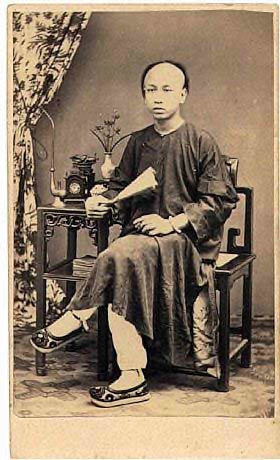
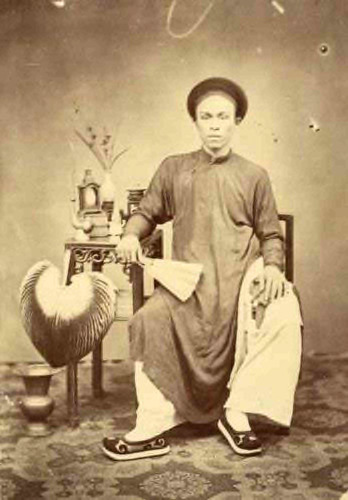
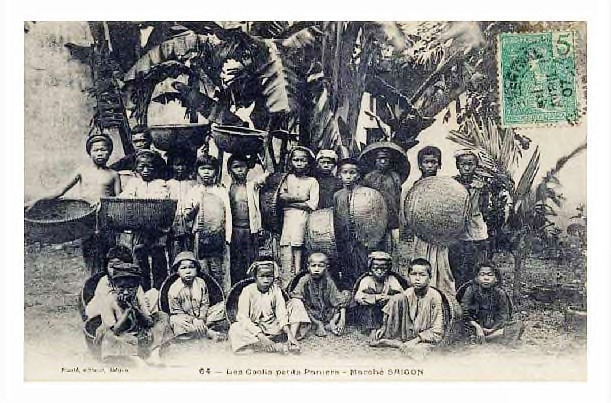
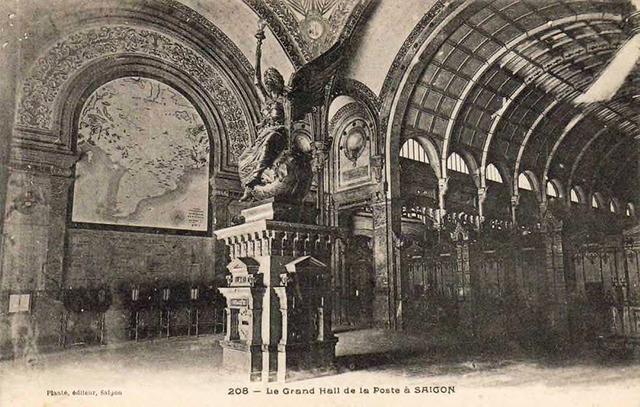
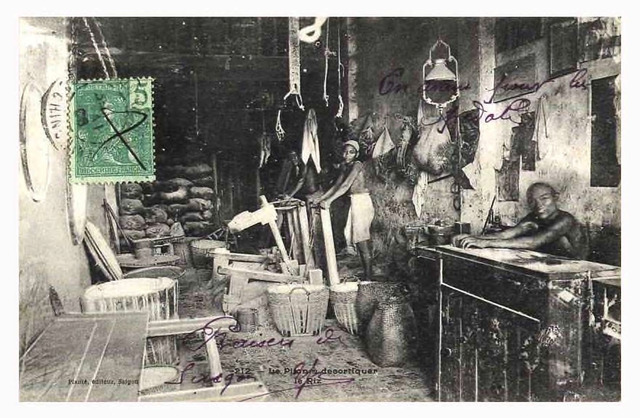
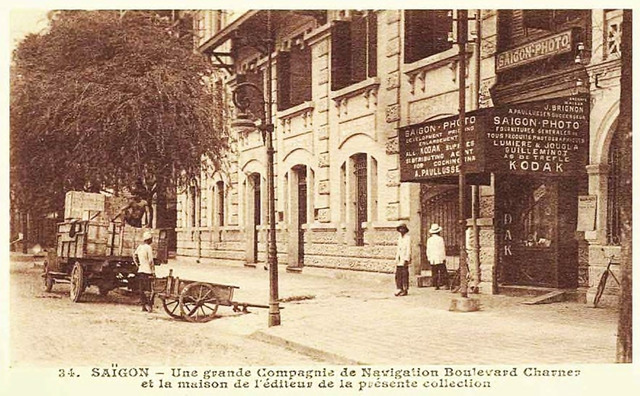
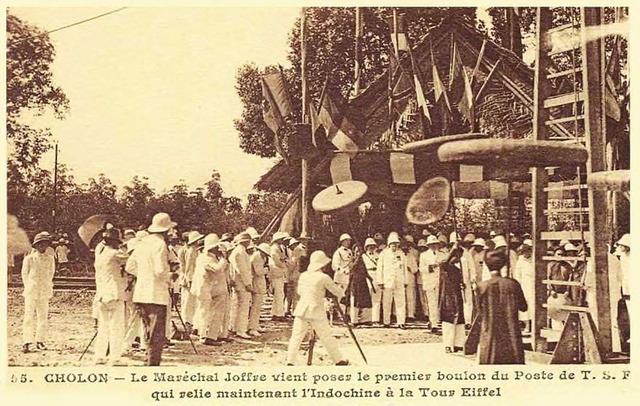
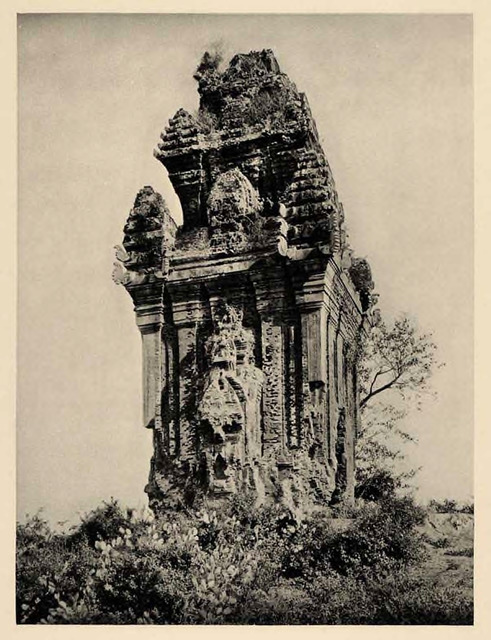
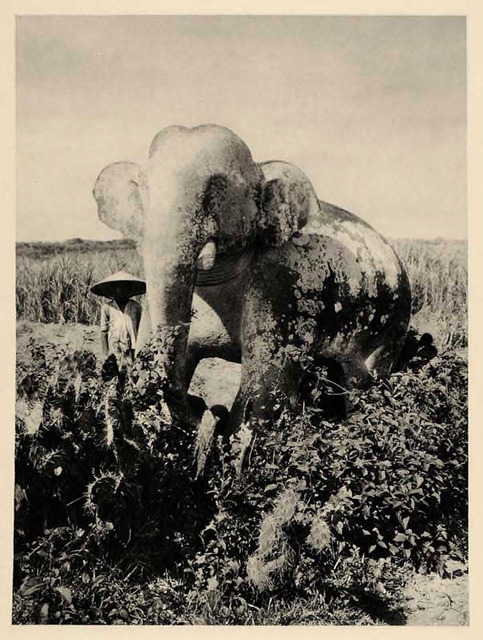
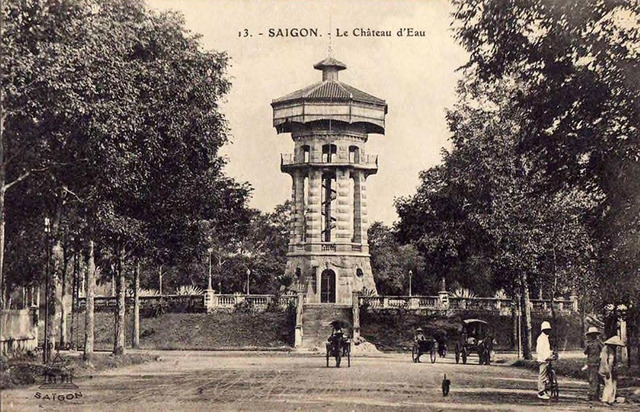
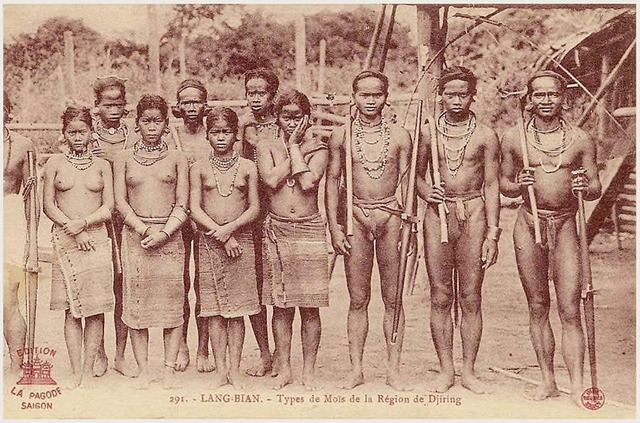
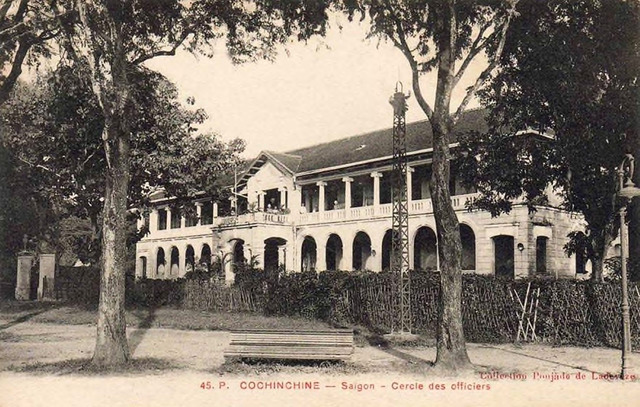
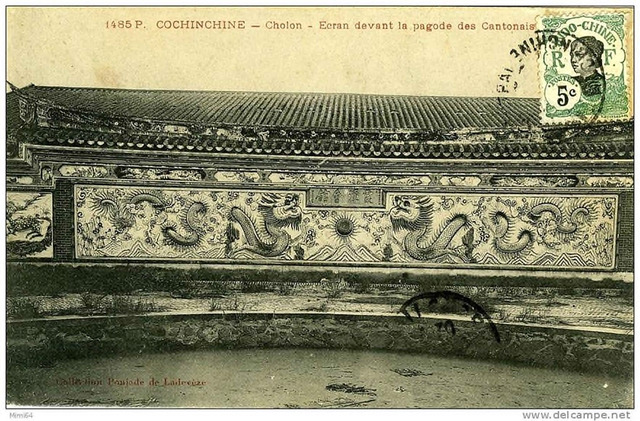
Nhận xét
Đăng nhận xét